Phillips curve
description: economic model illustrating an inverse relationship between inflation and unemployment
73 results

The Great Demographic Reversal: Ageing Societies, Waning Inequality, and an Inflation Revival
by
Charles Goodhart
and
Manoj Pradhan
Published 8 Aug 2020
Pay-as-you-go system PBOC, committed to process of deleveraging PBoC intervene PBoC’s campaign Pearl River Delta PEMEX Pension benefits in Japan, degraded Pension benefits, need to fall for participation to rise Pension, generosity likely to fall Pension, pay-outs to failing managers Pension reform, in Germany Pensions Pensions, benefits of Pensions, funds Pensions, generosity of Pensions, promised increases by populists Pensions, protection Pensions, raising Pensions, rising public expenditures on Pension system Pension system unsustainable, German People’s Bank of China (PBoC) Permanent Normal Trade Relations (PNTR) Personal savings, insufficient Personal, savings, prime period for being reduced Peru Petrobras Petro-currency countries Petrol/gasoline, tax rate on Phelps, E.S. Philippines Philippon, T. Phillips, A.W. Phillips curve Phillips curve, flat in Japan Phillips curve, historical development of Phillips curve, horizontal? Phillips curve, in Japan Phillips curve, long-run Phillips curve, long-term, vertical at NRU Phillips curve, recently horizontal Phillips curve, short-run Phillips curve, short-term, downwards sloping Phillips curve analysis Physicians Piao, S. Pierce, J.R. Piketty, T. Piton, S. Plaza Accord, 1985 Poland Polders, Dutch Political backlash Political tensions, national and regional Polito, V.
…
The assessment was that the long-term Phillips curve would be roughly vertical 2 at the NRU. In the short-run, with expectations largely fixed, the Phillips curve would remain downwards sloping. But if the authorities tried to take persistent advantage of that, in order to lower unemployment below the NRU, the result could only be to cause an ever-increasing rate of inflation. This concept, of a vertical long-run Phillips curve, was an important buttress for the subsequent move to Central Bank independence, with a mandate to concentrate on price stability via an inflation target. With such a Phillips curve, Central Bank measures to maintain price stability would not of themselves affect longer-run employment, growth or productivity, which were (in the long term) determined by supply-side factors, not by monetary, short-term demand-side policies.3 Thus, concentration on the control of inflation, via monetary policies, would be of itself beneficial, with no offsetting disadvantages.
…
Expectations are all that matter; iii.Successful monetary policies; iv.A changing structure of employment; v.Growing weight on global factors; vi.A shifting NRU. 8.2 A Horizontal Phillips Curve? 8.2.1 The Phillips Curve Is Dead It is now quite common to hear it stated that the Phillips curve is dead, and that our economies are settled into a rut with nominal wages growth of around 2–3%, real output growing at about 1% and inflation at 1–2%; in other words extrapolating the recent past into the indefinite future. Such extrapolation is without any theoretical basis. Moreover, the Phillips curve cannot have disappeared, since it just reflects the balance of the demand and supply of labour.
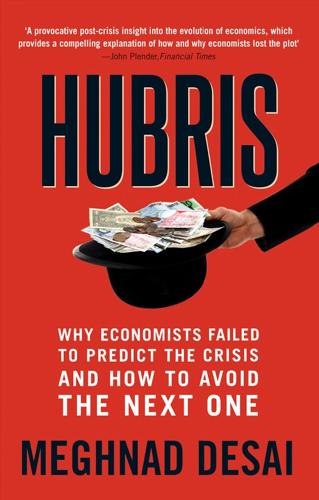
Hubris: Why Economists Failed to Predict the Crisis and How to Avoid the Next One
by
Meghnad Desai
Published 15 Feb 2015
Thus the level of unemployment was now determined independently of the rate of rise in money wages, that is, the variable which was of interest in the Phillips curve. The equilibrium natural rate of unemployment was determined outside the space of the Phillips curve. The natural rate was given by the summing of many micro markets and independent of the aggregate money wage. Thus any rate of money wage could be associated with it depending on the rate of inflation. The “true” Phillips curve was thus vertical; with no trade-off between inflation and unemployment (see Figure 7).5 Lucas’s idea of a vertical Phillips curve implied that inflation was unconnected to the state of the labor market.
…
Office: sales.press@yale.edu www.yalebooks.com Europe Office: sales@yaleup.co.uk www.yalebooks.co.uk Typeset in Arno Pro by IDSUK (DataConnection) Ltd Printed in Great Britain by TJ International Ltd, Padstow, Cornwall Library of Congress Control Number: 2015933801 ISBN 978-0-300-21354-6 A catalogue record for this book is available from the British Library. 10 9 8 7 6 5 4 3 2 1 CONTENTS List of Figures Preface Acknowledgements Introduction: Unraveling the Threads Part I 1 The Building Blocks 2 Cycles for the Curious 3 New Tools for a New Profession Part II 4 Causing a Stir 5 Declining Fortunes Part III 6 The New Globalization 7 The Search for an Answer Notes Bibliography Index FIGURES 1Marshall’s Cross 2Keynes’s aggregate demand and aggregate supply curves 3Hicks’s version of Keynes 4The Phillips curve 5Friedman’s version of the Phillips curve 6The Goodwin cycle 7Lucas’s version of the Phillips curve 8New classical aggregate demand and aggregate supply PREFACE In July 2007, I was invited by the Ministry of External Affairs, Government of India to give a talk to a group of Foreign Services Officers on the prospects for the global economy.
…
The interwar period had witnessed levels of unemployment that were unprecedented by pre–1914 standards, and post–1945 there was little variation in the level of unemployment as governments were wedded to a Keynesian policy. Researchers in the UK and US took up the task of estimating the “Phillips curve” using contemporary data. Paul Samuelson and his MIT colleague Robert Solow, two of the foremost US economists, presented a paper entitled “Analytical Aspects of an Anti-Inflation Policy” before the American Economic Association Conference in 1959.16 This was perceived as an official seal of approval to the Phillips curve as a policy tool. Figure 4 The Phillips curve Phillips had provided Keynesians with the answer to what caused prices to rise: inflation. Persistently high levels of employment led to sustained money wage rises, and hence, by implication, via unit labor costs, price rises.
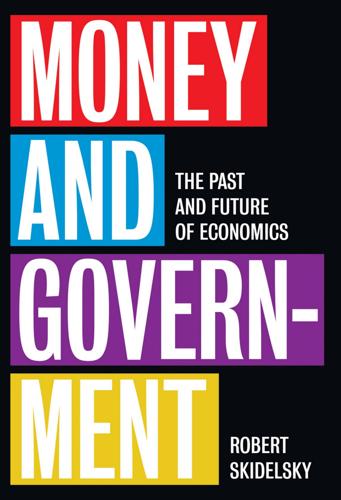
Money and Government: The Past and Future of Economics
by
Robert Skidelsky
Published 13 Nov 2018
F., 171, 208 Napoleonic wars, 43, 45–8, 80, 81, 84 national debt and 2007–8 crash, 76, 217–18, 219–20, 223–4, 224, 225–36, 237 British experience (1692–2012), 77 British long-term securities, 43 ‘burden on future generations’ fallacy, 236 bust at end of Lawson boom, 193 in eighteenth-century Britain, 80–81 four big spikes (since 1815), 84 and ‘Geddes Axe’ (1920s), 108 Alexander Hamilton on, 92 international bond markets, 90–92, 235 in Keynesian era, 156, 159–60, 161 Merkel’s ‘Swabian housewife’, 236 and modern tax systems, 32 monetary financing of deficits, 246–7, 285 during Napoleonic wars, 45–8 nineteenth-century money lenders, 90–91, 332 ‘off-budget’ accounting, 108–9 and PFI, 222–3 post-crash deficit, 226–33, 229, 237–9, 328, 352 public sector net borrowing (PSNB), 185, 227–8, 237, 238 Reagan’s budget deficits, 186, 190–91 recession of early 1980s, 186–7, 191 sinking fund, 83, 84, 85, 106, 108, 112, 114, 355 Sinking Fund Act (1875), 114 Smith and Ricardo’s view, 81–2, 83–4, 109, 110 ‘structural’ or ‘cyclically-adjusted’ deficit, 237–41, 238 US in 1950s/60s, 159–60, 161 Victorian fiscal constitution, 85–8, 86 and warfare, 83 483 i n de x nationalism, 17, 92, 95, 351, 371–3, 375 nationalization, 15–16, 142, 158 during 2008 crisis, 217 Labour’s renationalization proposals, 356 naval power, 78, 79–80, 87 Navigation Acts, British, 78 neo-classical economics tradition, xviii and 2008 collapse, 310–16, 328 comparisons with Keynesian view, 204, 204 and deregulation of banking, 310–11 distribution in perfect markets of, 292 formula for multiplier, 134–6 and Friedman, 177–83 and growth in inequality, 245–6 in Hutchison’s continua, 349 and Keynes, 122–3, 128 Keynesian synthesis, 172, 173–4, 201–2 microeconomics of Walras, 10, 173, 181, 385 model of rationality, 120 ‘natural’ rate of unemployment, 2, 163, 195, 197, 208, 232–3 and New Consensus, 199 and ‘optimal’ rate of investment, 368 pivotal role of banks ignored, 311 Solow growth model, 293 theoretical abolition of Keynesianism, 201 wage-adjustment story, 107, 108, 115, 121–2, 123, 128, 130, 132, 172 see also classical economics tradition; New Classical economics neo-liberal ideology ‘anti-state’ deception of, 93 capture of politics by, 6, 16–17, 292 and Eurozone constitution, 274 and Eurozone design flaw, 376, 377 implosion of growth model, 305 need for jettisoning of, 351, 367 term coined by Rustow (1938), 175 totalitarianism as original target, 175–6 as unchallenged since Cold War, 374 Netherlands, 78 New Classical economics and 2008 collapse, 2–3, 5 DSGE modelling, 196, 211–12 and erroneous austerity arguments, 232–4 and growth in inequality, 4 inflation targeting, 2 and microeconomics of Walras, 10 ‘natural’ rate of unemployment, 2, 195, 197, 208, 232–3 New Classical economics – (c0nt.) and neo-liberal capture of politics, 6, 16–17 and policies of austerity, 3 pre-crash models/mindset of 2000s, 212–13, 221, 229–35, 310–16 REH as analytic core of, 194–7, 385–6 synthesis with New Keynesians, 195–7, 199–201, 202 and unimpeded financial markets, 5, 6–7 unrealism of assumptions, 200, 310–16, 321–2 victory of in 1970s, 16–17 New Consensus, 9, 196–8, 202 based on supply not demand, 200 Brown constitution, 221–3 main features of, 199–201 primacy of monetary policy, 200–201, 212 ‘Washington consensus’, 198 484 i n de x New Keynesianism, 195–7, 199, 200, 201, 202, 212, 358 Brown constitution, 221–3, 227 and inflation targeting, 196, 251 ‘new stagnation’ theorists, 151 New Zealand, 188 Newton, Isaac, 42, 43, 47–8 Nielsen, Robert, 389 Niemeyer, Sir Otto, 108 Nixon, Richard, 153, 162 Norman, George, 49 Norman, Montagu, 115 North, Douglass, 198–9 Northern Rock, 317, 319*, 362 Obama, Barack, 225, 241–2, 274 O’Brien, Denis, 78 Office for Budgetary Responsibility (OBR), 228, 229–30, 237 oil prices, 271, 272 oil price shock (1973–4), 166–7, 189, 190 price spike (1980–82), 189, 190 OPEC surpluses, 308, 332 Orbán, Viktor, 373 Osborne, George, 114, 227–8, 229, 231, 233 and cost of austerity, 243–4, 244, 245 crucial mistake in austerity policy, 229–30 ‘deficit’ obsession of, 237 and Reinhart-Rogoff work, 232 and ‘structural’ deficit, 237–9 output gaps, 144, 197, 212–13, 229, 235, 237, 258, 286 ‘over-consumption’ theory, Austrian, 296 Overstone, Lord, 49 Palley, Thomas, 302–3, 304, 305 Papandreou (Greek Prime Minister), 324 Pareto-efficiency, 290, 291 Paulson, Henry, 217 Peel, Robert, 47–8, 86 Péreire brothers, 91 Pettifor, Ann, 246, 309 Pettis, Michael, 339 Petty, William, 28 Phillips, A. V., 144–5, 147 Phillips Curve, 144–5, 147, 162, 163, 205, 205–6 collapse of in 1970s, 169, 180 Friedman’s expectations-augmented, 180–81, 206–8, 207 New-Keynesian, 212 Sargent-Lucas (rational expectations), 208–11, 210 short-run, 38, 194, 206–8 see also inflation: Phillips Curve; interest rates: and Phillips curve; unemployment: Phillips Curve Pigou, Arthur, 109, 290–91 Piketty, Thomas, Capital in the Twenty-First Century (2013), 289, 298–9, 301–3 Pitt, William (the younger), 45 Polanyi, Karl, xviii, xix, 373–4, 387 political ideology assault on Piketty’s framework, 302–3 and economic theory, 1, 3, 6, 12, 93, 176–84, 202–3, 245–6, 258, 286–7, 292, 354 and hostility to government, 1, 3, 6, 10, 93, 202–3, 258, 286–7, 292, 347, 354, 385–6 nationalist–globalist split, 371–3 and research agenda, 12 rise of identity politics, 372–3, 384 and structure of power, 6–7, 12, 13–14 Portugal, 78, 242, 341, 365 485 i n de x prices and incomes’ policies, 16, 147, 150, 151, 164, 167, 169 Heath’s statutory policy, 167–8 Samuelson on, 171 Prisoner’s Dilemma (game), 389 Private Finance Initiative (PFI), 222–3 privatizing of state assets, 193 protectionism, xviii, 13, 79 Bismarck’s Germany, 89 Compensated Free Trade (CFT) strategy, 381 cultural diversity argument, 379 definition of, 377 Alexander Hamilton, 88, 90 health and safety standards, 380 Import Duties Act (1932), 113 in late nineteenth-century, 59 List’s ‘infant industry’ argument, 88–9, 90, 378 New or Strategic Trade Theory, 378 nineteenth-century USA, 89–90 Nixon’s import controls (1971), 153, 165 pressure for as growing, 380 seven main arguments for, 378–9 ‘strategic industry’ argument, 379 Trump’s tariffs, 373–2, 379, 381 Prussia, 90–91, 92 psychology, 24, 27, 117, 119–21, 199, 286–7, 292, 297, 355, 388–90 ‘public choice’ theory, 198–9 public investment in ancient Egypt, 26, 127 Brown constitution, 221–2 and classical economics, 172, 175 Conservative cuts in 1980s, 192, 193 and constraints of gold standard, 103 efficiency issues at full employment, 236 growth after W W1, 106–7 independent state investment banks, 354, 355–6 Keynes as advocate of, 109, 111, 116–17, 126–7, 130, 297, 352–3 in Keynesian ‘golden age’, 140, 142, 143, 144, 149–50, 153, 156, 157 Krugman on, 370 Lloyd George as advocate of, 107–8, 109–11, 113, 116–17 market mechanisms introduced, 197 minority Labour government (1929–31), 111–12 in new macroeconomic constitution, 352–7 in nineteenth-century Prussia, 92 Osborne’s cuts, 227–8, 231, 245 PFI, 222–3 programmes in 1930s US and Germany, 129–30 public works during recessions, 355 QE seen as preferable to, 258 share of total investment in U K, 354, 354 Smith’s public goods argument, 82, 93, 123, 352, 353, 356 U K spending (1950–2000), 157 U K spending (1997–2010), 223 U K spending as proportion of GDP (1692–2012), 77 in Victorian Britain, 86–7 quantitative easing (QE), 10–11, 116, 179, 226, 233, 242, 248–9, 254–8 assessment of, 263–77, 264, 267, 270 bank lending channel, 259–60, 260, 265–6, 266 by Bank of England, 254, 257, 259–62, 263–73, 267, 274, 275–7, 276 486 i n de x distributional effects, 248, 271–3, 272, 279, 284, 305 effect on output and unemployment, 269–70, 270 in the Eurozone, 273–4 as failure judged by its own |aims, 277–9 and inflation, 254, 258, 261, 262–3, 270–71, 271, 272, 277 portfolio-rebalancing concept, 260, 260–62, 263–5 signalling channel, 261–3, 267–8 theoretical basis of, 254–6, 258–9 transmission channels, 259–68, 260, 267, 283–4 in USA, 256–7, 273–4 Quantity Theory of Money (QTM) and 2008 crash, 256, 311 and the business cycle, 65–6, 67–70 ‘Cambridge’ equation, 63, 64, 65 and Congdon, 279–80, 282, 283 control of narrowly defined monetary base, 46 equation of exchange, 62–4, 71–2, 283, 284, 287 Fisher’s model, 61, 62–7, 71–2, 258, 278–9 Friedman’s restatement of, 178–9, 182, 183, 194 in Keynesian economics, 102–3, 125, 177 and monetarism, 178–9, 182, 183, 185, 192, 282 monetary reformers (first third of twentieth-century), 37, 44, 60–72, 99–106, 116, 124, 125, 129, 177–8, 200, 277, 280 muddled nature of, 60–61 no ‘demand for money’ in, 35 origins of, 32–3 as palpably untrue in short-run, 71, 282 role of central banks, 61 short-run and long-run effects, 64, 282 as ‘supply of money’ story, 34 transmission mechanism, 64, 146, 277–9, 283–4 two main versions of, 61–72 and uncertainty, 65 Wicksell’s credit money version, 67–70, 102–3, 278 Quarterly Journal of Economics, 120 Queen Elizabeth II, 4 Radcliffe Report (1959), 146 Raghuram, Rajan, 340 railway speculation, 49, 91 ‘rational expectations hypothesis’ (REH), 194–7, 202, 208, 385–6 anticipated by Fisher, 66 and behavioural economics, 389 conceit of, 387 ‘Efficient Market Hypothesis’ (EMH), 311–13, 321–2, 328, 388 and erroneous austerity arguments, 230–31, 232–3 and Friedman’s adaptive expectations, 208–9, 210 and heuristics, 196 Lucasian Phillips Curve, 208–11, 210 and monetarism, 186, 194 ‘public choice’ theory, 198–9 Volcker on, 307 Rawlsian political theory, 292 Reagan, Ronald, 6, 181, 186, 190–91, 292 Real Business Cycle (RBC) theory, 195, 196, 197, 211, 350 real estate, urban, 301 Reinhart, Carmen, 232 religion, 30, 31, 74 rent-seeking, 16, 30–31, 288 ‘Representative Agent’ device, 292 487 i n de x ResPublica, 365–6 revolutionary period in Europe (1848–9), 48 Ricardo, David, xviii, 28, 38, 40, 47, 74, 85, 114, 177 comparative advantage doctrine, 79, 88, 378, 379, 379 The High Price of Bullion (1810), 45–6, 47–8 and ‘limits of nature’, 369 and ‘nativist’ tradition, 379 and real bills doctrine, 46–7 and state expenditure, 73, 83–4, 109, 110, 286, 352 theory of rent, 288, 295 vice of abstraction from reality, 48–9, 385 Roberts, Katie, 239 Robertson, Dennis, 71 Rodrik, Dani, 375 Rogoff, Kenneth, 232 Roosevelt’s New Deal, 16, 129–30 Rostow, Walt, 199 Rothschilds, 90–91, 332, 342 Roubini, Nouriel, 225 Rougier, Louis, 174–5 Royal Bank of Scotland (RBS), 223, 319*, 364 Russia, 217 Rustow, Alexander, 175 Samuelson, Paul, 14, 24, 143–4, 148, 173–4, 202, 292 Sargent, Thomas, 208, 210, 211 Saul, John Ralston, 17 Say, J.
…
The discomfort index in the OECD, 1959–1976 163 16. UK monetary policy and inflation, 1970–2009 189 17. Oil prices and UK CPI inflation, 1970–1985 189 18. The Laffer curve 191 19. IS-LM model 203 20. Keynesian and neo-classical views of the economy 204 21. The Phillips Curve, 1948–1957 205 22. Expectations-augmented Phillips Curve 207 23. The Sargent-Lucas Phillips Curve 210 xiii F ig u r e s 24. Output growth in the advanced economies during the Great Moderation 215 25. CPI inflation in the advanced economies during the Great Moderation 216 26. Comparing the effects of the 1929 and 2008 crash 218 27.
…
Keynesian and neo-classical views of the economy LM LM IS IS Aggregate output 204 Aggregate output t h e t h e ory a n d p r ac t ic e of mon e ta r i sm A pp e n di x 7.2: T h e Mode l l i ng of E x p e c tat ions The Keynesian Phillips Curve Friedman’s Adaptive Expectations The Philips Curve failed altogether to distinguish between nominal wages and real wages. In the Phillips Curve world, all agents anticipated that nominal prices would be stable, whatever happened to actual prices and wages. Take the following simple version of adaptive expectations: ( ) Et [ Pt +1] = Et −1 ⎡⎣[ Pt ]⎤⎦ + λ Pt − Et −1[ Pt ] ;0 < λ < 1 Figure 21. The Phillips Curve, 1948–195762 11 51 Rate of change of money wage rates, % per year 10 Curve fitted to 1861–1913 data 9 8 56 7 55 52 6 57 5 54 4 50 48 3 53 2 49 1 0 0 1 2 3 Unemployment, % 205 4 5 T h e R i s e , T r i u m p h a n d Fa l l of K e y n e s This says that agents learn from their past mistakes: Et[Pt + 1] shows people’s current expectations (in period t) for inflation in the next period (t+1); inflation in the current period is shown by Pt; and Et − 1[Pt] is what people expected current inflation to be in the last period (t − 1).

Animal Spirits: How Human Psychology Drives the Economy, and Why It Matters for Global Capitalism
by
George A. Akerlof
and
Robert J. Shiller
Published 1 Jan 2009
If inflationary expectations are formed as a moving average of recent past inflation, estimates of Phillips curves should find that the coefficients on lagged inflation sum to one. Many estimates of Phillips curves fail to reject that this sum is equal to one. Given the importance of such findings, it is remarkable that their robustness to specifications of time period, data, and exact specification of the Phillips curve have never been subjected to tough tests—even though everything else about the Phillips curve, including the natural rate of unemployment itself, is considered to be estimated with great imprecision.
…
Employment should be expanded until its costs, in terms of added inflation, just balanced the benefits. Since the trade-off between inflation and unemployment—the Phillips curve—showed inflation as escalating to high levels only at very low levels of unemployment, that meant that employment could be permanently high. These views were eventually challenged, especially by Milton Friedman, who argued that they were based on a view of the Phillips curve that was flawed by money illusion. In a proper Phillips curve, said Friedman, wages will shift with the expected rate of inflation. At a given level of unemployment, if both employers and employees expect inflation to be 3%, for example, rather than zero, wage increases will be exactly 3% higher.
…
Natural rate theory offered an explanation for this occurrence: It explained the rise in inflation as the result of the significant oil supply shock that had occurred at the time and also an increase in inflationary expectations, both of which had shifted the Phillips curve outward. It explained the rise in unemployment as the result of a decline in demand. Furthermore new econometric estimates of Phillips curves that were augmented to include adjustment for inflationary expectations seemed to show that Friedman’s theory closely fit the data. They failed to reject Friedman’s conjectured one-for-one effect of inflationary expectations on price setting and wage setting.8 But these estimates were also very imprecise; thus they also failed to reject economically significant differences from natural rate theory.9 But the standard treatment of the Phillips curve ignores this inconvenient truth.

Not Working: Where Have All the Good Jobs Gone?
by
David G. Blanchflower
Published 12 Apr 2021
As the U.S. economy approached full employment we would expect to see wage growth pick up faster than that.14 Ewald Nowotny, who sits on the Governing Council at the European Central Bank, put it punchily: “There’s a big international discussion about why wages react so slowly to downward changes in the unemployment rate—this is the famous Phillips curve problem. We had just recently a meeting at the Bank for International Settlements where Bill Dudley, the central-bank governor of New York, said that in the U.S. the Phillips curve now is ‘flat as Kansas.’”15 That is a bit of an exaggeration, but the Phillips curve is clearly flatter than it was post-recession compared with pre-recession. Figure 11.1. (A) U.S. hourly wage Phillips curve of production and non-supervisory workers, January 1998-December 2007 (B) U.S. hourly wage Phillips curve of production and non-supervisory workers, January 2011-October 2018.
…
External MPC member Silvana Tenreyro seems to not care much about data at all but assumes wages are going to pick up anyway: “Many commentators have recently argued that the Phillips curve is no longer apparent in the data…. My view is that these fears are largely misplaced…. Successful monetary policy will make the Phillips curve harder to identify in the data…. I am unconvinced by reports of the death of the Phillips curve, so I expect this to translate into a pickup in domestic cost pressures.”13 I see no ships. There had been a small pickup in settlements in 2018 reported by pay experts XpertHR.
…
That predicts that wage growth at the most recent underemployment rate of 2.8% for August 2018 would be y = +2.8374 - (.1176 * 2.8) = 2.5%. Using the lowest level of the underemployment rate of 1.9% that occurred in December 2004 predicts wage growth of only 2.6%. This seems the most appropriate way to model the post-recession Phillips curve given that the unemployment rate doesn’t explain wages post-2008 whereas the underemployment rate does. The UK Phillips curve has flattened. So, it looks awfully like the Phillips curve is shallower in the United States and the UK and likely elsewhere too. In a paper with my Dartmouth colleague Andy Levin (Blanchflower and Levin 2014), who was previously economic advisor to Janet Yellen and Ben Bernanke, we examined the impact of inactivity and underemployment on wages in the United States.
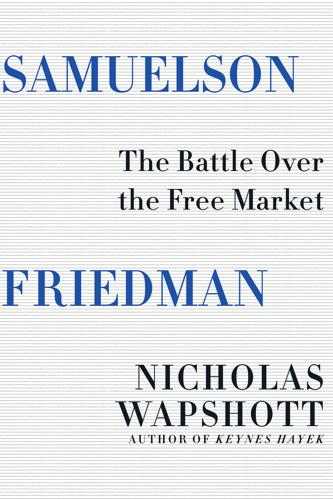
Samuelson Friedman: The Battle Over the Free Market
by
Nicholas Wapshott
Published 2 Aug 2021
“Participants in product and labor markets will learn to expect inflation,” wrote Phelps, and “as a consequence of their rational, anticipatory behavior, the Phillips Curve will gradually shift, greater inflation will result than before, and the pattern will repeat as expectations are continually revised upwards.” Phelps predicted that governments who relied on the Phillips Curve to maintain full employment were courting danger. Their actions would lead to a “wage/price spiral” followed by Weimar-like “hyper-inflation.” Some years later, having heard Friedman discuss his disproof of the Phillips Curve on a recording, Samuelson wrote that Friedman’s remarks critical of the efficacy of the Curve were old news and had all been covered in his Economics textbook.
…
“That is the most that we can ask from monetary policy at our present stage of knowledge.”43 As he was aware, Friedman’s attempt to disprove the soundness of the Phillips inflation/employment trade-off brought him into direct confrontation with Samuelson, who, with his MIT colleague Solow, had endorsed the validity of Phillips’s research44 and had dubbed the theory the Phillips Curve.45 Samuelson and Solow concluded that the jobs/prices exchange was so reliable that it offered a menu of options for political leaders. If they wished to keep unemployment at a certain low level, it would cost a certain level of inflation. Their endorsement of the Phillips Curve came to be seen as “the high watermark of the Keynesian conceit, the West’s counterpart to Soviet-style central planning: that the economy was a machine that could be fine-tuned by a wise, omniscient, and omnipotent government.”46 According to the Curve, the trade-off worked on a sliding scale.
…
The jobs/prices relationship was established by William Phillips,42 who, in “The Relation between Unemployment and the Rate of Change of Money Wage Rates in the United Kingdom, 1861–1957,” published in 1960, interpreted the views of Keynes on the subject after researching a hundred years of data on wage inflation and unemployment in Britain. In his lecture, Friedman offered his disproof of the Phillips Curve. While Phillips’s analysis was “deservedly celebrated as an important and original contribution,” it contained “a basic defect—the failure to distinguish between nominal wages and real wages, i.e., the amount of money that a worker was paid compared to the amount of goods and services those wages could buy when inflation was taken into account.”
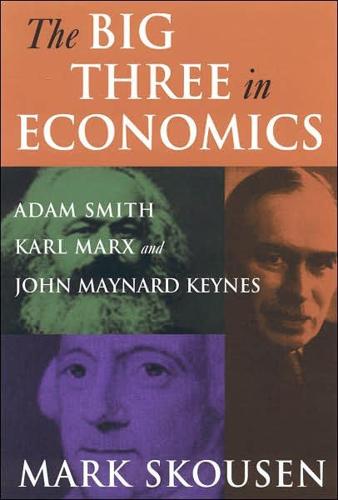
Big Three in Economics: Adam Smith, Karl Marx, and John Maynard Keynes
by
Mark Skousen
Published 22 Dec 2006
Many classical economists focused on how monetary inflation exacerbated the business cycle. Figure 6.6 The Phillips Curve Trade-Off Between Inflation and Full Employment TRADE-OFF BETWEEN INFLATION AND FULL EMPLOYMENT A P/P A WAN Source: Samuelson (1970: 810). Reprinted by permission of McGraw-Hill. prices skyrocketed while industrial nations roiled in recession. Under standard Keynesian analysis of aggregate demand, inflationary recession was not supposed to happen. Keynesians relied heavily on the Phillips curve, a concept popularized in the 1960s and based upon empirical studies on wage rates and unemployment conducted in Great Britain by economist A.W.
…
Supply shocks thus lead to a deterioration of all the major goals of macroeconomic policy" (Samuelson and Nordhaus 1998, 385). Alan Blinder, a leading Keynesian, also used AS-AD to explain the contortions in the traditional Phillips curve. According to Blinder, prior to the 1970s, fluctuations in aggregate demand had dominated the data. In the 1970s, however, aggregate supply dominated, and the result was stagflation. "That inflation and unemployment rose together following the OPEC shocks in 1973-74 and in 1979-80 in no ways contradicts a Phillips-curve trade-off' (Blinder 1987, 42). Thus, Keynesian economics recovered from the 1970s crises and AS-AD diagrams filled the pages of modern textbooks.
…
I tell you, in all candor, that that option no longer exists; and that insofar as it ever did exist, it only worked by injecting bigger doses ofcinflation into the economy followed by higher levels of unemployment at the next step. This is the history of the past twenty years" (Skousen 1992,12). In his Nobel lecture, Friedman warned that the Phillips curve had become positively inclined, with unemployment and inflation rising simultaneously. Out of this Phillips curve controversy rose a whole new "rational expectations" school, led by Robert Lucas, Jr., who won the Nobel Prize in 1995. Rational expectations undermine the theory that policymakers can fool the public into false expectations about inflation.

The End of Indexing: Six Structural Mega-Trends That Threaten Passive Investing
by
Niels Jensen
Published 25 Mar 2018
The flattening of the wage Phillips curve There is more than one answer to that question, but one factor has played a particularly dominant role. Since the Global Financial Crisis caused havoc, UK corporates have consistently generated more jobs than the BoE expected them to do; yet wage inflation has underperformed expectations. Not only have wages risen less than expected, but significantly so, which has led to a noteworthy flattening of the UK wage Phillips curve (exhibit 2.6),21 and the picture is largely the same in the US.22 Exhibit 2.6: UK wage Phillips curve over time Source: Haldane (2015).
…
As you can see, more recently, low unemployment has not had nearly the impact on wage inflation it had throughout the 1970s, 1980s and 1990s and, although the Phillips curve already began to flatten in the 2000s, it continues to do so. In part, that reflects weakening productivity growth, which continues to come in below BoE forecasts; however, wage growth has been surprisingly weak, even when adjusting for that. In chapter 5 I shall discuss this topic in much more detail. Suffice to say for now that the continued flattening of the UK wage Phillips curve is probably linked to labour’s shrinking share of national income. As labour has continued to lose out to capital, the growth rate of real wages has turned negative, and living standards have dropped for the median UK household.
…
However, in recent decades, that ratio has changed. Capital has taken more and more of national income to the detriment of labour, and it is not only in the UK that this has happened, but more about that in chapter 5. When will the wage Phillips curve revert to normal? Should labour begin to capture a rising share of national income, that would probably go a long way to normalise the wage Phillips curve, which is now largely flat in the UK. Taking another look at exhibit 2.6, back in the 1970–90s, once the unemployment rate dropped below 6–7%, it was quite normal for wage inflation to accelerate beyond 10%. Not anymore.
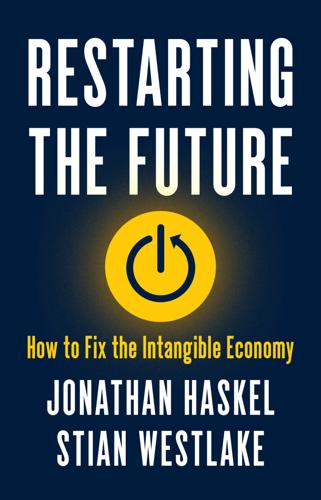
Restarting the Future: How to Fix the Intangible Economy
by
Jonathan Haskel
and
Stian Westlake
Published 4 Apr 2022
No matter the state of demand, inflation has been stubbornly low—most notably in Japan, where inflation has been very low for two decades. One way of interpreting this persistently low inflation is that the Phillips curve has become “flatter.” Indeed, this claim was central to the change in monetary policy framework announced by the US Federal Reserve in August 2020.34 A flatter Phillips curve means that for any particular rise in demand above capacity (or falling demand below capacity), the responsiveness of inflation has decreased greatly. The good news for monetary policy makers, then, is that inflation stays relatively close to the target no matter how far away the economy is from its capacity.
…
Gilson and Altman, 2010. 34. A recent review of the US position is Del Negro et al. (2020) and, for the UK position, Cunliffe (2017). Some dispute that the Phillips curve has become flatter (McLeay and Tenreyro 2020), but this issue has been widely discussed. 35. Subir Lall and Li Zeng (2020) find that rising investment in intangibles across countries is associated with a flattening aggregate supply curve, arguing that this trend is consistent with a flattening Phillips curve. 36. This section is based on Haskel (2020a). 37. Daly 2016; Rachel and Smith 2015. 38. See Kevin Daly “A Higher Global Risk Premium and the Fall in Equilibrium Real Interest Rates,” VoxEU, November 18, 2016, https://voxeu.org/article/higher-global-risk-premium-and-fall-equilibrium-real-interest-rates. 39.
…
New York: St. Martin’s Press. Cowen, Tyler, and Ben Southwood. 2019. “Is the Rate of Scientific Progress Slowing Down?” https://docs.google.com/document/d/1cEBsj18Y4NnVx5Qdu43cKEHMaVBODTTyfHBa8GIRSec/edit. Cunliffe, Jon. 2017. “The Phillips Curve: Lower, Flatter, or in Hiding?” Bank of England, November 14. https://www.bankofengland.co.uk/-/media/boe/files/speech/2017/the-phillips-curve-lower-flatter-or-in-hiding-speech-by-jon-cunliffe. Daly, Kevin. 2016. “A Higher Global Risk Premium and the Fall in Equilibrium Real Interest Rates.” VoxEU, November 18. https://voxeu.org/article/higher-global-risk-premium-and-fall-equilibrium-real-interest-rates.
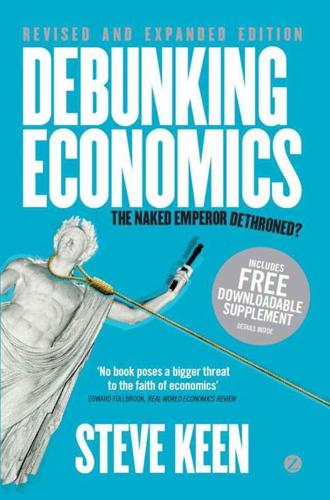
Debunking Economics - Revised, Expanded and Integrated Edition: The Naked Emperor Dethroned?
by
Steve Keen
Published 21 Sep 2011
Figure 9.11 illustrates both these modern simulation tools, and this difference between a linear and a nonlinear ‘Phillips Curve’ in Goodwin’s growth cycle model. One of these programs (Vissim) turns the six-step verbal description of Marx’s cycle model directly into a numerical simulation, using a linear ‘Phillips Curve.’ This model cycles as Marx expected, but it has extreme, high-frequency cycles in both employment and wages share. Embedded in the diagram is an otherwise identical model, which has a nonlinear Phillips Curve with the shape like that envisaged by Phillips. This has smaller, more realistic cycles and these have a lower frequency as well, closer to the actual frequency of the business cycle.
…
(‘Bill’) Phillips – was to persuade economists to abandon their static methods and embrace dynamic analysis. This is precisely what I am attempting to do now, so Phillips’s work – including the ‘Phillips Curve’ – deserves to be discussed here as a valiant but unsuccessful previous attempt to shake economists out of their static straitjackets. Addendum: Misunderstanding Bill Phillips, wages and ‘the Phillips Curve’ Bill Phillips the man was undoubtedly one of the most dynamic human beings of all time. Compared to that of Phillips, the lives of most economists – even non-neoclassical ones – are as pale as the theories that neoclassical economists have concocted about the world.
…
Lucas’s assault on IS-LM28 With Hicks’s IS-LM model accepted as providing a mathematical expression of Keynes, Lucas (Lucas 1972) focused on models that economists had constructed using Hicks’s model as a foundation, which concluded that macroeconomic policy could alter the level of economic activity. He began by conceding that most economists believed that the ‘Phillips Curve’ accurately described the ‘trade-off’ society faced between inflation and unemployment. He also conceded that the statistical evidence certainly showed a negative relationship between inflation and unemployment: when: ‘It is an observed fact that, in U.S. time series, inflation rates and unemployment are negatively correlated’ (ibid.: 50). 10.5 Unemployment-inflation data in the USA, 1960–70 The ‘Phillips Curve trade-off’ interpretation of these statistics turned an empirical regularity into a guide for policy.
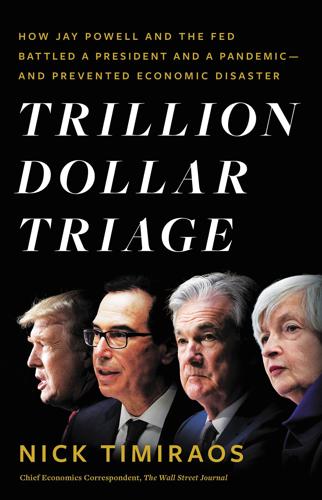
Trillion Dollar Triage: How Jay Powell and the Fed Battled a President and a Pandemic---And Prevented Economic Disaster
by
Nick Timiraos
Published 1 Mar 2022
“You’re sticking your nose in places that you have no business to be,” said Mick Mulvaney, a South Carolina Republican.24 Yellen was already preparing for the Fed to increase the fed-funds rate for the first time since it had been lowered to near zero in 2008. Her decision was—again—guided by the Phillips curve and the natural rate of employment, as well as by a growing group of colleagues who were pushing the Fed to get on with “normalizing” rates. Unemployment was at 5.5 percent and moving closer to officials’ comfort level of 5 percent. Inflation readings were held down by a drop in energy prices, but staff economists expected those effects to fade over time. According to the Phillips curve, a drop in labor-market slack, reflected in the dropping unemployment rate, should push up wages, which would in turn drive inflation upward.
…
During and after the 1990s, technology and globalization allowed advanced economies to sustain lower levels of unemployment without facing the same inflationary pressures they had in the 1960s. Fewer unionized workers meant wage contracts with automatic raises were less prevalent. Still, modified versions of the Phillips curve lived on at central banks. There was nothing better to use as a replacement. Powell’s speech reflected a Fed that was reaching the brink of a paradigm shift. A couple of Powell’s colleagues on the Federal Open Market Committee had grown even more skeptical of the Phillips curve and thus even more hesitant to step on the brakes. “We are too focused on the unemployment rate number,” said Minneapolis Fed President Neel Kashkari, who had got his start in public service managing Hank Paulson’s $700 billion bank bailout in 2008 before an ill-starred bid for governor of California as a Republican in 2014.2 Kashkari thought economists paid too much attention to this unreliable gauge.
…
But how much was the economy being propped up by Fed purchasing programs and ultralow interest rates? Since the 1960s, academics had adhered to prescriptions originating from the work of John Maynard Keynes, who in 1936 argued that increased deficits could boost growth. Economists had been guided by a concept referred to as the Phillips curve, named for New Zealand economist A. W. Phillips, who first advanced it in 1958 by studying British labor markets at the turn of the 19th century. The framework holds that inflation rates go up as unemployment moves down, and vice versa. The economists who populated Kennedy’s White House pushed for lower levels of unemployment because they mistakenly believed there was more slack in the labor market.

A Little History of Economics
by
Niall Kishtainy
Published 15 Jan 2017
Economic problems were brewing in Britain and America long before the end of the 1970s, though. Keynesian policies had been based on the Phillips curve, which showed that lower unemployment went with higher inflation, and higher unemployment went with lower inflation. Economists thought that by spending, governments could boost the economy and reduce unemployment while pushing inflation up a bit. During the 1960s inflation had been creeping up, and by the 1970s economists were scratching their heads because the high inflation came alongside persistent high unemployment, not the low levels that the Phillips curve predicted. ‘Stagflation’ became the name for an unhappy combination: high unemployment – economic ‘stagnation’ – and high inflation.
…
When unemployment was high, indicating a lot of unused resources in the economy, then inflation – how fast prices increase – tended to be low. When unemployment was low, inflation tended to be high. There was a curve linking the two extremes: a bit less unemployment came with a bit more inflation. The ‘Phillips curve’ became another part of the Keynesian system, and it provided important guidance for government policy. If the economy was depressed, governments could spend more, cutting unemployment at the cost of higher inflation. On the other hand, if the economy was running too fast so that inflation was high, then the government could reduce spending or raise taxes to slow it down.
…
‘Stagflation’ became the name for an unhappy combination: high unemployment – economic ‘stagnation’ – and high inflation. The Phillips curve was breaking down, and with it the foundation of Keynesian economics. Economists searched for explanations. Some thought that the inflation was caused by unusually high oil prices that increased firms’ costs and so the prices of their goods. Others blamed the labour unions (organisations that represent the workers) for demanding high wages. The high wages forced firms to charge higher prices. On the surface, the strikes did seem to have something to do with it. The government was trying to keep inflation down by encouraging the unions and employers to agree on modest wage rises.

What's Wrong With Economics: A Primer for the Perplexed
by
Robert Skidelsky
Published 3 Mar 2020
If the assumptions are unrealistic, the conclusions (predictions of the model) will not hold in the real world. So in his view the assumptions need to be realistic. A standard workhouse model in modern macroeconomics is the Phillips Curve. The statistician A.W. Phillips (1914–1975) noted (1958) an empirical relationship (‘correlation’) stretching from 1861 to 1957 between inflation and unemployment.6 This suggested that governments could ‘trade off’ a bit more inflation for a bit less unemployment, and vice versa. 4. The Method of Modelling. The problem with the original Phillips Curve was the disappearance of the postulated trade-off between inflation and unemployment in the later 1960s. To explain this ‘change in the facts’ a hypothesis was suggested: rational agents ‘learn from experience’.
…
They come to realise that the current inflation rate is the rate they can expect and adjust their wage-bargaining behaviour accordingly. This resulted in the ‘expectations augmented’ Phillips Curve, which predicts that over time, government attempts to reduce unemployment by allowing a bit more inflation lead only to accelerating inflation. Notice that in this model there is no attempt to investigate changes in institutional facts (in trade union organisation, historic levels of unemployment, among others) which might explain the breakdown of the original Phillips Curve: the single postulate of ‘utility maximising behaviour’ does all the work needed. A close inspection of this procedure points to some of the difficulties inherent in model construction. 1.
…
Principles of Economics, Mason, OH: Cengage Learning. McCloskey, Deirdre (1983). ‘The Rhetoric of Economics’, Journal of Economic Literature, Vol. 21 (2): 481–517. Mirowski, Philip (1989). More Heat than Light: Economics as Social Physics, Physics as Nature’s Economics, Cambridge: Cambridge University Press. Phelps, Edmund (1967). ‘Phillips Curves, Expectations of Inflation and Optimal Unemployment Over Time’, Economica, Vol. 34 (135): 254–81. Phillips, A.W. (1958). ‘The Relation Between Unemployment and the Rate of Change of Money Wage Rates in the United Kingdom, 1861–1957’, Economica, Vol. 25 (100): 283–99. Popper, Karl (2005 [1959]).

Shocks, Crises, and False Alarms: How to Assess True Macroeconomic Risk
by
Philipp Carlsson-Szlezak
and
Paul Swartz
Published 8 Jul 2024
However, as unemployment soared and then fell after the global financial crisis, there was only a weak impact on inflation in either direction. And in the postpandemic inflation scare, prices soared well before labor markets would have suggested they should—and inflation began to moderate even as the unemployment rate continued to fall. This is not to say the Phillips curve has no value—it does. Wages matter, particularly for services inflation. But the Phillips curve offers no predictive precision.4 There are additional approaches to understanding inflation, ranging from the more academic, such as the fiscal theory of the price level (that the credibility of fiscal policy underpins inflation); to the more political, such as greedflation (that corporate profits drive prices higher); to the more microeconomic, such as market concentration (that monopoly power is driving inflation).5 None will reveal with any precision the path of cyclical inflation.
…
If money grows faster than output, prices rise—however, this relies on an assumption that velocity is stable and not influenced by changes in money, which is a weak assumption (at best). 4. For an overview on the usefulness of the Phillips curve, see Peter Hooper, Frederic S. Mishkin, and Amir Sufi, “Prospects for Inflation in a High Pressure Economy: Is the Phillips Curve Dead or Is It Just Hibernating?” working paper 25792, National Bureau of Economic Research, Cambridge, May 2019, https://www.nber.org/papers/w25792. 5. See John Cochrane, The Fiscal Theory of the Price Level (Princeton, NJ: Princeton University Press, 2023).
…
Consider the monetarist mantra hammered into generations of economics students that “inflation is everywhere and always a monetary phenomenon.”9 As chapter 13 demonstrates, monetary forces are but a (valuable) piece of a complex topic. In the postpandemic inflation squeeze, it provided little insight into either structural-regime risks or cyclical inflation dynamics. The Phillips curve, another theory of inflation with a storied history, did not perform better.10 We must pursue coherent narrative that is ready to change, not static theory looking to reign. Discount point forecasts. That is, unless you know how to make and use them. There is a meaningful use case for economic forecasting where it’s understood to be a form of communication, a compressed version of today’s available information in the snapshot of a single set of numbers.11 But unless you operate in this world where forecasts are made and implemented accordingly, they will only deceive and frustrate you.
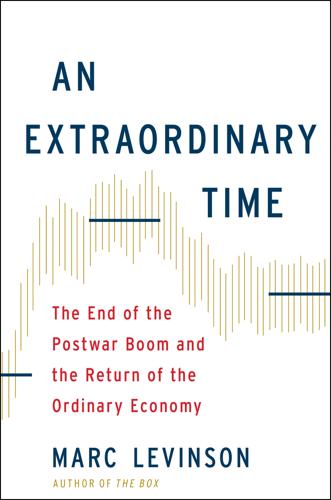
An Extraordinary Time: The End of the Postwar Boom and the Return of the Ordinary Economy
by
Marc Levinson
Published 31 Jul 2016
By 1972, the United States was the only major economy with an inflation rate below 5 percent. And this was without a drastic change in the price of a product fundamental to the world economy. Inflation had taken on a life of its own. The effort to combat inflation was complicated by the widespread belief in a construct called the Phillips Curve. Named for the New Zealand–born economist A. W. H. “Bill” Phillips, who first traced it, the Phillips Curve suggested that countries faced a basic economic trade-off: if they wanted to provide jobs for everyone, they would need to accept higher inflation, and if they wanted to lower the inflation rate they would need to accept higher unemployment not just temporarily, but over the long term.
…
Phillips based his curve solely on data from Great Britain, but the notion that a somewhat higher inflation rate was the permanent price of a full-employment economy quickly became the conventional wisdom among economists everywhere. The lesson the experts drew was that central banks could not go all-out against inflation; if they succeeded in bringing the inflation rate down, they could end up raising the unemployment rate for years to come.18 The Phillips Curve was not universally applauded. The American economists Edmund Phelps and Milton Friedman had launched separate attacks on Phillips’s theory a few years earlier, insisting that the inflation rate and the unemployment rate were related only in the short term. But their views were decidedly on the fringe.
…
One Fed economist predicted on December 12, “Income will be destroyed, business and consumer psychology will be dampened, and the upward momentum the economy still has at this point in the cycle may well be lost.” In West Germany, where inflation was at the highest rate since 1952, a secret economics ministry forecast estimated that two million jobs could vanish in 1974. Chancellor Willy Brandt was blunt, telling parliament: “Things are bad and could get worse.”23 THE PHILLIPS CURVE MADE NO ALLOWANCE FOR A COMBINATION of persistent inflation and economic stagnation. Inevitably, this unexpected threat took on a name of its own: stagflation. By driving up consumer prices while choking off economic growth, the oil price shock of 1973 threatened to bring stagflation even to countries renowned for both low unemployment and a commitment to low inflation, notably West Germany and Switzerland.
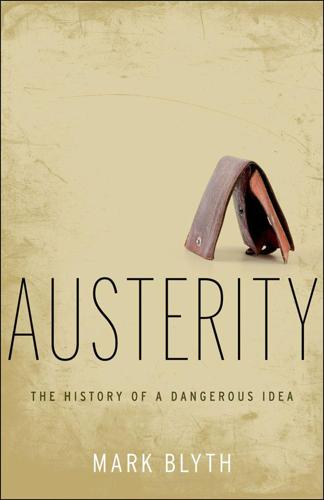
Austerity: The History of a Dangerous Idea
by
Mark Blyth
Published 24 Apr 2013
If VaR thinking made the crisis statistically impossible, our ideas about how markets work made it theoretically impossible, until it happened.29 Tearing up the Old Instruction Sheet The way we think about financial markets today is a consequence of the revolution in macroeconomic theory that occurred in the 1970s, when the old way of thinking about the world, Keynesian macroeconomics, was seen, by the standards of the day, to fail a critical real-world test. By the 1960s, Keynesianism had, at least in the minds of policy makers, been reduced to a statistical relationship called the Phillips curve (see figure 2.2). The Phillips curve purported to show that the relationship between the rate of change in prices and wages over a long period was statistically stable: a given rate of inflation (wages/prices) corresponded to a given level of employment. This implied that policy makers could “pick” a point on the curve that they liked (say, X percent inflation in a trade-off with Y percent unemployment) and get the economy to that point through active fiscal management.
…
This dealt a serious blow to the credibility of Keynesian ideas because it seemed to show that unemployment and inflation could coexist, which was extremely unlikely in Keynesian theory.30 It also created an opportunity for then-marginalized economists who had never liked the Keynesian instruction sheet because of its distributional implications and because of its focus on aggregates rather than individuals to write a new one. In short, the world was seen to be at variance with the instruction sheet, so the instruction sheet had to be rewritten. Figure 2.2 The Keynesian Phillips Curve The new instruction sheet, which came to be known as “neoclassical,” or more popularly, “neoliberal” economics, was quite technical, but basically it started from the premise that individuals were not the shortsighted, animal-sprit, driven businessmen lampooned by Keynes, but were instead supersmart processors of information.31 The new approach distrusted anything bigger than the individual, insisting that accounts of the behavior of aggregates such as “financial markets” had to be based in prior accounts of the behavior of the individuals (investors, firms, funds) that made them up, and that any theory of the behavior of aggregates must be generated from the two main assumptions of this new neoclassical economics, that individuals are self-interested agents who maximize the pursuit of those interests, and that markets clear.32 According to this new view, the Keynesian instruction sheet must, in some sense, see individuals as being deluded all the time by government policy; otherwise, they would see the policy coming and anticipate it in their decisions, thus cancelling out its effects on real variables—so-called expectations or “Ricardian equivalence” effects.
…
Once labor-market equilibrium is reestablished at this “natural rate” of unemployment, expectations will again adjust to the new, higher, underlying rate of inflation, and it can only continue to rise. With inflation rising and unemployment not improving, Keynesianism, according to monetarists, eventually eats itself. Friedman’s monetarism pushed hard against one of the key ideas of the postwar economic instruction sheet—the Phillips curve—that we also discussed in chapter 2.61 Crucial was his idea that there is a natural rate of unemployment, an evolutionary throwback to classical ideas about labor markets clearing at the equilibrium wage, with the amount of employment generated being a function of structural supply-side factors plus the degree of trade-union militancy.
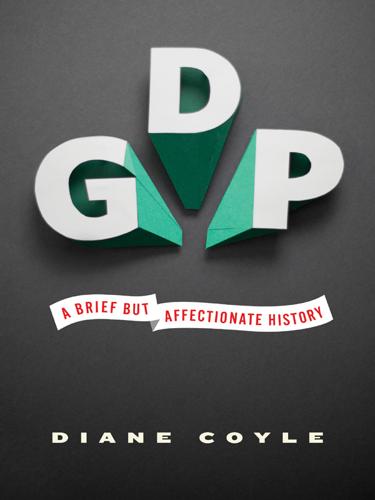
GDP: A Brief but Affectionate History
by
Diane Coyle
Published 23 Feb 2014
At 4 percent a year (average U.S. growth in the 1960s), GDP will double in 17 years; at 3 percent a year, it will double after 24 years; at 2 percent a year, it will double only after 35 years. So a one percentage point slowdown in average annual growth, as in the 1970s, will be felt quickly. The extraordinary turnaround in the economic situation in the Western democracies can be summed up by a relationship economists call the Phillips curve, after Bill Phillips, the economist who discovered it. In addition to building his famous machine, he noticed that, in the economic statistics for the United Kingdom for 1861 to 1957 there was a negative relationship between inflation and unemployment.5 This empirical fact turned out to hold for other countries, too.
…
Although voters don’t like inflation because it reduces their spending power, adding extra jobs at the cost of a small increase in the rate of inflation has obvious appeal. The trouble was that as soon as governments started to try to choose the point they preferred on this trade-off between unemployment and inflation, the trade-off got worse. By the end of the 1970s, economists had concluded that the only lasting effect of trying to move along the Phillips curve would be to increase inflation, while the unemployment rate would go back to where it had started. They concluded that there was a “natural” rate of unemployment that depended on what incentive firms had to hire extra workers.6 Trying to go below that by deficit spending would prove inflationary.
…
To improve growth and levels of income in a lasting way, the “supply side” of the economy needed to be more efficient, less restricted by unnecessary regulations. This menu of policy choices was mirrored by the development of a new consensus in economics, which also downplayed the scope for activist fiscal policy and instead emphasized the role of the central bank in providing monetary stability. The realization that the Phillips curve trade-off had gotten worse over time and the experience of stagflation both made it plain that economists needed to change their views about how the economy as a whole worked. Within a relatively short time, the polarization of views among economists that had marked the turbulent 1970s—between Keynesians and monetarists—gave way to a more or less monetarist consensus.
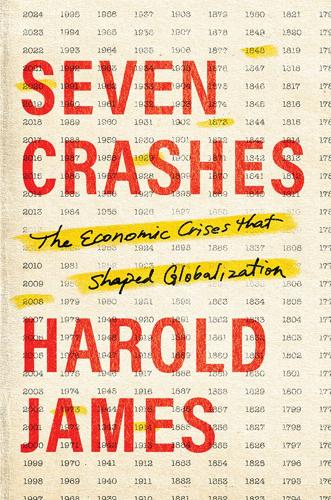
Seven Crashes: The Economic Crises That Shaped Globalization
by
Harold James
Published 15 Jan 2023
The overall conclusion has also been criticized as “ideologically loaded,” or a restatement of a conclusion that had already appeared in Friedman’s best-selling manifesto Capitalism and Freedom (1962): “The fact is that the Great Depression, like most other periods of severe unemployment, was produced by government mismanagement rather than by any inherent instability of the private economy.”91 And critics complained that the central thesis of the Monetary History was built on “pedestrian statistical techniques and historical analysis that had been dismissed as old-fashioned by some of the leading economists of their day.”92 Krugman indeed complained in his remarkable and offensive obituary that “over time Friedman’s presentation of the story grew cruder, not subtler, and eventually began to seem—there’s no other way to say this—intellectually dishonest.”93 There is an irony in the way that Friedman correctly attacked the empirical observations that produced the Phillips curve, arguing that they need not always hold, while developing a model based on a similar empirical relationship about income and money. Like the Phillips curve, it correctly described a reality of the 1950s and 1960s (and indeed in this case earlier); but like the Phillips curve, the relationship misbehaved in the 1970s and later. Friedman started his counterrevolutionary manifesto, which he delivered in London as the Harold Wincott Lecture, by claiming that Keynes would agree with him: “if Keynes were alive today he would no doubt be at the forefront of the counter-revolution.
…
It can make the market rate higher than the natural rate only by deflation.”76 At any moment of time, there is some level of unemployment which has the property that it is consistent with equilibrium in the structure of real wage rates.77 Monetary policy should not in consequence seek to alter the level of employment in terms of small-scale adjustments: “We simply do not know enough to be able to recognize minor disturbances when they occur or to be able to predict either what their effects will be with any precision or what monetary policy is required to offset their effects.”78 Friedman predicted that the Phillips curve that had appeared in the data throughout the 1950s and 1960s, in which rising prices reduced unemployment, would break down if policy-makers followed conventional Keynesian wisdom and started to exploit it.79 This part of Friedman’s analysis received considerable support in that the speech followed an independently derived argument about the long-run verticality of the Phillips curve, developed by Edmund Phelps, on the basis of an argument about the ignorance of both sides in the wage-determination process.80 Expectations were central to the Phelps argument, which amounted to an anticipation of many of the themes of the rational expectations revolution that followed in the 1970s.
…
An expanded manufacturing sector would lead to a self-sustaining virtuous cycle of higher rates of growth and hence also of higher wages.5 The influential economist Roy Harrod then drew the logical consequence that stronger demand growth might reduce (rather than increase) inflation.6 These optimistic expectations were severely disappointed. Previously, policy-makers had supposed there was a trade-off between inflation and growth, defined by a Phillips curve, the relationship identified by the New Zealand economist William Phillips: in the original version, the relationship was between wages and employment. High growth or rising employment would generate a shortage of workers and wage pressure that would be translated into rising prices. An economic shock would reduce the demand for employment and lead to a wage mitigation, and a slower pace of price increases.
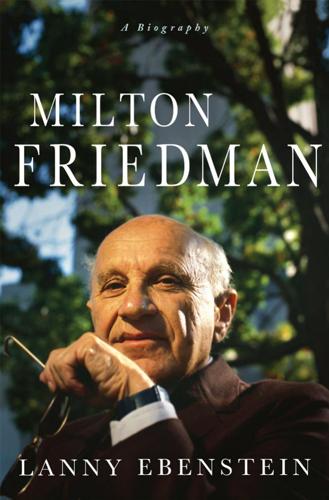
Milton Friedman: A Biography
by
Lanny Ebenstein
Published 23 Jan 2007
The address builds on his earlier work in monetary history and theory. In it he rebuts the notion of a “Phillips curve”—that there is a long-run trade-off between inflation and unemployment. In 1958 A. W. Phillips argued that the higher inflation is, the lower unemployment will be and that the lower inflation is, the higher unemployment will be. Keynesians seized on this purported trade-off to argue for interventionist and expansive monetary and fiscal policies. Inflation, from Phillips’s perspective, stimulates employment. Samuelson, for example, said in 1967 of the Phillips curve that it is “one of the most important concepts of our times.”18 Friedman argues against the existence of a long-run Phillips curve.
…
It is one of his major contributions to the academic discipline of economics as distinct from the realm of public policy. Others include his historical researches into relationships among money, prices, and economic activity; his restatement and extension of the quantity theory of money; his work in flexible international exchange rates; his concept of a natural rate of unemployment; his critique of a long-run Phillips curve; and his essay “The Methodology of Positive Economics.” Essentially, in A Theory of the Consumption Function, Friedman rebuts Keynes’s notion of a declining average propensity to consume as economies develop and societies become wealthier. Friedman’s approach in this work is to put hypotheses forward and to test them.
…
Samuelson, for example, said in 1967 of the Phillips curve that it is “one of the most important concepts of our times.”18 Friedman argues against the existence of a long-run Phillips curve. He agrees that, in the short run, unanticipated inflation can temporarily boost employment and output, but eventually the short run becomes the long run. If an economy has become used to inflation, then inflation will have all of its bad effects in distorting price signals (the relative change of prices in guiding production is lost in the cacophony of generally rising prices) and in discouraging saving. The only way to maintain the temporarily beneficial effects of inflation is for inflation to rise at increasing, unanticipated rates, which is unsustainable.
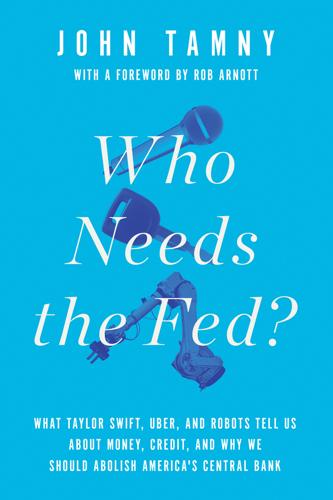
Who Needs the Fed?: What Taylor Swift, Uber, and Robots Tell Us About Money, Credit, and Why We Should Abolish America's Central Bank
by
John Tamny
Published 30 Apr 2016
The Fed very much stands by this theory. As David Altig, research director at the Atlanta Fed, told Leubsdorf, “We haven’t lost faith in the [Phillips curve] framework.”3 As Donald Kohn, former Fed vice chairman, stated in 2008, “A model in the Phillips curve tradition remains at the core of how most academic researchers and policymakers—including this one—think about fluctuations in inflation.”4 Fed Chairman Yellen certainly believes in the Phillips curve. Talking in February 2015 about what the Fed deems inflation, Yellen offered: “Provided that labor market conditions continue to improve,” the Fed will hike the fed funds rate when it’s “reasonably confident that inflation will move back over the medium term toward our 2% objective.”5 There’s clearly reason for skepticism about what the Fed deems the cause of inflation.
…
“The Usual Chinese Suspects,” editorial, Wall Street Journal, September 1, 2015. CHAPTER EIGHTEEN Epigraph: Quoted in Bartley, Seven Fat Years, 62. 1. Hayward, Age of Reagan: The Fall of the Old Liberal Order, 290. 2. Ben Leubsdorf, “The Fed Has a Theory, But the Proof Is Patchy,” Wall Street Journal, August 24, 2015. 3. Ibid. 4. Kohn quoted in John Tamny, “The Phillips Curve Is Dead, Except at the Fed,” RealClearMarkets.com, September 16, 2008. 5. Paul Davidson, “Yellen Plots Rate-Hike Road Map,” USA Today, February 25, 2015. 6. Bartley, Seven Fat Years, 51. 7. Karmin, Biography of the Dollar, 4. 8. Bartley, Seven Fat Years, 52. 9. Richard W. Nelson, “Why the Fed Needs to Get Off of the Dime,” Wall Street Journal, July 24, 2015.
…
P., 29–30, 33, 103 Morgan, Junius Spencer, 29–30 Morgan Stanley, 45, 123, 127, 130, 151 Morgenthau, Henry, 167, 168 mortgage-backed securities, 150–52 mortgage lending practices, 119–20, 127 Mundell, Robert, 155, 158 Nelson, Richard, 159–60 NetJets, 85–86, 98 NetQoS, 123–24 The New Tycoons (Kelly), 126 NeXT Computer, 30 Nikkei index, 152, 159 1984 Summer Olympics, 34 1989 (album), 10 Nixon, Richard, 69–70, 92, 116, 117, 169 Nixon’s Economy (Matusow), 169–70 Norman, Montagu, 167 Noyce, Richard, 31 Obama, Barack, 51, 61, 71, 72, 154, 171–72 Ohio State University, 17–18, 19 oil fracking boom, 66–67, 73–75 and global economy, 66–67, 74–75 gold standard and the price of oil, 68–72 Organization of the Petroleum Exporting Companies (OPEC), 68–69, 70 price declines and rising cost of credit, 146–48 O’Neill, Paul, 118 Oracle, 143 Pacific Research Institute, 53 Patriot Act, 119 Paul, Ron, 94 Paulson & Co., 44–45 Paulson, Henry, 172 Paulson, John, 44–46, 48, 120, 127 Payback (Fischel), 38 PayPal, 28 “peak oil,” 71 Pellegrini, Paolo, 120 Pelosi, Nancy, 51, 106, 128, 150 Phillipps, Cassandra, 27 Phillips, A. W., 156 Phillips curve, 156 Pipes, Sally, 53 political class, 51–52, 58–59 Ponnuru, Ramesh, 138–39 Popular Economics (Tamny), 3, 4, 48–49, 67, 81, 142, 143 price cutting, 73 private air transportation, 85–86, 98 private-sector investment, 78 production and money supply, 136 property development, 33, 35–37 quantitative easing (QE) program, 149–54, 172 RadioShack, 57 Rasmussen, Bill, 109 Reagan, Ronald, 49–50, 68–69, 71, 72, 171, 172 recessions, 142, 147, 153 recruiting of college athletes, 15–21 Reds (film), 23 Reid, Harry, 51 Reynolds International, 54 The Rise and Fall of Monetarism (Smith), 121 Rivals recruit rankings, 15–18, 19–20 the Roaring Twenties, 94–95 robots and job creation, 176–80 Rock, Arthur, 31 Romney, Mitt, 126 Roosevelt, Franklin D., 61, 142, 167–69 Rothbard, Murray, 89, 92 Rubio, Marco, 59 The Russians (Smith), 77 Ryan, Paul, 51, 150 Saban, Nick, 79, 129 Sampler, Jeffrey, 105 Sam’s Club, 105, 106–7 San Francisco 49ers, 17 Sarbanes-Oxley regulations, 119, 124 Sarkisian, Steve, 16, 20 saving money, 57–58, 77, 88, 112, 149, 176 Say’s Law, 94–95 Schlumberger, 73 Schumpeter, Joseph, 28, 123 Secrets of the Temple (Greider), 121 Securities and Exchange Commission (SEC), 38 Security Pacific Bank, 34–35, 101, 108, 129, 164–65 The Seven Fat Years (Bartley), 70, 157–58 Shampoo (film), 23 Shandling, Garry, 24 Shanghai, 138 Sharma, Ruchir, 151 She’s Gotta Have It (film), 109 Shlaes, Amity, 167–69 Shula, Mike, 79, 129 Shultz, George, 170 Silicon Valley, 27–32, 143 Smith, Adam, 65, 67, 77, 119, 140, 142–43 Smith, David, 121 Smith, Hedrick, 77 Smith, Robert H., 34–37, 108, 111, 129, 162, 164–65, 173 Smoot-Hawley Tariff, 142 Snow, John, 118 Solyndra, 59, 60 Soviet Union, 76–78, 80, 94 Splash (film), 22–23 Stanford University, 16–17 stimulus spending, 53, 141 student debt, 173–74 substitution effect and traditional banking alternatives, 105, 106–7 supply-side economics, 48–55, 79–80, 92–94, 141, 144 surge pricing, 12–14, 106–7, 165–66 Swanson, Bret, 143 Swift, Taylor, 9–12, 13, 162–63 Switzer, Barry, 18–19 tariffs, 3 taxes as barrier to economic growth and prosperity, 3 and Laffer curves, 50, 54–55 Smoot-Hawley Tariff, 142 and supply-side economics, 49–51, 79–80, 92–93, 141 technology innovation in Austin, Texas, 123–25 robots and job creation, 176–80 Ten Days That Shook the World (Reed), 23 Tennessee Valley Authority (TVA), Texas Instruments, 155 The Theory of Money and Credit (von Mises), 87 Thiel, Peter, 28–29, 59, 150, 168 This Time Is Different (Reinhart and Rogoff), 168 Thwaites, Thomas, 64–65 Timiraos, Nick, 147, 148 toasters, 64–65 Town & Country (film), 23–24, 28 Townsend, Robert, 109 Trammel, Joel, 123–25 Troubled Asset Relief Program (TARP), 172–73 Truffaut, François, 24 Trump, Donald, 33–37 The 21st Century Case for Gold (Gilder), 68 The Twilight of Sovereignty (Wriston), 109 2008 financial crisis, 106, 110 Uber and “easy credit,” 115–16 and the “sharing economy,” 57 and surge pricing, 12–14, 106–7, 165–66 Ueberroth, Peter, 34–35 unicorn companies, 28, 148 University of Michigan, 16–17, 18, 19, 20, 21, 79, 103, 127, 148 University of Southern California (USC), 18–20 University of Washington, 20 USAA, 108 U.S.
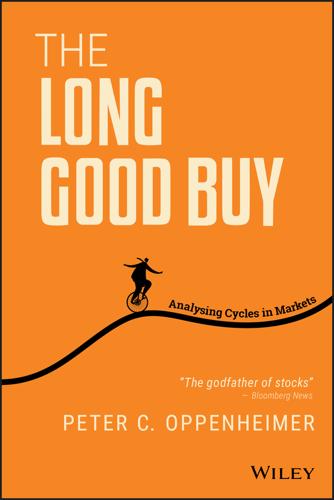
The Long Good Buy: Analysing Cycles in Markets
by
Peter Oppenheimer
Published 3 May 2020
In the past, labour market tightening often generated substantial and persistent inflationary pressure, causing central banks to raise interest rates sharply, thereby raising the risks of recession. But since the 2000s more effective forward guidance by central banks has contributed to lower and more stable inflation, alongside a flatter Phillips curve (the relationship between unemployment and inflation), resulting in much more stable inflation expectations.11 To some degree, the impact of QE has also been responsible.12 I discuss in more detail the impact of inflation expectations and ultra-low bond yields in chapter 10. A Downtrend in Global Growth Expectations Although interest rates and inflation expectations have fallen, there has also been a significant fall in long-term growth rates since the financial crisis.
…
The chart also shows that the 10-year annualised growth rate in revenues across the developed world has converged towards the levels that Japan has experienced since the collapse of its asset bubble in the late 1980s. Exhibit 9.9 Top-line growth has been falling along with declining nominal GDP (year-over-year sales growth (10-year rolling average), market except financials) SOURCE: Goldman Sachs Global Investment Research. The Fall in Unemployment and Rise in Employment Despite the changes in the Phillips curve relationships and generally slower economic growth, the labour market has been much stronger than most people expected in the aftermath of the financial crisis. The worry was that a period of low growth would result in very high unemployment and, although that was true in some of the most severely crisis-hit economies, particularly in southern Europe, this has not been the rule.
…
Available at https://www.imf.org/en/Publications/WP/Issues/2016/12/31/Financial-Cycles-What-How-When-24775 9 Romer and Romer, New evidence on the aftermath of financial crises in advanced countries. 10 Caballero, R. J., and Farhi, E. (2017). The safety trap. The Review of Economic Studies, 85(1), 223–274. 11 See Cunliffe, J. (2017). The Phillips curve: Lower, flatter or in hiding? Bank of England [online]. Available at https://www.bankofengland.co.uk/speech/2017/jon-cunliffe-speech-at-oxford-economics-society 12 Borio, C., Piti, D., and Juselius, M. (2013). Rethinking potential output: Embedding information about the financial cycle. BIS Working Papers No 404 [online].
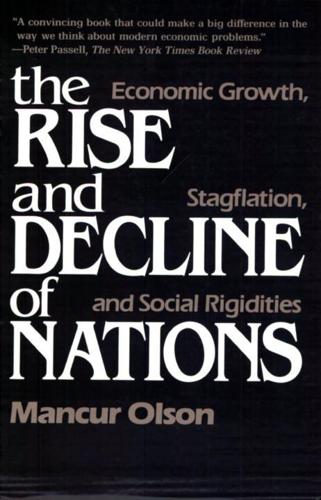
The Rise and Decline of Nations: Economic Growth, Stagflation, and Social Rigidities
by
Mancur Olson
Some Keynesian economists have tried to explain recent macroeconomic experience in Britain, the United States, and some other countries in terms of negatively sloped Phillips curves (observed tendencies for wage and price increases to vary inversely with the level of unemployment). There is no need to invoke the monetarist criticisms of the Phillips-curve concept to show that it is inadequate, for it is only a statistical finding (or a statistical finding for a certain period) in search of a theory. An explanation of stagflation is not an explanation at all unless it includes a general explanation of why a Phillips curve should have this or that slope, and why the curve shifts if it is alleged to shift. Any Phillips-curve relationship must be derived from the interests and constraints faced by individual decision-makers.
…
Any Phillips-curve relationship must be derived from the interests and constraints faced by individual decision-makers. The lack of an adequate explanation in Keynes of stagflation or Phillips curves-especially the tendency for short-run Phillips curves to move upward and become steeper over long periods of inflation-must have a lot to do with the apparent growth in skepticism about Keynesian economics in recent years. (Although he certainly exaggerated, Lord Balogh did not miss the direction of change when he lamented that "antiKeynesianism was the world's fastest-growth industry. ")`' "Implicit contracts" have also been brought to bear in efforts to explain the recent stagflation in ways that can be reconciled with Keynes.
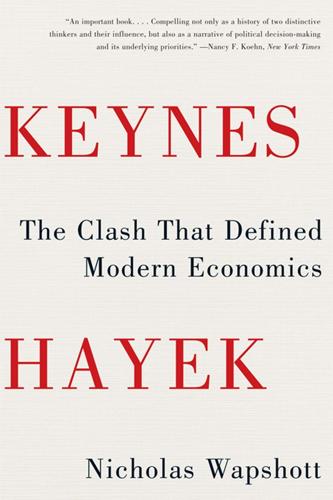
Keynes Hayek: The Clash That Defined Modern Economics
by
Nicholas Wapshott
Published 10 Oct 2011
Keynes’s protégé Roy Harrod and Harvard’s Evsey Domar56 had, in their “Harrod-Domar model,” built on Kahn’s multiplier theory to predict how tax cuts could lead to economic growth. And Heller himself, working with his colleague Robert Solow,57 took account of the work in 1958 of an LSE economics professor, the New Zealander William Phillips,58 who postulated in a graph dubbed the “Phillips curve” a trade-off between reducing unemployment and rising inflation. By formulating policy according to the Phillips curve, Heller believed he had found a way to provide full employment without provoking higher prices. JFK’s proposal for tax cuts languished in the Senate, but after his assassination in November 1963, the accidental president Lyndon Johnson vowed to continue his predecessor’s legacy in every particular.
…
“But it turns out it’s always much easier to get into something like that than to get out of it.”84 Any chance that Nixon would be the master of his economic destiny was delivered a mortal blow by a fourfold increase in oil prices imposed by the Arab oil cartel, the Organization of Petroleum Exporting Countries (OPEC), in 1973–74 to punish America for rearming Israel during the Yom Kippur War. The result was higher prices and the brakes being slammed on economic growth. Traditional tools such as the Phillips curve seemed no longer to apply. Low or no economic growth was accompanied by inflation in a combination hitherto thought impossible, dubbed “stagflation.”85 The Age of Keynes was in its death throes. The Age of Stagflation had arrived. Up against a weak opponent, George McGovern, Nixon walked to a landslide in the 1972 election.
…
But he conceded that a tightening of the money supply “will work against inflation, in its own grim fashion.”63 Walter Mondale, Reagan’s Democratic opponent in the 1984 presidential election, made “trickle down” a social class issue, scoffing that “the idea behind Reaganomics is this; a rising tide lifts all yachts.”64 While Volcker’s monetary squeeze led to a deep recession that lasted sixteen months in 1981–82, inflation fell dramatically, from 11.8 percent through 1981 to 3.7 percent in 1983. But the price was high. Unemployment rose to its highest level since the Great Depression. In 1980, Reagan inherited a jobless rate of 7.1 percent; by 1983 and 1984 it had reached 9.7 and 9.6 percent. The much derided Phillips curve, which appeared to have lost its relevance when stagflation struck in the mid-1970s, seemed to be back in business. By Laffer’s reckoning, Reagan’s tax cuts proved every bit as effective as the Kennedy tax cuts. In the four years after Kennedy’s cuts reduced the top rate from 90 percent to 70 percent, growth in real federal income tax revenue leapt from 2.1 percent in the previous four years to 8.6 percent.
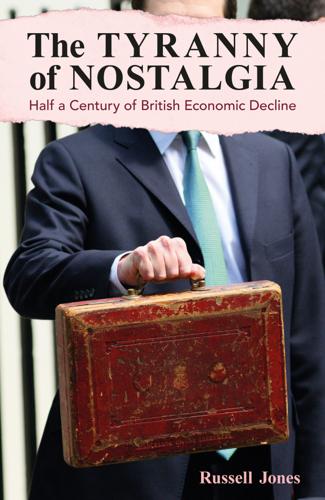
The Tyranny of Nostalgia: Half a Century of British Economic Decline
by
Russell Jones
Published 15 Jan 2023
We would be adrift. Perhaps, then, to reduce uncertainty to at least a sense of risk, we invent fetishes – dogmas – that focus our attention on one particular set of variables as the light under the proverbial drunk’s lamppost just as the prior lamppost fails. Heath was the last devotee of the Phillips curve. Callaghan of incomes policies. For Thatcher it was the quantity theory plus tax cuts wedded to a Ricardian conception of society. Major sought refuge in offshore anchors; Brown in rules that he got to write. Osborne found guidance in the ‘Treasury view’ redux. Cameron gave everyone else Brexit.
…
Hence, any remotely significant deviation from full employment tended to be met with howls of dismay from the commentariat, fears of a haemorrhaging of political support for the government, and, in due course, a bout of panicky reflation. This was also the era of what might be described as ‘Meccano economics’, where pulling policy lever x was confidently expected to produce result y. Based on the so-called Phillips curve, it was widely believed that there was a stable inverse relationship between the level of unemployment and the rate of change of worker remuneration, and therefore that governments had a menu of choices between degrees of joblessness and inflation.21 However, this article of faith was dependent on people acquiescing to a certain amount of inflation.
…
‘Money illusion’ – the tendency to see money wage increases as real – lasted for shorter and shorter periods of time, before evaporating altogether. Workers increasingly put in wage demands to match expected rises in prices. The decline in real wages required to make unemployment-reducing policies effective became increasingly ephemeral, yet the higher prices endured. By the late 1960s the Phillips curve relationship was breaking down. It was revealed to be only an interim phenomenon. Higher and higher inflation seemed to result following each successive attempt to achieve full employment, and the employment levels achieved struggled to match what had previously been experienced. Governments responded to these inconvenient truths with greater interventions.

The Corruption of Capitalism: Why Rentiers Thrive and Work Does Not Pay
by
Guy Standing
Published 13 Jul 2016
Privileged workers in dominant firms have gained relative to others with similar skills, sharing the rental income by way of higher wages, bonuses, shares and perks.48 WHY THE PHILLIPS CURVE FLOPS There is one way in which workers can no longer rely on real wage growth. Ever since the publication in 1958 of an article by A. W. Phillips, most economists have accepted that there is a trade-off between the rate and change of unemployment and wage and price inflation. As a result, governments have aimed to influence the ‘natural’ rate of unemployment or the NAIRU (non-accelerating inflation rate of unemployment), the rate at which inflationary pressures are held in check. The so-called Phillips curve has been used by central banks in operating monetary policy, and by governments to justify policies increasing labour market flexibility, on the grounds that more flexibility makes for a better unemployment–inflation trade-off.
…
One explanation is that increased wage flexibility means that firms cut wages rather than jobs in recessions, which some politicians think is preferable.49 Yet in addition to causing hardship, lower wages have not bounced back in subsequent expansions. In the UK, after several years of supposedly robust economic growth, median real earnings in 2015 were still 9 per cent lower than in 2008. The standard view of the breakdown in the Phillips curve is that unions have been neutered, reducing their capacity to bargain for higher wages. But at least as important is the downward pressure on wages exerted by the global, not merely national, labour surplus. This labour pool has been made more accessible by the unbundling of firms and the technological revolution that has been shaping the rentier economy.
…
This labour pool has been made more accessible by the unbundling of firms and the technological revolution that has been shaping the rentier economy. As we will see, the new digital platforms have also expanded the effective labour supply by mobilising extra people to carry out tasks on a piecework basis that previously were done by (fewer) full-time employees. The basis of the Phillips curve has been demolished by the globalised flexible labour process. LIES, DAMNED LIES AND ‘AUSTERITY’ ‘The austerity obsession … is lunatic.’ Martin Wolf, Financial Times50 In the early years of the Global Transformation, governments made a Faustian bargain with their citizens.51 Liberalisation of markets in a globalising economy tripled the labour supply to the world labour market, adding two billion people.
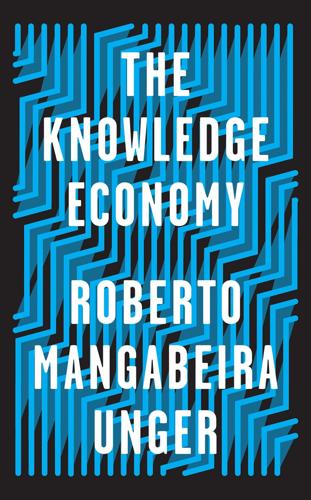
The Knowledge Economy
by
Roberto Mangabeira Unger
Published 19 Mar 2019
Equivocating economics ordinarily studies such regularities without regard to their institutional assumptions, which it takes to be stable or constant. A critic of its work may object that such regularities—for example, those of the Phillips curve charting a supposedly law-like relation between unemployment and inflation—depend on a wide range of detailed institutional arrangements. It suffices to change any element of this background to alter the supposed regularities. For the Phillips curve, the formative institutional arrangements may include, for example, those that have to do with the labor-law regime and the type of union organization that it sustains, the nature and level of unemployment insurance, and the assignment and scope of the power to set monetary policy.
…
Equivocating economics seeks to establish regularities of economic life against an institutional background that it may recognize in principle to be decisive but that it disregards in its analytic and programmatic practice. Its habitual domain of application has been macroeconomics. The equivocating economist sets out to establish law-like regularities between large-scale economic aggregates, such as the levels of employment and inflation. An example is the idea of the Phillips curve, according to which there is a stable, quantifiable relation between the level of employment and the rate of inflation. If monetary and other policies push unemployment below its “natural rate,” inflation will result. The regularities may appear to laws. By discovering them, economics would turn into the causal science that pure economics would not be and that fundamentalist economics cannot be.
…
See knowledge economy–inclusive vanguardism indivisibility thesis, 235–36 industrialization, 2–3, 159–63, 165, 167–68 industrial mass production agriculture and, 87–88 decline of, 212 described, 83–84 developing countries and, 15, 160 diffusion of, 54, 84–85, 88–89 division of labor under, 55, 84 as most advanced practice, 3–4, 10, 15, 55, 83, 220 educational requirements of, 85 formulaic character of, 85, 86 innovation and, 29–30, 84 labor under, 39–40, 64, 65, 84, 163, 185 positive externalities and, 28 public services under, 86–87 trust required in, 47 inequality confinement of knowledge economy leads to, 11, 13, 56, 72–73, 75, 77, 81 demand constraints and, 205–8 education and, 13–14 inclusive vanguardism addresses, 2, 13–14, 71 redistributive measures and, 13, 73–74, 76–78, 182, 205, 206 scarcity and, 33, 280 inflation, 63, 247, 249 innovation cooperation and, 47, 48–50, 93, 95, 106–7, 109, 110–11 diminishing marginal returns and, 28–29 discontinuity and, 29–30 disruptive, 216–19 economic growth and, 32–33 by firms, 215–19 government support for, 130–31, 132–33, 134 in industrial mass production, 84 institutional, 75, 119, 122–28, 207, 209, 211, 235, 269–70 as knowledge economy requirement, 20, 47, 49–50, 93, 94, 97, 130–31, 235 in market economy, 67 as perpetual rather than episodic, 29, 31, 33, 98, 130–31, 213, 221 public domain and, 131 Smith and Marx understatement of, 267–68 technology and, 20, 30–31, 67, 107 institutional structure and change day-to-day economic activity and, 250 economic theory on, 233–38, 264–65 first stages of, 119–21 fragmentary and gradual changes in, 16, 80–81, 118, 182–83, 269, 272 fundamentalist thesis on, 246–47 imagination and, 155, 243–50, 254, 264–65 as imperative, 227–33 in labor-capital relations, 221, 224–25 knowledge economy requirements and, 67, 119, 122–36, 169–71, 177, 179–80, 222–25 market economy changes and, 82, 119–36, 170, 207, 211, 228–29 moral culture and, 104 no single market economy structure, 106, 113, 114–15, 136, 179–80, 228, 237, 245, 255 post-marginalist economics and, 243–50 practical reasons for, 269–70 in property regime, 124–28 supply-demand questions and, 209, 219–24, transformative politics and, 91, 150–51, 157–58, 211–12, 221–22, 235–36, 286 intellectual property knowledge economy and, 127–28, 135 “non-rivalrous” good and, 27 proposals for transforming, 129–35 unified property right and, 130, 131 international division of labor classical development economics on, 167 developing countries and, 161, 162–63 most advanced practice and, 55–56, 168 inventory, 57, 215–16 Jevons, William Stanley, 229, 238 Kaldor, Nicholas, 79 Kant, Immanuel, 36–37, 108 Kelsen, Hans, 240 Keynes, John Maynard, and Keynesianism, 232, 256–62 countercyclical economic management and, 176, 231, 260 demand-oriented focus of, 200–201, 214, 257–58 on disequilibrium, 201, 259–60 lack of institutional vision by, 199–201, 202 on money, 194, 256 psychological explanations in, 200, 257 on scarcity, 277–79, 283 on supply-demand relationship, 197–98, 258–59 works Economic Possibilities for Our Grandchildren, 278 General Theory of Employment, Interest and Money, 197 knowledge economy alternative futures of, 17–18 in Brazil, 165 broadens access to resources/opportunities, 80, 105–6, 114, 119, 120–25, 170, 184, 186, 195, 200, 206, 209, 212, 218, 221–22, 224 consequences of confinement of, 1, 2, 25, 71–82, 89–90, 175, 178–79 cooperation and, 49–50, 81, 133–34 demand for services and, 282 destandardization of production and, 20, 255, 280 diminishing marginal returns and, 25–26, 28–29, 30, 31, 33, 130, 196, 213, 221, 279 diversity and, 255–56 economic sectors and, 11–12, 27, 53–55, 183, 220 firms’ relationship to, 7, 27, 224 imagination as requirement in, 37, 39–40, 81, 93, 95, 186, 286–87 industrial mass production compared to, 88–89 innovation in, 20, 47, 49–50, 93, 94, 97, 130–31, 235 insular vs. inclusive, 1–2, 8, 17–18, 228 intellectual property and, 127–28, 135 machines as formulaic devices under, 41–42 military analogy to, 38–39, 103 mind and, 35, 100 moral basis of, 47–51, 81, 107–10 as most advanced production practice, 4–5, 14, 196 present confinement of, 1, 5–8, 10–11, 14, 53–56, 58, 71–72, 88–90, 277 returns to scale and, 26–27, 28, 30 richest economies and, 15–16, 55 scientific discovery and, 30–31, 35 social capital and, 49–50 technical division of labor and, 20–21, 37–38, 94 as term, 1, 4 trading of data and, 128, 129–30 worker-machine relationship and, 40, 44–45 worldwide presence of, 55–56 knowledge economy – inclusive vanguardism capitalism and, 236–37 as cooperative regime, 50, 93, 214 developing countries and, 159, 163–64, 167, 171–72 disruptive innovation and, 218–19 economic decentralization and, 50, 255–56 economic stagnation and, 183, 230 educational requirements for, 50, 82, 90, 93–99, 186–87 entrepreneurial impulse and, 168 experimentalism and, 138, 186–87 finance/real economy relationship and, 184 high-energy democracy and, 145 higher purpose of, 9, 277–87 inequality alleviation and, 2, 13–14, 71 innovation as requirement of, 50, 93, 97, 235 insular vanguardism vs., 1–2, 8, 17–18, 228 labor and, 68–69, 184–86, 222–24, 283 legal and institutional requirements of, 67, 117–36, 169–71, 177, 179–80, 222–25 market economy reshaping and, 50, 117, 225, 228–29 moral culture and, 101, 102–4, 108–10 as necessary and possible, 7, 10, 14–15, 54, 69, 173 patent and copyright law and, 127–28 path to creation of, 1–2, 90–92, 134–35, 228–29 potential of, 1–2, 10, 169, 287 productivity increase under, 1, 13, 221 rich countries and, 179–81, 183, 186–88 role of imagination in, 93, 100, 286–87 supply and demand in, 16–17, 159, 195, 196, 202–3, 213, 220–21, 225, 258 trust/discretion and, 82, 103, 104, 255 unified property right and, 222, 223 wage labor and, 222–24 knowledge economy – insular and confined consequences of confinement, 1, 25, 71–72, 81–82, 89–90, 175, 178–79 cooperative competition in, 124 economic stagnation in, 56, 59, 71, 72, 81, 117, 178, 277 existence of, 5–8, 10–11, 14, 53–56, 58, 277 explanations for confinement, 54–56, 88–90 global oligopolies’ control over, 6, 58, 59–60, 66, 128 hyper-insular vanguardism and, 59–60, 63, 65–66, 72, 162 inclusive vanguardism vs., 1–2, 8, 17–18, 228 inequality and, 11, 13, 56, 72–73, 75, 77, 81 labor in, 63, 65–66 as path of least resistance, 270 pseudo-vanguardism and, 57, 59 labor cooperation and, 21–22, 35–36, 45, 69, 185–86, 222 economic security and, 49, 67–68, 109 empowerment of, 184 flexsecurity and, 67–68, 112 free, 45, 69, 184, 185–86, 222–23, 282, 286 as honorable calling, 285 hyper-insular vanguardism and, 63, 65–66 in inclusive knowledge economy, 184, 222–24, 283 in industrial mass production, 39–40, 64, 65, 84, 163, 185 instrumental view of, 283, 285 market order and, 67–69, 222–23 Marx on, 32, 65, 69, 237, 283 mechanized manufacturing and, 39–40, 48, 267 precarious employment and, 59, 63–69, 178, 185, 186, 224, 279 productivity and, 63, 184, 225 pseudo-vanguardism and, 63, 66 scarcity and, 283 self-employment and, 45, 69, 185–86, 222, 282, 286 in services, 65, 72–73 sliding scale and, 68 Smith on, 32, 266 as transformative vocation, 285–86 wages and, 45, 59, 63, 102, 104, 185, 222–24, 236–37, 251 worker-machine relationship, 40, 43–45, 223–24 See also division of labor labor-capital relations cooperative, 115 inclusive vanguardism and 184–86 institutional innovation in, 221, 224–25 supply/demand and, 63–64 labor law, 64, 68–69, 185 law antitrust, 66–67 contract and property, 48, 102, 113–14, 124, 262 dual nature of, 118–19 labor, 64, 68–69, 185 patent and copyright, 127–28, 129, 130, 131, 132 liberalism, 285 social, 76, 177–78, 181, 186, 208 licensing, 132, 156–57 Machiavelli, Niccolò, 105 machines evolution of, 41–42 mind and, 36, 37, 39–40, 100, 186 numerically controlled, 21, 94 workers’ relationship to, 40, 43–45, 223–24 macroeconomics, 231, 249, 260, 261 Madison, James, 150–51 Malthus, Thomas, 263 marginal cost, 26–27, 28, 60–61 marginalist economics alternative approaches to, 229 contributions of, 230, 238 empirical perspective of, 229–30 limitations of, 247, 272 pure economics espoused by, 244 relative prices and, 238–40 market economy and order corrective redistribution and, 73–74 democracy and, 144 economic theory’s idealization of, 231–32 fundamentalist economics on, 245 government regulation of, 121–22, 177, 182 inclusive vanguardism’s reshaping of, 50, 117, 225, 228–29 inequality alleviation and, 73–74, 76–78 initial stage of reconstruction of, 119–20 Keynes view of, 202 knowledge economy requirements and, 7, 45, 50, 255–56 labor and, 67–69, 222–23 legal-institutional reconstruction measures for, 82, 122–36, 170, 207, 228–29 need for experimentalist impulse in, 135 New Deal’s innovation to, 211 no single institutional structure for, 106, 113, 114–15, 136, 179–80, 228, 237, 245, 255 prevailing view of, 117–18 second stage of reconstruction of, 120–21 trust and, 47–48 unified property right and, 102, 109, 124–28 Marshall, Alfred, 198, 273 Principles of Economics, 229 Marx, Karl, and Marxism on capitalism, 32, 172, 210, 237, 266, 268 on coercion, 266 on historical evolution, 172, 235, 268, 269 imagination undervalued by, 267–68 insights of, 227, 232, 235, 236 on labor, 32, 65, 69, 237, 283 on most advanced practice of production, 3–4, 18, 159, 227 on primitive accumulation, 32 on production, 251–52, 264–65 on scarcity, 277–78 and social theory, 105, 234, 263, 271 on value and price, 239 works Capital, 65 The German Ideology, 278 Introduction to the Critique of the Gotha Program, 278 mass-production industry in Brazil, 164–65, 169 as economic rearguard, 12, 220 labor and, 40, 48, 163 protectionism toward, 12–13 See also industrial mass production mathematics, 273, 274–75 mechanized manufacturing, 3, 6, 10, 36 economic transformation and, 54 innovation under, 28, 29–30 labor in, 39–40, 48, 267 Marx and Smith study of, 252, 269 trust under, 47, 48 Menger, Carl, 229, 238 mental colonialism, 171, 173 microeconomics, 231, 260 military, 38–39, 103 Mill, John Stuart, 69 mind duality of, 36, 99–100, 287 imagination and, 36–37, 43, 81, 99–100, 186–87, 287 as machine, 36, 37, 39–40, 100, 186 monetary policy countercylical management, 176, 231, 247, 260 equivocating economics on, 249 money management and, 181, 247–48, 256 through debt, 203–4 money and expansionary monetary policy, 181 Keynes on, 194, 256 liquidity of, 194, 200, 247, 257 marginalist economics on, 247–48 politics and, 156–57 Montesquieu, Charles-Louis de Secondat, 105 moral culture of production, 13–14, 47, 101–15 cooperative capability and, 104–8, 109–10 educational requirements for, 103–4, 110 psychological expressions of, 111–13 security and, 112–13 social solidarity and, 108, 110, 114–15 trust and discretion in, 82, 101–3, 104, 107–8, 121 most advanced practice of production in agriculture, 88 broadening access to, 80, 119, 195–96, 224 consequences of confinement of, 71, 75, 89, 270, 271, 277 cooperative practices and, 105, 267–68 defining characteristics of, 3, 4, 5 development economics on, 161, 167–68, 219 economy-wide dissemination of, 6, 7–8, 14, 20, 81, 83, 178, 212, 213–14, 219–20 importance of studying, 4–5, 159, 227, 252, 264 industrial mass production as, 3–4, 10, 15, 55, 83, 161, 220 international division of labor and, 55–56, 168 knowledge economy characterized as, 4–5, 14, 196 labor regime and, 64, 184, 286 mechanized manufacturing as, 3, 10, 29–30, 39, 252, 269 productivity and, 3, 178 Smith and Marx on, 3–4, 18, 159, 227, 252 transformative potential of, 5, 71–72 national divisions, 253–54 negative capability, 36, 37, 43 New Deal, 175–76, 204 “non-rivalrous” good, 27 patents, 127–28, 129, 130, 131, 132 petty bourgeoisie, 166, 168, 169 Phillips curve, 249 Piaget, Jean, 42 Pigou, Arthur C., 198 politics constitutional structure and, 150–52 culture and, 109 democracy and, 77, 97, 156, 279 engagement and, 155 history of, 37, 100 hot and cold, 157–58 money and, 156–57 in rich countries, 178–82 security and, 111–12 transformative, 91, 150–51, 157–58, 211–12, 221–22, 235–36, 286 populism, 171, 179, 180, 188 post-marginalist economics, 239 competitive selection theory and, 253–56 deficit of institutional imagination in, 243–50 production and exchange theory of, 251–52 precarious employment, 63–69, 178 as growing practice, 59, 66, 185, 279 protection measures for, 67–69, 224 premature deindustrialization, 162, 165–66 price neutrality, 68–69, 185 primitive accumulation, 32 product differentiation, 22–23 production exchange’s relationship to, 227, 251–52 imagination and, 37, 39, 40, 286–87 manufacturing and, 22–23 subcontracting of, 58, 65, 185 transformation of nature and, 35 See also industrial mass production; mechanized manufacturing; moral culture of production; most advanced practice of production productivity confinement of knowledge economy consequences for, 10, 56, 71 cooperation and innovation required for, 106, 184 development economics on, 85–86, 161, 212 digital technologies’ boost to, 9, 19 inclusive vanguardism’s potential in, 1, 13, 221 labor and, 8, 63, 184, 211, 225 law of diminishing marginal returns and, 25, 28–29, 191 mass production and, 84, 85–86 most advanced practice of production and, 3, 178 Smith on, 266 social liberalism/social democracy on, 178, 186 and supply-demand relationship, 193, 215 of US economy, 8–9, 19 progressive taxation, 64, 76, 208 attenuating inequalities through, 73, 74, 182, 205 redistributive goals of, 78–80 property rights current organization of, 109 need for institutional innovation in, 124–28 no universal applicability for, 106, 247 See also contract and property law protectionism, 12–13 pseudo-vanguardism, 89–90, 100 characteristics of, 57–59 labor and, 63, 66 psychology cognitive, 42 cooperation/innovation and, 111–12 economics and, 273 Keynesianism on, 200, 257 public domain, 131 public services administrative Fordism and, 86–87, 110, 185, 187 civil society and, 87, 110 public spending, 198, 205, 207–8 pure economics, 243–44, 247, 248, 249 Qualcomm, 59 relative prices, 251, 252 marginalist economics and, 238–40 taxes and, 78, 207 value theory and, 265–66 returns to scale, 25–27, 28, 29, 30 Ricardo, David, 263 Roosevelt, Franklin, 175, 204 Samuelson, Paul, 253 savings, 9, 266–67 growth and, 32–33 hoarding and, 197, 259 productive investment and, 197, 202 Say, Jean-Baptiste, 263 scale product differentiation and, 22–23 returns to, 25–27, 28, 29, 30 scarcity inequality and, 33, 280 Marx and Keynes on, 277–79 persistence of, 279–83 Schopenhauer, Arthur, 139 scientific agriculture, 6, 53, 88, 163 secular stagnation, 8–11, 259 self-employment, 144 as free labor, 45, 69, 185–86, 222, 282, 286 Senior, Nassau, 263 services bureaucratic rationalization in, 86–87 desire for, 281–82 firms providing, 7, 87 knowledge-intensive, 6, 11, 53 manufacturing and, 22–23, 53, 163 workforce in, 65, 72–73 See also public services Simmel, Georg, 47, 105 sliding scale, 68 small businesses, 54–55, 77, 170 as economic rearguard, 11–12 government and, 165 Smith, Adam, 3, 39, 159, 251–52, 263 classical economics and, 232, 263, 271 imagination undervalued by, 267–68 on labor brutalization, 32, 266 and most advanced practice study, 3–4, 18, 159, 227 on production, 251–52, 264–65 on value and price, 239 social capital, 49–51, 105 social democracy, 75, 76–77, 112, 171 liberalization of, 177–78, 181 social-democratic settlement, 181–83, 186, 261 social entitlements, 76, 181, 209, 248 consumption taxes used to finance, 78, 208 demand restraints and, 64, 205, 258 moderating inequality through, 73, 74–75, 117, 205, 206 social inheritance, 138–39, 112–13 social protection, 77, 112, 177, 181 Social Security, 176, 204 social spending, 80, 206, 211 attenuating inequality through, 2, 13, 77, 177, 182 demand constraints and, 193, 205–7 solidarity, 48, 108, 110, 114–15 stagnation, 15, 191, 192, 259 confinement of knowledge economy effect on, 56, 59, 71, 72, 81, 117, 178, 277 inclusive vanguardism as response to, 183, 230 secular, 8–11, 259 stakeholders, 112–13, 125–26, 133–34, 135, 222 stock options, 58 subcontracting, 58, 65, 185 supervision and implementation, 23, 37–38, 49 supply-demand relationship, 189–96 broadening demand access, 13, 195–96, 200–201, 203–7, 209, 213, 257–58 broadening supply access, 13, 180, 195–96, 214–25 discontinuity in, 191–92 economic growth and, 191 economic instability and, 193–95 heteronomy in, 192–93 inclusive knowledge economy and, 16–17, 159, 195, 196, 202–3 individual firms and, 215–19 Keynesianism on, 197–98, 257–59 labor-capital relations and, 63–64 marginalist economics on, 238 Sweden, 76–77 tax-and-transfer, 13, 64, 78, 207, 209 taxes compensatory redistribution and, 74, 78–80, 207–8 on consumption, 75, 77–78, 79, 208 indirect and regressive, 75, 77–78, 208 progressive, 64, 73, 74, 76, 78–80, 182, 205, 208 public spending and, 77–78, 207–8 relative prices and, 78, 207 value-added, 77–78 Taylor, Frederick, 39 technical division of labor, 84, 266 changes to, 21–22, 23, 35–36, 37–38 ideal of, 223–24 knowledge economy and, 20–21, 37–38, 94 in military, 38–39 technical education, 93–94 technology digital and information, 9, 19, 57 increased access to, 119, 123, 184, 224 innovation and, 20, 30–31, 67, 107 productivity and, 9, 19 relation to practices, 4, 22, 40–41, 43 scientific experimentalism and, 30–31 Toyota method of production, 20, 22 transformative variation, 37, 43, 285–86 trust and discretion inclusive vanguardism and, 82, 103, 104 innovation and, 49 in knowledge economy, 47, 94 market economy and, 47–48 moral culture of production and, 101, 107–8, 121 unemployment, 178, 249 unified property right advantages and disadvantages of, 125–26 disaggregated property and, 126–27 economic decentralization and, 102, 125, 186, 237 under generalized knowledge economy, 222, 223 intellectual property and, 130, 131 legal doctrine of, 48, 102, 127 market economy and, 102, 109, 245 United States agriculture in, 88, 209–10 constitutional structure of, 150–51 expansionary monetary policy in, 203–4 financial crisis and, 198–99, 204 New Deal in, 175–76, 204 productivity in, 8–9, 19 regressive income redistribution in, 199, 205 during World War II, 50–51 value-added tax (VAT), 77–78 value theory, 239–40, 265–66 venture capital, 119–20, 194 Vico, Giambattista, 105 wage labor, 63, 251 employment contract and, 102 free labor and, 45, 69, 104, 185, 222–23 in inclusive knowledge economy, 222–24 overcoming of, 224, 236–37 Walras, Léon, 229, 238, 241, 257 Walmart, 57, 59 Weber, Max, 47, 86, 105 work teams, 22, 38, 48
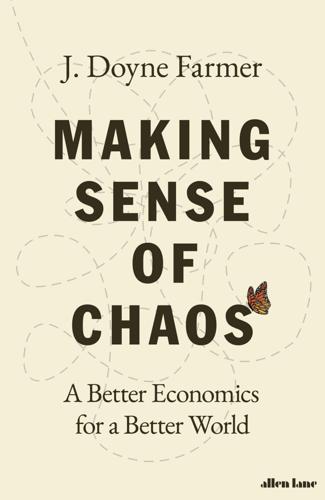
Making Sense of Chaos: A Better Economics for a Better World
by
J. Doyne Farmer
Published 24 Apr 2024
Keynesian-inspired econometric models were challenged by the crisis of high unemployment in the 1970s. In 1974, US unemployment jumped from its previous level of about 4 per cent to almost 8 per cent. This put policymakers under pressure to respond. As the story goes, they tried to exploit something called the Phillips curve to bring down joblessness.5 The Phillips curve refers to the hypothesis that unemployment and inflation are negatively correlated, which up until then had always been the case. If unemployment becomes low, this should push wages higher, which in turn causes inflation. But perhaps causality also runs in the other direction?
…
rq=chaos Fermi, Enrico, John Pasta, Stanislaw Ulam and Mary Tsingou. 1955. ‘Studies of Nonlinear Problems’. Los Alamos National Laboratory Technical Report LA-1940, doi: 10.2172/4376203. Fisher, Franklin. 1989. Disequilibrium Foundations of Equilibrium Economics. Cambridge: Cambridge University Press. Forder, James. 2014. Macroeconomics and the Phillips Curve Myth. Oxford: Oxford University Press. Fostel, A. and J. Geanakoplos. 2008. ‘Leverage Cycles and the Anxious Economy’. American Economic Review 98 (4): 1211–44. Foster, G. and P. Frijters. 2012. ‘The Formation of Expectations: Competing Theories and New Evidence’. http://tinyurl.com/Foster-Frijters-2012 Frey, Carl Benedikt and Michael A.
…
This example was taken from Carlin and Soskice (2015). 4 Keynes (1936). 5 The account I present here, which is standard lore in economics, has been criticized as apocryphal by James Forder (2014). He argues that contemporary Keynesian economists were not as naïve as they were portrayed, and that they did not advocate using the Phillips curve as a justification to intentionally inflate the money supply, nor did this motivate policymakers. 6 Solow (1956). 7 Koopmans (1965) and Cass (1965). 8 Ramsey (1928). 9 Calvo (1983). 10 A standard model is Smets and Wouters (2007). See Glandon et al. (2022) for a review, and Edge and Gürkaynak (2011) for an evaluation of predictive performance. 11 Baqaee, Rezza and Farhi (2019).
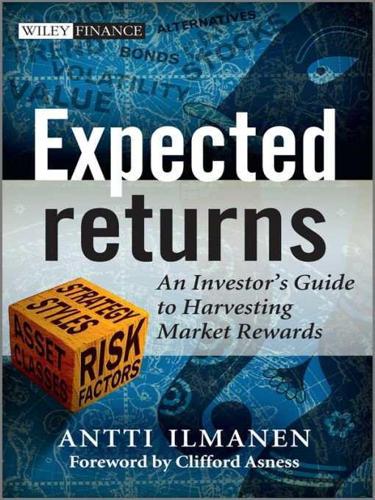
Expected Returns: An Investor's Guide to Harvesting Market Rewards
by
Antti Ilmanen
Published 4 Apr 2011
In theory, the growth–inflation relation is positive if demand shocks move the economy up and down a stable Phillips curve: nominal bonds are then valuable recession hedges that may even warrant a negative BRP. Conversely, the relation is negative if supply shocks shift the Phillips curve in and out: nominal bonds exacerbate losses for risky assets during stagflations and warrant a positive BRP. Strong central bank credibility and well-anchored inflation expectations support a stable Phillips curve whereas weak credibility makes for an unstable Phillips curve— and riskier government bonds. The contrast between the 1990s and 2000s, on the one hand, and the 1970s, on the other hand, is clear.Figure 9.10.
…
Understanding inflation and its drivers Monetarists link inflation to money supply growth, assuming stable money demand over time; all other influences are second order or temporary. Economic historians emphasize the role of wars and demographics. Keynesian economists model inflation using the expectations-augmented Phillips curve: inflation is a function of inflation expectations, and the output gap (or employment gap vs. the natural rate). A standard Phillips curve relation suggests that an economy growing near or beyond its full capacity creates inflationary pressures while growing slack predicts disinflation or deflation. Besides demand-driven inflation, there is a possibility of supply–push inflation through energy and currency effects.
…
Japanese equities lost nearly all of their value within a year but managed to recover postwar losses by 1960. For nominal assets the losses were more permanent. [3] Empirical Taylor rules show that inflation-targeting central banks also apply countercyclic demand management, even if they don’t have the Fed’s dual mandate on inflation and employment. In an expectations-augmented Phillips curve model, wage and price rigidities justify some real effects from monetary policy, albeit temporary. Eventually, inflation expectations adjust and in the long run monetary stimulus only raises inflation. Friedman’s quote about inflation being always a monetary phenomenon is true in the sense that sustained inflation needs central bank accommodation (money supply growth sustainably outpacing money demand growth).
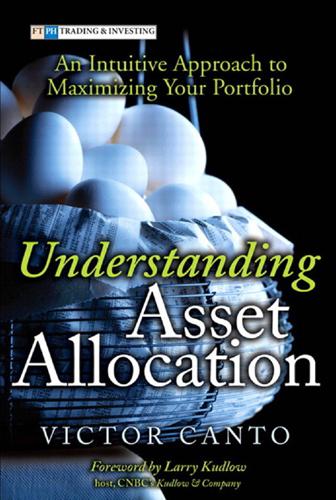
Understanding Asset Allocation: An Intuitive Approach to Maximizing Your Portfolio
by
Victor A. Canto
Published 2 Jan 2005
Equity Returns GDP Growth Increasing Decreasing Increasing Inflation 0.33% 0.22% Decreasing Inflation 1.17% 0.87% T-Bond Returns GDP Growth Increasing Decreasing Increasing Inflation –0.44% 0.17% Decreasing Inflation 0.30% 0.51% Source: National Bureau of Economic Research and Ibbotson Associates So far, the data presented link the two asset classes’ (equities and fixed income) relative and absolute returns to the economic environment as described by inflation and GDP growth. Thus, the different inflation and GDP growth combinations can be used to characterize some textbook representations of the world. In the simpler textbooks, the interaction of rising inflation and GDP growth is commonly associated with the Phillips curve, where increases in 98 UNDERSTANDING ASSET ALLOCATION spending—generated by aggregate demand shifts—lead to higher output and higher prices. Declining inflation and real GDP growth periods represent the mirror image, which is described in the simpler textbooks as the result of a decline in aggregate demand.
…
Viewed this way, the 1970s’ stagflation (stagnant growth, higher inflation), was just a crop (output) failure caused by supply shocks and/or bad economic policy. The results reported in Table 5.2, and the implications derived from my valuation models, reveal a classical economic environment in which the highest positive impact on equity returns comes when inflation and growth move in the same direction. In contrast, the Keynesian Phillips curve advocates would say such an environment produces the highest range of returns for fixedincome instruments. The point is knowing the economic-policy package being implemented helps one identify the nature of the shocks that will be imposed on the economy. This knowledge in turn helps one forecast the economy’s adjustment, in particular the inflation/GDP-growth combination.
…
Used to calculate value above risk. net present value (NPV) The future stream of benefits and costs converted into today’s equivalent values. nominal interest rate Interest rate not adjusted for inflation. passive management A money management strategy that seeks to match the return and risk characteristics of a market segment or index by mirroring its composition. passively managed low-cost index funds Owning all or almost all of the stocks in a certain index rather than actively buying and selling stocks based on different recommendations. The result is if the market does well, these funds do well; if the market doesn’t do well, neither do these funds. The main benefit is the low overhead costs because there is little buying and selling. Phillips curve Based on the theory there was a trade-off between inflation and unemployment. The lower the unemployment rate, the higher the inflation rate. portable alpha strategy Process of investing in alpha-generating strategies of any type without affecting the underlying market positioning or the portfolio’s asset allocation. price rule Requires that the monetary authority attempt to maintain a chosen price index at a particular level by varying the stock of money.

MegaThreats: Ten Dangerous Trends That Imperil Our Future, and How to Survive Them
by
Nouriel Roubini
Published 17 Oct 2022
Milton Friedman earned a Nobel Prize for exposing a shift in the Phillips curve. If loose monetary policies try to push unemployment below its normal, structural level, inflation expectations rise. Workers and firms seek increases in wages and prices that suppress demand. Less demand means fewer jobs. Unemployment sees no improvement, but inflation increases. So the long term Phillips curve is vertical. The unemployment rate needs to be at its structural level and any attempt to reduce it below that level will cause ever rising inflation. OPEC delivered two major supply shocks that shifted the Phillips curve. Policy missteps compounded their ill effects.
…
Oil shocks, like all negative aggregate supply shocks, reduce potential growth and increase production costs. That puts pressure on companies that use oil; they must trim payrolls and/or raise prices. Loose monetary policy lowers the cost of capital, helping companies maintain payrolls until demand resumes. But it feeds further costs and price increases. In the late 1960s, the Phillips curve furnished a way to align inflation and unemployment targets. It hinges on an inverse relationship: inflation in wages and prices stays low when unemployment is high, chiefly because workers lack the power to negotiate higher pay and firms lack the power to boost prices. The curve follows a path where inflation and unemployment levels move in opposite directions.
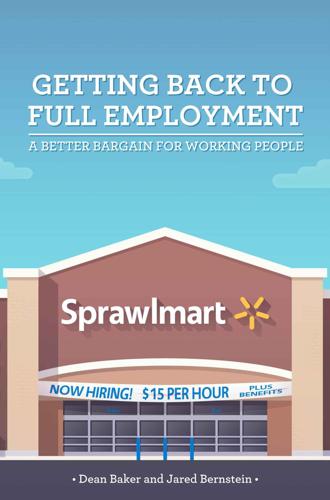
Getting Back to Full Employment: A Better Bargain for Working People
by
Dean Baker
and
Jared Bernstein
Published 14 Nov 2013
Sydney: Reserve Bank of Australia. http://citeseerx.ist.psu.edu/viewdoc/download?doi=10.1.1.200.1174&rep=rep1&type=pdf Appelbaum, Eileen, Thomas Bailey, Peter Berg, and Arne Kalleberg. 2000. Manufacturing Advantage: Why High-Performance Work Systems Pay Off. Ithaca, NY: Cornell University Press. Arnold, Robert. 2008. “Reestimating the Phillips Curve and the NAIRU.” Working Paper No. 2008-06. Washington, DC: Congressional Budget Office. http://www.cbo.gov/sites/default/files/cbofiles/ftpdocs/95xx/doc9515/2008-06.pdf Aschauer, David A. 1989. “Is Public Expenditure Productive?” Journal of Monetary Economics, Vol. 23, No. 2, pp. 177-200. Aschauer, David A. 2000.
…
“Creative Recruitment Employers Breaking Mold With Incentives for Hiring,” October 5. Organization for Economic Cooperation and Development (OECD). 2000. “OECD Economic Outlook, Vol. 2000/1.” OECD. http://www.oecd-ilibrary.org/economics/oecd-economic-outlook-volume-2000-issue-1_eco_outlook-v2000-1-en Palley, Thomas. 2003. “The Backward–Bending Phillips Curve and The Minimum Unemployment Rate of Inflation: Wage Adjustment With Opportunistic Firms.” The Manchester School, Vol. 71, No. 1, pp. 35-50. http://onlinelibrary.wiley.com/doi/10.1111/1467-9957.00333/abstract Pavetti, LaDonna, Liz Schott, and Elizabeth Lower-Basch. 2011. “Creating Subsidized Employment Opportunities for Low-Income Parents: The Legacy of the TANF Emergency Fund.”
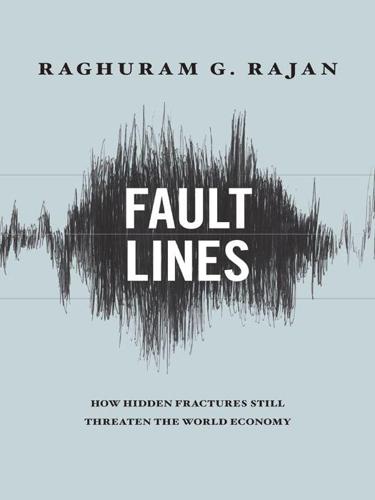
Fault Lines: How Hidden Fractures Still Threaten the World Economy
by
Raghuram Rajan
Published 24 May 2010
Also, it has been entrusted since its founding in 1913 (in the wake of the Banker’s Panic of 1907) with helping to ensure the stability of the financial system.2 In the past, economists believed that the components of the healthy-economy mandate—the goals of maximum sustainable employment (high growth) and stable prices (low inflation)—were incompatible over the long run, because high growth might require high inflation. Implicit in this trade-off (known as the Phillips curve after William Phillips, who found such a relationship in the U.K. economy between 1861 and 1957) was the belief that you could fool all of the people all of the time. Injecting more inflation would lead people to believe they were getting paid more for the goods they produced and to work harder—thus expanding output—not realizing that everything else was becoming costlier at the same time. In the late 1960s and early 1970s, even as data suggested the Phillips-curve relationship between inflation and unemployment was breaking down, the “rational expectations” revolution started taking hold of monetary economics.
…
In the late 1960s and early 1970s, even as data suggested the Phillips-curve relationship between inflation and unemployment was breaking down, the “rational expectations” revolution started taking hold of monetary economics. It explained why the Phillips-curve relationship was theoretically untenable. The essential idea was that the public understood the objectives of policy makers and the frameworks they operated with, so they would not cooperate by being fooled. If the central bank had a policy of inducing high inflation, producers would rationally expect that all prices would go up and would not exert more effort when they saw the prices of their own products go up. Rather, they would understand that the additional dollar they earned was actually worth less in terms of its ability to purchase goods and services.
…
P., See also JP Morgan Morrice, Brad mortgage-backed securities: credit risk of Fannie Mae and Freddie Mac issues federal purchases of held by banks investors in ratings of risks of, subprime mortgages in tail risks of tranches of mortgage brokers mortgage insurance mortgages: defaults on deregulation of thrift industry FHA foreclosures of historical evolution of interest rates on predatory lending traditional lending process for, See also subprime mortgage market motivations multilateral financial institutions: influence of lending by reforms of See also International Monetary Fund; World Bank mutual fund management companies national home ownership strategy, See also home ownership nationalism Nehru, Jawaharlal New Century Financial New Deal New York City No Child Left Behind Act of noncognitive skills Northern Rock Obama, Barack Obama administration Office of Thrift Supervision O’Neal, Stanley opportunities organizational capital ownership society, See also home ownership Park Chung Hee Paulson, Henry J. Paulson, John PBOC. See People’s Bank of China Pension Benefit Guarantee Corporation pensions People’s Bank of China (PBOC) Peugeot Phillips curve physicians: malpractice suits and salaries of See also health care Pinto, Edward A Plan of the English Commerce (Defoe) Plaza Accord (1945) political fault lines politics: economics and of immigration pressures for easy credit, pressures for fiscal stimulus Poole, Keith populist credit expansion Populist movement poverty: cycle of in developing countries family instability and opportunities for escape from Prasad, Eswar predatory lending prices: food functions of, See also asset prices; housing market; inflation Prince, Charles professional credentials proprietary trading protectionism racism rating agencies Rato, Rodrigo de recession of: Federal Reserve responses to fiscal stimulus response to jobless recovery from recessions: of of cleansing role of jobless recoveries from Keynesian policies and overreactions to political pressure for economic stimulus during redundancy, in financial systems reforms: in access to credit in Brazil in China in deposit insurance educational fault lines addressed by of Federal Reserve financial in global economic governance goals of guiding principles of of health insurance in housing finance of incentives in India of monetary policy of multilateral financial institutions, need for reducing government intervention reducing search for tail risk regulatory tort of unemployment benefits regulation: antitrust cycle-proof enforcement of failures of history of laissez-faire ideology and in New Deal reforms of See also deregulation regulation, banking: capital requirements central bank responsibilities for cognitive capture and Community Reinvestment Act effectiveness of enforcement of history of of new products reforms of resolution of bank failures risk monitoring and transparency of relationship capitalism.

Rule of the Robots: How Artificial Intelligence Will Transform Everything
by
Martin Ford
Published 13 Sep 2021
Gwynn Guilford, “The great American labor paradox: Plentiful jobs, most of them bad,” Quartz, November 21, 2019, qz.com/1752676/the-job-quality-index-is-the-economic-indicator-weve-been-missing/. 14. Elizabeth Redden, “41% of recent grads work in jobs not requiring a degree,” Inside Higher Ed, February 18, 2020, www.insidehighered.com/quicktakes/2020/02/18/41-recent-grads-work-jobs-not-requiring-degree. 15. “The Phillips curve may be broken for good,” The Economist, November 1, 2017, www.economist.com/graphic-detail/2017/11/01/the-phillips-curve-may-be-broken-for-good. 16. Jeff Jeffrey, “U.S. companies are rolling in cash, and they’re growing increasingly fearful to spend it,” The Business Journals, December 12, 2018, www.bizjournals.com/bizjournals/news/2018/12/12/u-s-companies-are-hoarding-cash-and-theyre-growing.html. 17.
…
Evidence for underwhelming consumer demand has manifested in the breakdown in the normal relationship between unemployment and inflation. In 1958, the economist William Phillips showed that there is generally a consistent trade-off between unemployment and inflation. As unemployment falls, inflation rises. When I studied economics in college, this inverse relationship, known as the Phillips curve, was taught as one of the basic principles of the field. In the years since the end of the Great Recession in 2009, however, this relationship has broken down and low unemployment now coexists with very low rates of inflation and low interest rates.15 I believe that an important reason for this is that falling unemployment is no longer associated with increases in wages or consumer demand that are sufficient to drive inflation.

Culture and Prosperity: The Truth About Markets - Why Some Nations Are Rich but Most Remain Poor
by
John Kay
Published 24 May 2004
The fact is there have been very few empirical testings of this kind ... while assertions of conviction are plentiful, factual findings are rare." 8 Indeed, it is difficult to think of any issue on which a position once held by a substantial, respected group of economists has been vacated as a result of empirical refutation. Perhaps the Phillips curve-an empirical correlation between unemployment and inflation that broke down after the oil shock of the 1970s-falls into this category. But then I turned again to Mankiw's elementary textbook, and discovered an entire chapter devoted to the Phillips curve: and that George Akerlof, receiving the Nobel Prize in 2001, described the Phillips curve as "probably the single most important macroeconomic relationship." 9 No modern chemistry textbook describes the phlogiston theory.
…
See spontaneous order organizations, 37,214-16 organized complexity, 131, 132 Paley, William, 125, 126 Pareto efficiency, 192-94,202,291,319 patents, 80-81,82,89, 117-18,273 path dependency, 131,213,260 personal computers. See computers pharmaceuticals, 6, 81, 89,267,273-74 philanthropy, 269-70,298,315, 320, 353 Philippines, 280-81 Phillips curve, 327 photocopying, 117-18 plan bargaining, 98 Planck, Max, 130 planning. See central planning Plowden, Edward, 111-12, 114, 120-21, 127 pluralism, 87, 88, 115-24, 190, 200 American business model, 21, 79,87 and economic development, 55-56, 62-63 monopolies vs., 295 research support, 269-70 See also disciplined pluralism political economy, 201-3,314-15 politics, 55, 62, 69 adaptive behavior, 252 of economics, 333-35 public choice theory, 343 risk assessment, 156-57 self-interest, 12, 250-51, 317 strategic behavior, 100-101 pollution, 263-65 poor states, 16-17,53,64-65,67,211, 277-88 coordination failures, 127 dependencytheor~60,284-86 economic policy, 335-37 future of, 354-55 inequality in, 51-52 reasons for, 47,319,355-56 and rent seeking, 295 Porter, Michael, 334 { 417} portfolio theory, 160 Portrait ofDr.

Adaptive Markets: Financial Evolution at the Speed of Thought
by
Andrew W. Lo
Published 3 Apr 2017
Within macroeconomics, there’s a longstanding relationship between unemployment and inflation known as the Phillips curve. This curve is simple enough to explain: periods of high unemployment usually have low inflation, and periods of low unemployment usually have high inflation. The Phillips curve suggested to most policymakers that government policies that reduce unemployment do so at the cost of increasing inflation, and government policies that reduce inflation do so at the cost of increasing unemployment. Adjust one, and the other becomes an issue. The Phillips curve ran into a problem in the 1970s, however: it didn’t work. The United States had high unemployment and high inflation at the same time.
…
The United States had high unemployment and high inflation at the same time. Policymakers even invented a new term to describe it: stagflation. Moreover, the traditional Keynesian policies of the Federal Reserve didn’t seem to be fixing the problem. In 1976, using Muth’s rational expectations framework as his starting point, Lucas argued that the Phillips curve wasn’t a cause-and-effect relationship. If individuals in the economy have rational expectations, Lucas argued, a government policy designed to reduce unemployment but increase inflation might not work the way policymakers intended. In particular, if businesses expect higher inflation due to government intervention, they’ll respond by incorporating this fact into their plans right away, resulting in a new equilibrium that may not have higher employment at all.
…
See also index funds Pasteur, Louis, 165 Patel, Pankaj, 267 patents, 284, 401, 402, 404 path independence, 208 pattern matching, 66 Paulson, John, 224, 227, 314, 318 Pavlov, Ivan, 80 Pelizzon, Loriana, 376 Peltzman, Sam, 206 pension funds, 230, 264, 299, 408, 409, 413 Pentagon Papers, 55 peppered moth (Biston betularia), 138–140, 141 Perold, André, 274 Perrow, Charles, 321–322, 361, 372 pesticides, 358 Pete, Steven, 378 peyote, 79 Pfeffer, Irving, 236 Pfizer Inc., 332, 333, 334 pharmaceuticals, 403–410 phenylketonuria, 147 Phillips curve, 36–37 phi phenomenon, 70 physics, 2, 10–11, 19, 20, 25, 209–215 Picano-Nacci, Boris, 61 Pickard, Lee, 307–309, 311 Pinker, Steven, 156, 173–174 Pisaster (sea star), 242 Pitts, Walter, 131 Planck, Max, 140 plasticity, of brain, 114, 156 pleasure center, 87 Pleistocene, 174 Poggio, Tommy, 41 Poincaré, Henri, 18 poker, 59 pollution, 358 Ponzi, Charles, 5 Ponzi schemes, 334, 344–345, 351, 354, 355, 393 Popper, Karl, 219 population genetics, 216 population growth, 163, 164, 193, 194, 201, 215, 257 portfolio insurance, 273, 274 portfolio theory, 27, 48, 212, 249 positron emission tomography (PET), 78, 110 Pounds, William, 35–36 poverty, 411–415, 416 prediction, 130 Prediction Company, 278 prediction markets, 38–40 preference orderings, 97 prefrontal cortex, 162, 279; damage to, 102–103, 107; dorsolateral, 337, 339; evolution of, 153–154, 163; as executive brain, 119–122; rational functions in, 96, 99, 100, 103, 105, 119–122, 128–129, 154, 337, 339; short-circuiting of, 104, 122, 343; ventromedial, 102, 107 present value, 98 prices, 2, 5, 9; of commodity futures, 20; discovery of, 109; discreteness of, 71; of hogs, 28–33, 34; of wheat, 20.
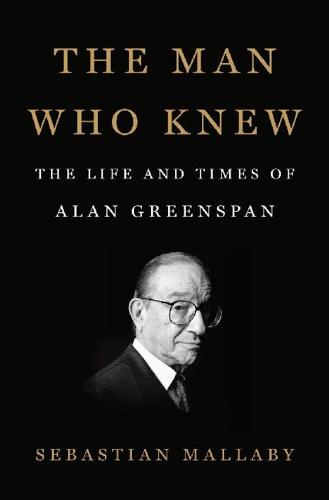
The Man Who Knew: The Life and Times of Alan Greenspan
by
Sebastian Mallaby
Published 10 Oct 2016
Bradsher’s story seems unfair in light of the fact that in congressional testimony four months later, Greenspan repeated Blinder’s view of the Phillips curve. “Over the long run I don’t see any trade off between inflation on the one hand and sustainable economic growth and . . . employment. . . . It is true, however, that in the short run there are trade offs.” Joint Economic Committee, Testimony by Alan Greenspan, Chairman, Board of Governors of the Federal Reserve System, Before the Joint Economic Committee, 103rd Cong., 2nd sess., 1994. Likewise, on the first day of the FOMC meeting that ran from January 31 to February 1, 1995, Greenspan echoed Blinder, stating, “There still is a short-term Phillips Curve.” To be fair, part of the stormy reaction to Blinder’s comments came from European central bankers, whom Blinder had accused (correctly) of excessive tightness.
…
Phillips, a New Zealander at the London School of Economics, had documented the trade-off between unemployment and inflation, with the implication that technocrats could engineer permanently low unemployment if they were willing to accept modest inflation; and two years later Paul Samuelson and his MIT colleague Robert Solow, applying the Phillips curve to U.S. data, suggested that an enlightened administration might choose unemployment of 3 percent at the price of inflation of just 4.5 percent. Seizing on this happy verdict, the Kennedy administration promised “full employment,” an objective that would benefit workers, salve racial tensions, and bolster America in its apocalyptic rivalry with the Soviet Union.
…
The system had worked well for fifteen years, but then the New Frontier economists had embraced the goal of “full employment.” To preserve the fixed exchange rate, the United States had to avoid inflation, which would undermine the value of its money. But to attain full employment, the United States had to do the opposite—it had to accept inflation in accordance with the implication of the Phillips curve, which indicated that rising prices could sustainably boost the number of jobs in the economy. As the goal of full employment trumped the fealty to Bretton Woods, rising inflation eroded confidence in the dollar.41 Indeed, by the time Nixon’s advisers gathered at Camp David, the dollar-gold link was close to breaking.

More: The 10,000-Year Rise of the World Economy
by
Philip Coggan
Published 6 Feb 2020
Tibi Puiu, “Your smartphone is millions of times more powerful than all of NASA’s combined computing in 1969”, ZME Science, September 10th 2017 9. Source: the St Louis Federal Reserve, https://fred.stlouisfed.org/series/CIVPART. It has an excellent and accessible database on the economy. 10. For an excellent explanation, see Kevin D. Hoover, “Phillips Curve”, http://www.econlib.org/library/Enc/PhillipsCurve.html 11. This is now dubbed the non-accelerating rate of inflation or NAIRU. 12. “The Phillips curve may be broken for good”, The Economist, November 1st 2017 BIBLIOGRAPHY What follows is a list of the books and academic papers consulted. Newspaper, magazine and blog articles appear in the Notes (pages 371–423), along with data sources.
…
The US suffered five quarters of falling GDP in the period between the middle of 1973 and the spring of 1975, at a time when inflation was rising sharply.82 This combination of a weak economy and higher prices led to the creation of a portmanteau word, stagflation. It caused economists to rethink their ideas. Previously, they had thought in terms of a trade-off between unemployment and inflation, known as the Phillips curve after the economist who described it. The aim of policymakers in the three decades after the Second World War had been to keep unemployment as low as possible, without letting inflation rip. As we shall see in Chapter 16, the crisis eventually led to a redirection of economic policy, in part driven by the monetarist and small government ideas of Milton Friedman.
…
Worse still, the impact of monetary and fiscal measures such as changing tax or interest rates may take a year or two to have an impact. By the time they take effect, economic conditions will probably have changed substantially. The difficulties facing policymakers are made even worse because the relationship between economic variables can change. Take the Phillips curve, named after a study by William Phillips, an economist from New Zealand, of the relationship between unemployment and inflation in Britain between 1861 and 1957.10 Phillips found that, as unemployment fell, inflation tended to rise. The logical explanation was that, as workers became harder to find, employers had to offer higher wages, requiring businesses to charge higher prices.
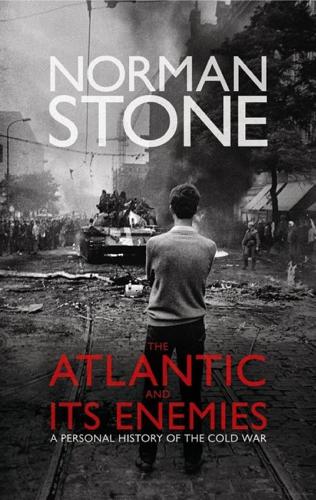
The Atlantic and Its Enemies: A History of the Cold War
by
Norman Stone
Published 15 Feb 2010
At the time, economists were fighting their last war, in this case against unemployment, and an engineer-turned-economist, Alban Phillips, who had worked on a long run of data, produced one of the great symbols of the decade, the Phillips Curve. Wage rises and unemployment were related, with only one variable, import costs (as in the Korean War). In England, welfare benefits stopped wages from falling too low, and so demand for goods was kept up; government must surely maintain that demand to the point at which unemployment would never rise above 2.5 per cent. That way, there would be price stability, and men such as Alan Walters, wanting to make complicated calculations as to how much credit there was in the system were simply wasting time. The Phillips Curve dominated academic economics (or ‘discourse’).
…
The most basic assumption in England had to do with the thirties, when so many young and educated people had looked guiltily at the mass unemployment of the traditional industries, mainly in the north, and had compared it with the prosperity of the south (and maybe also thought, inevitably, that their own job prospects should have been grander than the schoolteaching or other such low-paid work that many of them found themselves doing). Keynes had said that government spending would cause employment to increase, which would then create more ‘demand’ and cause greater production. This had been formalized in the Phillips Curve. Friedman challenged this. He claimed that there was only a ‘tradeoff between unemployment and unanticipated inflation’, meaning that if people saw that inflation was coming, they would take it into account in wage demands, and unemployment would be back to the starting point. In Keynes’s own time people had not expected inflation and did not know how to deal with it.
…
Harriman, Averell Harrington, Michael, The Other America Harris, Robert, Archangel Hartington, Kathleen Cavendish, Marchioness of (née Kennedy) Harvard University Business School Tercentenary Hastings, Sir Max Havana Havel, Václav Havenstein, Rudolf Hayek, Friedrich von Healey, Denis, Baron Heath, Sir Edward: appearance and character and Britain’s membership of EEC and Britain’s relations with US dismissed as Conservative leader government of incomes policy loses 1974 election and Margaret Thatcher’s government and trade unions Hegel, Georg Wilhelm Friedrich Hekmatyar, Gulbuddin Helms, Richard Helsinki conference (CSCE; 1975) Hemingway, Ernest Hentze, Paul Herat heroin Hersh, Seymour Herter, Christian Heseltine, Michael, Baron Hezb (Afghan resistance group) Hills, Denis Hindus Hippocrates Hiroshima Hiss, Alger History Today (magazine) Hitler, Adolf: appeasement of beer-hall Putsch (1923) Berlin Bunker eugenics favourite film invasion of Czechoslovakia invasion of USSR reduction of unemployment rise to power suicide and cremation Ho Chi Minh Ho Chi Minh Trail Hodder and Stoughton (publishers) Hodža, Enver Hoechst (corporation) Hoesch (corporation) Hoffman, Paul Hoggart, Richard Holland: Calvinist Church colonies economic success and EEC exports floating of currency oil embargo against post-imperial decline trade unions see also Benelux Hollywood Holy Roman Empire homosexuality gay rights Honecker, Erich Hong Kong hooliganism Hoover, Herbert Hopper, Kenneth Hopper, William Horn, Gyula Hoskyns, Sir John Hotter, Hans Howe, Geoffrey, Baron Howe of Aberavon Hue, Vietnam Hugo, Victor, Les Misérables human rights Humphrey, Hubert Hunan province Hungarian diaspora Hungary: AVO (security police) Catholic Church Christian Women’s Camp Communist Party communist takeover ending of communist state inflation intelligentsia Jews in under Kádár Khrushchev’s relaxation attempts labour camps nationalism opening of border with Austria (1989) Peasant Party peasantry Protestant churches relations with Austria Second World War Social Democrats territorial losses trade unions United Workers’ Party uprising of 1848 uprising of 1956 Writers’ Union Huntington, Samuel Husák, Gustáv Hussein, King of Jordan Huxley, Sir Julian Hysko, Miroslav Ibárruri, Dolores IBM (corporation) ICBMs (intercontinental ballistic missiles) Ickes, Harold IEA (British Institute of Economic Affairs) Iliescu, Ion Illinois I’m All Right, Jack (film) IMF (International Monetary Fund): assumes true world role Belgrade meeting (1979) and Bretton Woods system British bail-out (1976) establishment of ineffectiveness loans to Romania and military coups in Chile and Turkey role in defending threatened currencies and ‘Washington consensus’ İnan, Kâmran Inchon İncirlik air base India: border conflicts with China British rule famine independence intelligentsia nationalism partition war in Kashmir Indonesia: Dutch rule independence movement oil production Industrial Reorganization Corporation (British) Industrial Revolution inflation Britain Chile France Germany Hungary hyper-inflation Italy Japan and monetarism Phillips Curve Poland ‘stagflation’ Turkey and universities USA USSR information technology: development of and financial markets manufacturers and public sector theory of unions’ obstruction of in USSR Ingham, Sir Bernard Inönü, Ismet Institute of Economic Affairs (British; IEA) intelligentsia: Britain China Czechoslovakia France Germany Greece Hungary India Poland Turkey USA USSR Russiap> Western intelligentsia and communism International Bank for Reconstruction and Development see World Bank International Monetary Fund see IMF internment camps, Soviet Ionesco, Eugène İpekçi, Abdı Iran: and Afghanistan allied with West Azeri Turks coup of 1953 hostage crisis (1979-81) Islamic revolution (1978-9) Kurdish population under Mossadegh oil production relations with USSR and Saudi Arabia Savak (secret police) Second World War occupation under the Shah and terrorism Iran, Shah of (Mohammad Reza Pahlavi) fall of Iran-Contra affair (‘Irangate’) Iraq: Christians in coup of 1958 Kurdish population Nasser’s interference in under Saddam Hussein Soviet aid Iraq-Syria pipeline Iraq war (2003- ) Ireland Catholic Church emigration Irish Question nationalism terrorism Islam: in Afghanistan in Iran in Iraq of Kurds in Pakistan in Soviet Central Asia in Turkey and Turkish ‘guest workers’ in Germany see also Moslems Israel: American support for Arab plans to eliminate Camp David accords (1978) establishment of and Iran-Contra affair relations with USSR Six Day War (1967) and Suez crisis Yom Kippur War (1973) Istanbul Aya Sofya Bosphorus Bridge economic growth and redevelopment Galata Maslak riots (1955) stock exchange Taksim Square massacre (1977) Italy: Allied reconquest automobile industry backwardness black economy Christian Democrats Communists corruption education system and EEC election of 1948 film industry and Germany Guelfs and Ghibellines imports industrial unrest and strikes inflation Marshall Plan aid peasantry political instability post-war economic recovery protectionism public finances Red Brigades student demonstrations terrorism trade unions universities war damage Itzenplitz, Baron Heinrich von İzmir Jachymov mines, Bohemia Jackson, Andrew Jackson-Vanik Amendment (1973-4) Jacobs, Jane, The Death and Life of Great American Cities Jaguar (automobile manufacturer) Jakab, Sándor Jakeš, Miloš Jalalabad Jamaica Jamiat (Afghan resistance group) Japan: automobile industry banking crisis (2008-9) Communists in economic boom economic recession empire invasion and occupation of China land reforms and North Korea post-war Allied occupation post-war economic recovery prisoners of war Second World War shipbuilding steel production use of fax machines and Vietnam Westernization Jaruzelski, Wojciech Jay, Peter Jefferson, Thomas Jenkins, Roy, Baron Jenkins of Hillhead Jenkins, Sir Simon Jerusalem King David Hotel bombing (1946) Jesuits Jesus College, Cambridge Jews: emigration to Palestine German compensation to in Greece in Hungary in Poland in Romania in Slovakia in Turkey in USA n USSR in West Germany see also anti-semitism Jiangxi soviet Jobs, Steve John Brown Engineering John Paul II, Pope Johnson, Chalmers Johnson, Claudia ‘Lady Bird’ Johnson, Harry Johnson, Lyndon B.: background and character and Brezhnev and China economic policy election as President Great Society on Kennedy reputation as Roosevelt’s manager use of Supreme Court Vice-President and Vietnam withdraws from re-election campaign Joliot-Curie, Irène Jones, Aubrey Jones, Jack Jones, Therese Jordan Joseph, Keith, Baron Juglar, Clement June Days uprising (1848) ‘junk bonds’ Kabul Kádár, János Kafka, Franz, Amerika Kahn, Philippe Kaldor, Nicholas, Baron Kaluga Kamchatka Kandahar Kang Sheng Kania, Stanisław Kapitsa, Piotr Kaplan, Karel Kapor, Mitch Karabük steel plant Karaganda Karajan, Herbert von Karasar, Hasan Ali Karmal, Babrak Karman, Tibor Karpacky, Kornel Kashmir Katowice Katyń massacre (1940) Kayseri Kazakhstan Kedourie, Elie Keep, John Kemal, Mustafa see Atatürk, Mustafa Kemal Kemp, Jack Kempner, Nan Kennan, George Kennedy, Edward Kennedy, Jacqueline Kennedy, John F.: ‘Alliance for Progress’ (plan for Latin America) appearance, background and character assassination and Bay of Pigs invasion and Berlin crisis of 1961 and Cuban crisis of 1962 economic policy election as President funeral Inaugural address and Macmillan New Frontier reputation and Roosevelt Vienna conference (1961) and Vietnam White House style Kennedy, John F., Jr Kennedy, Joseph Kennedy, Robert Kent State University shootings (1970) Kerr, Clark Keyder, Çağlar Keynes, John Maynard, 1st Baron: Galbraith and on government spending homosexuality hopes for German bombing on paper money and Roosevelt Keynesianism KGB: and coup of August 1991 and Cuban crisis of 1962 and dissidents and Gorbachev network of informers relationship with Party and revolutions of 1989 and war in Afghanistan and Western anti-missile demonstrations see also Cheka KHAD (Afghan secret police) Khanin, G.

Basic Economics
by
Thomas Sowell
Published 1 Jan 2000
Later, after Keynes’ death in 1946, empirical research emerged suggesting that policy-makers could in effect choose from a menu of trade-offs between rates of unemployment and rates of inflation, in what was called the “Phillips Curve,” in honor of economist A.W. Phillips of the London School of Economics, who had developed this analysis. Post-Keynesian Economics The Phillips Curve was perhaps the high-water mark of Keynesian economics. However, the Chicago School began chipping away at the Keynesian theories in general and the Phillips Curve in particular, both analytically and with empirical studies. In general, Chicago School economists found the market more rational and more responsive than the Keynesians had assumed—and the government less so, at least in the sense of promoting the national interest, as distinguished from promoting the careers of politicians.
…
In economics, the preferences of Keynesian economists for government intervention and of University of Chicago economists for relying on markets instead of government, may well have influenced their respective initial reactions to the analysis and data of the Phillips Curve, for example. But the fact that both Keynesian economists and economists of the Chicago School shared a common set of analytical and empirical procedures in their professional work enabled them to reach common conclusions as more data came in over time, undermining the Phillips Curve. Controversies have raged in science, but what makes a particular field scientific is not automatic unanimity on particular issues but a commonly accepted set of procedures for resolving differences about issues when there are sufficient data available.
…
By this time, economics had become so professionalized and so mathematical that the work of its leading scholars was no longer something that most people, or even most scholars outside of economics, could follow. What could be followed, however, was the slow erosion of the Keynesian orthodoxy, especially after the simultaneous rise of inflation and unemployment to high levels during the 1970s undermined the notion of the government making a trade-off between the two, as suggested by the Phillips Curve. When Professor Milton Friedman of the University of Chicago won a Nobel Prize in economics in 1976, it marked a growing recognition of non-Keynesian and anti-Keynesian economists, such as those of the Chicago School. By the last decade of the twentieth century, a disproportionate share of the Nobel Prizes in economics were going to economists of the Chicago School, whether located on the University of Chicago campus or at other institutions.

The Data Detective: Ten Easy Rules to Make Sense of Statistics
by
Tim Harford
Published 2 Feb 2021
*Admittedly, sometimes the underlying data, when plotted in a straightforward fashion, do suggest a picture emerging from the dots on the graph, like a Rorschach test. For example, if you plot a chart of unemployment versus inflation in Japan—what economists call the “Phillips curve”—you may notice something. As a 2006 economics paper observed, “Japan’s Phillips curve looks like Japan.” *The Big Issue put Florence Nightingale on its cover in March 2020. “Hail the Hand-Washing Queen: How Florence Nightingale Is Helping Us Fight Coronavirus,” the magazine trumpeted. But it takes more than handwashing to power a revolution in public health: it takes statistical detective work.
…
See official statistics natural disasters, 197–98 Nature, 153, 155 Nature News, 155 Nazi collaborators, 42, 45 Nazi Germany, 202 negativity bias, 95–99 Nelson, Leif, 119 net wealth, 78–79, 79n Netflix, 148, 149, 182 Netherlands, 43 neuroscience, 270 New Orleans, Louisiana, 197–98 New York City, 87–88, 169 New Yorker, 229 New York Times, 2, 240, 261 New York Times Magazine, 159 New Zealand, 199 news media biases in, 95–99 and context of statistics, 56 and data visualizations, 229, 232 and Fisher, 242 and headline wording, 229 perspective of news stories, 99–102 scale of news stories, 89–91 Newton, Isaac, 173, 174–75 Nightingale, Florence, 213–16, 214n, 219–21, 225–27, 226n, 233–37, 234 Nightingale Hospital, 213 Nixon, Richard, 187, 188, 248 Nobel Prizes, 58–59, 61, 130, 200, 239, 244 non-response bias, 146–47 Nosek, Brian, 114, 116, 120, 122, 130–31 novel representations of statistics, 95n novelty bias, 95–99, 113, 114, 122 NPR, 276 nuclear power, 268 nuclear weapons, 90, 249–50 numeracy, 268 Nyhan, Brendan, 129 objective truth, 37 Office for Budget Responsibility (OBR), 189 Office for National Statistics, 75, 200, 207, 212, 253n Office of Management and Budget (OMB), 186n official statistics, 185–212 benefits of, 211–12 and Congressional Budget Office, 186–89, 199, 204 and governmental incompetence, 200–204 importance of political independence, 188–91, 192–200 public availability of, 204–11 oil drop experiment, 245 O’Neil, Cathy, 158, 163, 164, 180 O’Neill, Onora, 179–80, 267 open-mindedness, 239–63 and failure of expertise, 249–51 and Fisher’s failings, 239–44, 259–63 human failings and biases, 244–49 and Keynes’s successes, 255–62 and superforecasting, 254–55 opinion polls and election forecasts, 147, 165 and missing data problems, 149 and motivated reasoning, 34 and naive realism, 55 and non-representative samples, 144–47 and van Meegeren’s popularity, 45 optimism, 96, 262 ostrich effect, 25 overconfidence, 96, 262 “Oxfam: 85 Richest People as Wealthy as Poorest Half of the World,” 76–78, 80–81, 80n Oxfam International, 76–77, 80, 98, 107 Oxford University, 27, 29, 128, 148 Paris Exposition (1900), 206 Parliament (UK), 236 particle accelerators, 173n partisanship, 34–36 Pascal, Blaise, 172, 173 patterns in data, 154, 155–56, 227 payment data, 49 Pebble smartwatch, 108 peer review, 111–12, 189n pensions, 80, 80n personal experience, 47–64 and limitation of statistics, 57–59 and perspective on data, 59–64 and public transportation usage, 47–51 and trust in statistics, 52–56 and wealth inequality, 62–64 perspective on statistical data and context of data, 102–3 and evaluation of credibility, 131 and evaluation of statistical claims, 64 and income inequality measures, 91–93 and news reporting, 89–91, 95–103 and scale issues, 89–91, 93–95, 102–3 and time horizon of news reporting, 99–102 worm’s-eye and bird’s-eye views, 61–62, 63–64, 265 persuasive power of data, 237. See also open-mindedness; visualization of data Peters, Tom, 123 Phillips curve, 218n photos as data, 62–64 physics research, 244–47 pie charts, 224, 228, 233–34 Pierson, Emma, 177 Piketty, Thomas, 83 Pinker, Steven, 71–72, 96–97 placebo, 53, 125–26, 130 Planck’s constant, 246 Planet Money, 276 plausibility of data, 49 pointillés, 30–31, 44 polar area diagrams, 233–36, 234 polemics, 231 policy proposals, 70–71, 84–85.

Capitalism and Its Critics: A History: From the Industrial Revolution to AI
by
John Cassidy
Published 12 May 2025
During the late 1960s and early ’70s, US policymakers had tried to keep the jobless rate at a low level, and price rises had accelerated, just as Friedman’s “natural rate” model predicted. Then unemployment and inflation had risen simultaneously, which further discredited the downward-sloping Phillips Curve and the simplistic forms of Keynesianism that relied on it. In view of this record, many economists and policymakers were willing to gloss over the details of Friedman’s theoretical framework. In the United States, the natural rate of unemployment and the vertical long-run Phillips Curve quickly became fixtures of mainstream economics textbooks. Elsewhere, textbook writers didn’t take long to adopt the same theory. At the policy level, the onset of stagflation seemed to have left the Keynesians stymied, and by the mid-1970s, even some center-left policymakers had lost faith in their prescriptions.
…
Speaking to the British House of Commons a decade earlier, the Conservative politician Iain Macleod had referred to a combination of high inflation and stagnant economic growth as “stagflation.” The oil price shock created an acute version of stagflation and presented a major challenge to Keynesian doctrines. According to the Phillips Curve, a version of which Bill Phillips, of the London School of Economics, had formulated in the late 1950s, unemployment and inflation were supposed to be inversely related: if the jobless rate went down, the rate of inflation would go up, and vice versa. This trade-off seemed to offer policymakers the option of choosing a low jobless rate at the cost of somewhat higher inflation.
…
In a December 1967 presidential address to the American Economic Association, he had argued that there was a “natural rate of unemployment,” and that if policymakers tried to keep the jobless rate below this figure inflation would accelerate.10 Another way of expressing Friedman’s argument was to say that the long-run Phillips Curve was vertical, so policymakers couldn’t maintain low unemployment by accepting higher inflation. “There is always a temporary trade-off between inflation and unemployment,” Friedman said. “There is no permanent trade-off.”11 Given this reality, Friedman argued, Keynesian efforts to keep unemployment low by using fiscal and monetary policy to manipulate aggregate demand were doomed to failure.

Financial Market Meltdown: Everything You Need to Know to Understand and Survive the Global Credit Crisis
by
Kevin Mellyn
Published 30 Sep 2009
There was remarkably little resistance to the idea that the federal budget could and should run a deficit—spend more money than it took in as taxes—whenever the economy slowed down. If this meant ‘‘printing money’’ and a bit higher inflation for a while, so be it. Economists believed in a thing called the ‘‘Phillips Curve,’’ which showed that the level of employment and the level of price inflation were a trade-off. If you aimed to achieve low inflation by keeping a tight lid on the supply of money, you were not providing enough juice for the economy to be running at full throttle. People who could work and wanted to work would not find jobs.
…
See also Credit money, Coinage, Commodity money, Deposit money, Paper money money market, 4, 6, 13, 23, 41–42, 84, 86–87, 90, 102, 106, 108, 110, 130, 150, 167 monoline credit insurers, 66 monopoly, 65, 81, 84–85, 95–96, 124; clearing and settlement, 13; deposit taking, 12, 15, 19, 90 Monte dei Paschi di Siena, bank, 79 ‘‘moral hazard,’’ 128–129, 181 Morgan Bank, 87, 108, 142–143 Morgan, J.P., 103, 105, 121, 164 Mortgages, 7, 18, 25, 35, 41, 55–58, 61–64, 66, 71–73, 110, 113, 121, 130–134, 142, 165, 176, 185, 187 NASDAQ, 165 National Accounts (US), 6, 113 National Bank Act of 1864 (US), 38 negotiable instrument, 10, 33, 35, 38–39, 130, 145 New Deal, 56, 114, 117, 126, 128, 130, 141–143, 154, 158–159, 162–163, 166, 176, 181–182, 184, 187, 189 Newton, Sir Isaac, 137 Nikkei, stock index, 168, 171 Nixon, Richard M., 154–155 Northern Rock, 86 NOW (Negotiable Order of Withdrawal) account, 130 off-shore banking centers, 150 open market operations, 107–108, 145 OPM or ‘‘Other People’s Money,’’ 15–19, 22, 26–27, 39, 46, 61, 71, 87–88, 92–93, 104, 129, 144–145, 150, 165, 167 Index ‘‘options,’’ 54–55, 75, 77 overdraft, 37–38, 61, 78, 89–90 Pac-Man banking, 157, 159 panics, xix–xx, 2, 5, 19, 45, 48, 98, 102, 109–10, 121, 136, 140–141, 150, 164, 183; of 1873, 5, 103; of 1907, 103; of 2008, 52; use of, 139 ‘‘paper money,’’ xiv–xvi, 14, 29, 33, 35, 83, 97. See Money payments system, 12, 16, 28, 105, 173 Phillips curve, 153 ‘‘Plunge Prevention Committee’’ (PPC) as a myth, 140 political risk to markets, 187, 189 Ponzi, Charles, Ponzi schemes, 23, 175, 187 prices, xiii, xix–xx, 7, 27, 30, 109, 112–114, 120–121, 131, 146, 153, 158, 167; how set in markets, xii–xv, 20, 28, 41, 44–51, 53, 55, 70, 87, 93–99, 138; price discovery, xii, 136; ‘‘law of supply and demand,’’ xii; in war, 125 private equity, 27 ‘‘product’’ concept in banking, in structured finance, 25, 60–61, 67–68, 71, 91, 167, 176–177 Progressive era, politics, 125, 163, 180, 182 Promissory notes, 38 Public Banks in Italy, conflict with private bankers, 78–79, 100, 102 RAROC (Risk Adjusted Return on Capital), 68, 71–72, 74 Rating Agencies, 41, 65–68, 74 RCC, Japan, 171 Reagan, Ronald, 48, 182, 184, 188 Real economy, 1–6, 14, 42, 110, 150, 152, 155, 169 regulation, 12, 25, 60, 70, 74, 85–86, 117–119, 121–122, 125–128, 130, 132–133, 136, 142, 148, 150, 159, 167, 171, 176, 184, 187; regulatory state, 127 Regulation Q, 130 retail banking revolution, 61 Riegle-Neal Act of 1994, 158 risk management, as science, 68–69, 176 Roosevelt, Franklin Delano (FDR), 110, 114, 126, 154, 181, 187, 189 Roosevelt, Theodore, 125 Roubini, Nouriel, 185 Royal Exchange, London, 82, 95 RTC (Resolution Trust Corporation), 132, 171 rule of law, and markets, 99, 119, 121, 126 runs (on banks), 16, 86, 110, 122, 128 S&L (Savings and Loan), 56–57, 130–132, 140, 144, 156, 159, 186 Sarbanes-Oxley Act, 136 SEC (Securities and Exchange Commission), 130, 142 self regulation, origins in Clearing Houses, in practice, 85–86 sell side, 22, 24–25, 67–68, 146 Semenenko, Serge, and term loans, 143 settlement, 13–14, 28, 84, 87, 90, 138 shares.
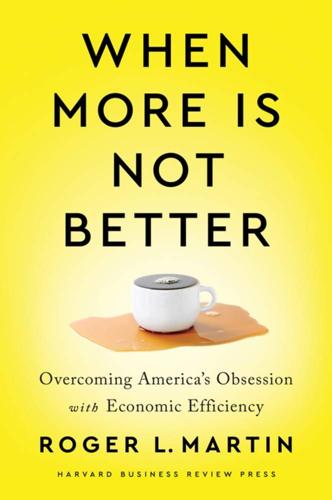
When More Is Not Better: Overcoming America's Obsession With Economic Efficiency
by
Roger L. Martin
Published 28 Sep 2020
And it was suffering from high unemployment—in fact the seventh consecutive year of unemployment above 6 percent, a level high enough for policy makers to feel the need for significant intervention. I had been taught that it was not possible for a long period of high unemployment such as the US economy was experiencing to produce anything but slowed, not accelerating, inflation—based on the Phillips curve, which was taught as fact, at least in the Harvard economics department at the time. At that point I had an epiphany: even though my distinguished professors taught me economics earnestly as if it were the truth (i.e., how the US economy actually worked) and warned against people who taught wrongly about the workings of the US economy (e.g., the dreaded monetarists), my professors actually taught me only one model for how to interpret the workings of the US economy.
…
See New York Stock Exchange Obamacare, 92 Office of the Superintendent of Financial Institutions (OFSI), 139–141 off-shoring, 155 oligopolies, 63 optimal financial structure, 173 options trading, 55 outsourcing, 155 Pareto, Vilfredo, 59 Pareto distribution, 46, 57, 59–76, 100 challenge of, 75–76 in companies, 71–73 of income, 161–162 monocultures and, 73–75 Parker, Jeffrey, 86 Parkland shooting, 197 participatory budgeting, 199–200 Penner, Elliot, 188 perfection, 103–106, 113, 126 performance management, 173 Pershing Square, 158 Persona Project, 2, 4, 14–16, 206 Phillips curve, 24 pitch-count restrictions, 102 platform businesses, 71 policy making long-term thinking and, 155–159 mental proximity and, 145–149 revision and, 142–145 political economy, 38 political leaders, 113–114 agenda for, 137–163 political parties, 92, 201–205 political relationships, 197–200 politicians, 197–205 politics, disengagement from, 3, 198 Porter, Michael, 17, 67, 128 power, abuse of, 152–153 power blackouts, 106–107 Power Law distribution.

How Markets Fail: The Logic of Economic Calamities
by
John Cassidy
Published 10 Nov 2009
In making this argument, Friedman correctly identified a weak point in the Keynesian consensus. During the 1960s, many Keynesian economists, relying on data first collated by A.W.H. (“Bill”) Phillips, of LSE, came to believe that there was an inverse relationship between unemployment and inflation. The Phillips Curve, as it came to be known, appeared to imply that if policymakers were willing to put up with a bit more inflation, they could reduce unemployment. Friedman begged to differ. If the government brought unemployment down to below its natural rate, he argued, workers would bid up wages and firms would raise prices, which would cause inflation to pick up.
…
“There is always a temporary trade-off between inflation and unemployment,” Friedman said. “There is no permanent trade-off.” In 1967, and for a few years after, Friedman’s argument didn’t go anywhere. Fine-tuning appeared to be working pretty well. In 1971, Richard Nixon described himself as “a Keynesian in economics.” But as the 1970s progressed, the Phillips Curve broke down. The inflation rate jumped into the double digits, but unemployment didn’t fall; it went up—a phenomenon that became known as stagflation. Mainstream Keynesians were at a loss to explain what was happening. Friedman and the Columbia economist Edmund Phelps, who had helped to pioneer the concept of a natural rate of unemployment, looked like visionaries.
…
Newton, Isaac New York Cotton Exchange New Yorker, The New York Mets baseball team New York State Common Retirement Fund New York Stock Exchange New York Times, The Book Review New York University (NYU) Stern School of Business New York Yankees baseball team Nightingale, Florence “NINJA” mortgage loans Nixon, Richard Nobel Prize noise traders Nordhaus, William Northern Rock Norway Nothaft, Frank Obama, Barack Objectivist Newsletter, The October Revolution oligopoly “On an Economic Equation System and a Generalization of the Brouwer Fixed Point Theorem” (von Neuman) O’Neal, Stan On Liberty (Mill) Only Yesterday (Allen) “On the Economic Theory of Socialism” (Lange) “On the Impossibility of Informationally Efficient Markets” (Grossman and Stiglitz) Organisation for Economic Cooperation and Development Organization of Petroleum Exporting Countries (OPEC) O’Rourke, Kevin O’Toole, Bob Ove Arup Ownit Mortgage Solutions Oxford University Pacific Investment Management Company Padilla, Mathew paradox of thrift Pareto, Vilfredo Pareto efficiency Parker Brothers Pasternak, Boris Paulson, Henry “Hank” Pearl Harbor, Japanese attack on Pender, Kathleen Penn Square Bank Pennsylvania, University of, Wharton School of Business Pentagon Papers, The Pericles Phelps, Edmund Philadelphia 76ers basketball team Philippines Phillips, A. W. (“Bill”) Phillips Curve Pickens, T. Boone Pigou, Arthur C. Pindyck, Robert S. Pinochet, Augusto Plato Plender, John Poland policy ineffectiveness proposition polychlorinated biphenyls (PCBs) Ponzi finance Poor Law Amendment Act (1834) Popov, Vladimir PortalPlayer, Inc. Posner, Richard Poulakakos, Harry Poulakakos, Peter Poundstone, William Prechter, Robert predictability, illusion of Prescott, Edward C.
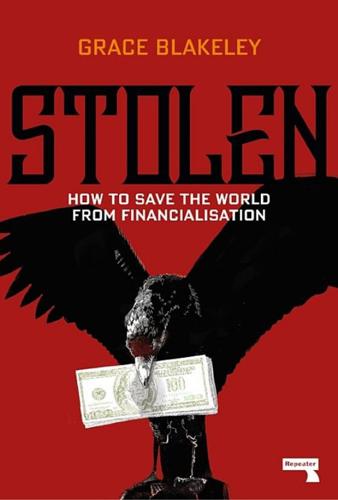
Stolen: How to Save the World From Financialisation
by
Grace Blakeley
Published 9 Sep 2019
The state flitted between increasing spending to alleviate unemployment and cutting it to reduce inflation. The oil price spike had created a catch-22 situation that Keynesian policymakers were not equipped to deal with: stagflation — the combination of unemployment and inflation. This was not supposed to happen. Keynesian economics was based on the idea of the Phillips Curve. In the 1960s, economists drew on the work of William Phillips to posit an inverse relationship between inflation and unemployment. According to the models they built, when unemployment was high, inflation was low, and vice versa, implying that states should tolerate moderate levels of inflation in order to promote full employment.20 Governments were supposed to boost spending and reduce interest rates until full employment was reached, at which point they should start to reduce spending and raise interest rates in order to bring down inflation.
…
Her main weapon was to be the new economic ideology of monetarism: the theory that governments can control inflation by controlling the money supply. The growing attractiveness of monetarism emerged out of Keynesianism’s failure to explain the concurrent increases in inflation and unemployment of the 1970s.18 According to the Phillips Curve, there should have been a trade-off between these two variables — and for most of the post-war period there was — but this relationship broke down in the 1970s. Expanding government spending would have been the solution to rising unemployment, but reducing it would have been the response to inflation — with both happening at the same time, the Keynesians were stuck.
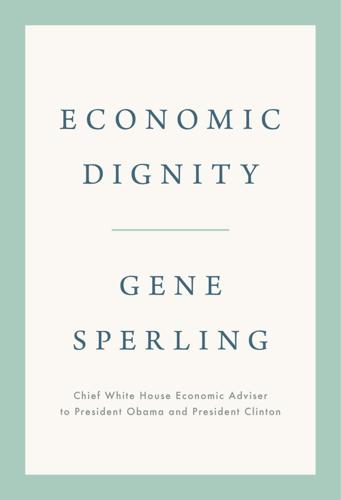
Economic Dignity
by
Gene Sperling
Published 14 Sep 2020
The theory is that as unemployment goes down, employers need to offer higher wages to attract workers. Because these higher wages translate to higher costs for businesses, this theory predicts that businesses will raise their prices, leading to inflation. This relationship between unemployment and inflation is known among economists as the Phillips curve. The Federal Reserve has traditionally operated on the assumption that some version of this relationship holds in the short run. As a result, when unemployment starts to fall, the Fed will respond by raising interest rates to avoid inflation rather than keeping rates low in order to take every possible step to reach full employment.
…
As a result, when unemployment starts to fall, the Fed will respond by raising interest rates to avoid inflation rather than keeping rates low in order to take every possible step to reach full employment. In recent years, there has been renewed advocacy—including by the Fed Up campaign spearheaded by Ady Barkan—for monetary policy tilted far more toward an aggressive full-employment focus. Some of this has been based on recent evidence that the Phillips curve is broken: that unemployment can be driven lower and lower than previously thought without sparking an uptick in inflation. A more basic critique, however, is that conventional monetary economics have overweighted the fears of inflation compared with the vast benefits of tight labor markets with the economy at full employment, including the power of workers to demand more respectful treatment at work.119 In much the same way, expansionary fiscal policy—think government spending and stimulus—is often the most powerful tool to promote full employment by boosting the economic demand.
…
Hodges, 18 Ocasio-Cortez, Alexandria, 103 Occupational Safety and Health Administration (OSHA), 71, 73, 74–75, 235 OECD (Organisation for Economic Cooperation and Development), 35, 50, 96, 121, 129, 132, 183–84, 198, 249, 285 offshoring, 128, 139–41, 295 oil, 5, 71–72, 116 Oldham, Greg, 226–27 Oliver, John, 238 Oman–United States Free Trade Agreement, 123 On the Clock (Guendelsberger), 236–37 opioid addictions, 60, 61, 96, 206, 315n Opportunity@Work, 284 Oreopoulos, Philip, 273 Orszag, Peter, 9, 247 Osterman, Paul, 283 Oxfam, 80, 81, 249 paid family and medical leave, 34–37, 96, 310n Palladino, Lenore, 119, 121 Parks, Rosa, xviii patents, 98–99, 124 “pattern bargaining,” 253–54 Paul, Rand, 93 Paycheck, Johnny, 243–44 payday lending, 84–85 Pell Grants, 54, 55, 111, 275 Pelosi, Nancy, 166, 179 Pepsi, 263 Perkins, Frances, 69–71, 158 personal bankruptcies, 9, 49–50 personal care aides, 217–20 pesticide use, 76 Petersen, Anne Helen, 238 Petronijevic, Uros, 273 Philippon, Thomas, 115 Phillips curve, 266–67 Piche-Lichtman, Michelle, 92–93 Pinto, Sergio, 60 Pisano, Gary, 140 Pittston Coal strike, 68 Platform to Employment (P2E), 213–14 Pollock v. Williams, 260–61 Poo, Ai-jen, 15, 72, 74–75, 218, 257 positive dignity, 16, 23–26 Posse Foundation, 276–77, 289–90 poultry workers, 80–82 poverty, 33–34, 36, 50, 52, 61, 67–68, 171, 213, 272.

The Quiet Coup: Neoliberalism and the Looting of America
by
Mehrsa Baradaran
Published 7 May 2024
In 1975, future Nobel laureate Franco Modigliani and future Greek prime minister Lucas Papademos elaborated on the “natural rate” theory to propose an equation called non-accelerating inflation rate of unemployment (NAIRU), which has since become a core feature of monetary policy. Based on NAIRU and the Phillips curve, a model devised by the British-based economist William Phillips, neoliberal economists predicted a direct correlation between unemployment and monetary inflation. Based on these theories, which remain contested, neoliberal economists proposed that the remedy to inflation was to drive up unemployment.
…
If economics was a science resembling natural sciences like physics or chemistry, as Friedman insisted it was, then it followed that economists like himself were just measuring and theorizing toward discovering some preexisting truth about the state of the world. Just as planets in orbit followed Newton’s laws of gravity, earthly phenomena like unemployment and inequality could not resist the Phillips curve. The distribution of wealth and poverty among the nations of the world could not be altered by man-made laws, but only measured, studied, and explained by trained economists. Except, unlike the laws of motion studied by physicists, man-made policies like European social welfare programs or American mortgage subsidies had in fact changed the form, shape, and motion of the economy.
…
Olin Foundation Olson, Theodore, 137, 149 “one man, one vote,” xxiv, 54, 341 Onion, The, xxvi Opendoor, 326 opiate pandemic, xx opportunity, 365 Orange County, Calif., 19 Oregon, 214 Organization of the Petroleum Exporting Countries (OPEC), 47–48, 50, 60, 61, 70 original intent, 145, 157 originalism, 130, 134–36, 138, 139, 141–52, 154–57, 163, 174, 175, 179 Origins of Totalitarianism, The (Arendt), 35 Orwell, George, xxxiii Ostrom, Elinor, 172 Other People’s Money and How the Bankers Use It (Brandeis), 254–55 Oxford University, 344 OxyContin, 108 Pacific Gas and Electric Company (PG&E), xiii–xiv, xviii–xxii, xxxiv Pacific Research Institute, 92 Paine, Thomas, 364 Common Sense, 40 Pakistan, 39 Palestine Liberation Organization (PLO), 41 Pan-Africanism, 43 Pandit, Vikram, 261, 290 Papademos, Lucas, 64 paperwork reduction, 236 Paperwork Reduction Act (1980), 237 Paradise, Calif., xiii Paraguay, 165–66 Pareto, Vilfredo, 169–70, 266 Pareto efficiency, 170 Pareto’s theorem, 224 Paris, France, 42, 43 Parks, Rosa, xxxii patents, 205, 274 Patman, Wright, 199 patriarchy, xxix, 177 Paulson, Henry, 289, 291–93, 295, 301, 307, 309, 317 pawn shops, 213 payday lending, 92, 179–80, 208, 212–15 PAYGO spending limits, 238 PayPal, 326 PBS, 94 pedophile rings, xxiv pensions, 216, 271, 288 Pentagon Papers, 62 personal responsibility, 176, 217 Personal Responsibility and Work Opportunity Act (1996), 231 Peru, 55 Pew Research Center, 213 pharmaceutical companies, xix, xx, xxiii, 108 Philadelphia Plan, 73–74 Philipson, Tomas Private Choices and Public Health: The AIDS Epidemic in an Economic Perspective, 176–78 Phillip Morris, 86, 88, 92, 105 Phillips, Channing, 78 Phillips, William, 64 Phillips curve, 64 Phillips-Fein, Kim, 88 Piereson, James, 156–57 Pierson, Paul, 215 Pill, the, 38, 138, 140 “pink-collar” work, xvii Pinochet, Augusto, 54, 55, 227 Pistor, Katarina, 274 Planck, Max, 23 “plandemic,” xxiii Planned Parenthood v. Casey, 154–55 Plessy v. Ferguson, 101, 126, 143, 144, 155 Polanyi, Karl The Great Transformation, 240–41 Polanyi, Michael, 240 police and police departments, 5–6, 117–18 political action committees (PACs), xxiii–xxiv, 91 political corruption.
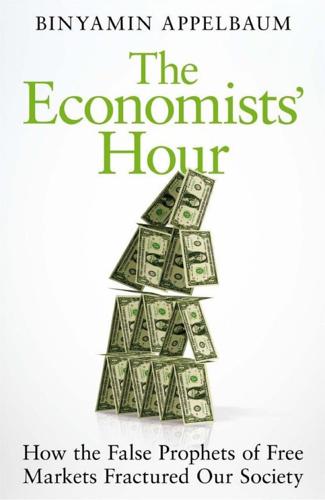
The Economists' Hour: How the False Prophets of Free Markets Fractured Our Society
by
Binyamin Appelbaum
Published 4 Sep 2019
The economist A. W. Phillips plotted the relationship between unemployment and wages in the United Kingdom over the previous century, and found wages tended to rise when unemployment was low. Enthusiastically conflating correlation and causation, economists concluded governments could glide up and down a “Phillips curve,” trading off unemployment and inflation. In an influential paper published in 1960, Samuelson and Robert Solow, two of the most important economists of the postwar era, said the American government could choose from a “menu” of unemployment and inflation rates. The available options included 5 to 6 percent unemployment with no inflation or, if one preferred, 3 percent unemployment with 4 to 5 percent inflation.12 In Great Britain, one economist recalled a meeting in the early 1960s that devolved into an emotional confrontation between those wanting to limit unemployment to 1.25 percent and those favoring 1.75 percent: “There was a figure called Professor Frank Paish who proposed 2.5 percent, who was regarded as, more or less, a Nazi.”13 Washington’s embrace of economics began in the engine rooms of government.
…
The economic historian Robert Gordon argues intriguingly that Friedman was influenced by the close ties between the University of Chicago economics department and Latin America, where it was obvious that inflation and unemployment did not have a predictable relationship. See Robert J. Gordon, “The History of the Phillips Curve: Consensus and Bifurcation,” Economica 78, no. 309 (2011): 10–50. Another economist, Edmund Phelps, separately arrived at conclusions similar to Friedman’s at around the same time. Phelps’s work was more technically sophisticated; Friedman was the better publicist. In any event, both men acknowledged they were reviving an older idea.
…
See Mac Taylor, “Common Claims About Proposition 13,” California Legislative Analyst’s Office, September 2016. 47. Kemp introduced legislation in April 1977 to cut personal income tax rates by 30 percent. He credited “the recommendations of Professor Robert Mundell on how to break free of the Phillips curve to reach low unemployment with low inflation.” In June 1977, Roth, also a Republican, agreed to sponsor a Senate version on the condition that the cut was spread across three years. This had the effect of reducing the total tax cut to 27 percent, but not of eliminating the general practice of describing the measure as a 30 percent reduction. 48.

Irrational Exuberance: With a New Preface by the Author
by
Robert J. Shiller
Published 15 Feb 2000
Investors must therefore base their judgments on basic principles on which most experts seem always to agree. The evidence used by experts to predict the relative returns on broad asset classes has little immediacy for most people. Experts talk about the potential actions of the Federal Reserve Board in Washington, about shifts in the Phillips curve, or about distortions on aggregate earnings caused by inflation and conventional accounting procedures. Most individuals have little interest in such esoterica. And yet investors must make some decisions. What factors might then enter into one’s mind when making a decision about how much to put into the stock market?
…
See also Defined benefit pension plans; Defined contribution pension plans; Retirement plans Pepper prices, 246n1 Per capita national income, 219, 222 Perez, Carlos Andres, 125–26 Perfect foresight price. See Dividend present value Perpetual futures, 230 Persian Gulf War, 28, 212 Personal income, 4 Peru, 126 Peso crisis, 128–29 Petersen, James, 254n5 Pheromone recruitment, 159 Philippines, 123–24 Phillips curve, 55 Pitz, Gordon, 255n14 Pliny the Younger, 246n1 Polaroid Corporation, 178–79 Pollution, 212–13 Ponzi, Charles, 64, 65–66 Ponzi processes, naturally occurring, 44, 67. See also Feedback systems Ponzi schemes, 35, 64–67, 245n30 Porter, Richard, 184 INDEX Portfolio insurance, 92–93, 95 Poterba, James, 78, 80 Pound, John, 154, 166 PPI (Producer Price Index), 235–36n2 Prechter, Robert, 89 Precipitating factors, 17–43, 237–42n1–38.

Termites of the State: Why Complexity Leads to Inequality
by
Vito Tanzi
Published 28 Dec 2017
These developments were seen as direct challenges to the original optimism and to a key postulate of the Keynesian framework, the Phillips curve. Supporters of the then prevailing Keynesian orthodoxy (though not necessarily the work of Keynes himself ) had assumed that there would be a trade-off between the unemployment rate and the inflation rate. A higher unemployment rate was expected to reduce the inflation rate, and vice versa. This relationship had been called the Phillips curve, named after the economist who had first described it. Keynesian economists had not considered it likely that a relatively high inflation rate could coexist with a high and increasing unemployment rate.
…
See Limited role of government Minimum wages, 145–46 Ministrant functions, 98–99 “Misery index,” 61 Mises, Ludwig von, 64, 70–71, 258 Mitterrand, François, 342 Modernity, problems of, 153 Modigliani, Franco, 3 Mokyr, Joel, 346 Monetary policy central banks and, 188 importance of, 395–96 income redistribution and, 197 stabilization policies and, 238, 242, 244 Monopolies intellectual property and, 345–47, 356, 365 market distortion and, 167 natural monopolies, regulations and, 147 “too big to fail” and, 79–80 Monopolistic governments, 65 Montesquieu, 218, 305 Moral hazard, 138, 156–57, 255–56 Moral rules versus legal rules, 333 Index Morris, Charles R., 357–58 Mortgage crisis, 107–8, 116, 140–41 Mundell, Robert, 394 Musgrave, Richard generally, 3–5, 7–8 on constitutions, 266 on import duties, 15–16 on income redistribution, 220 on public goods, 176–77 on regulations, 278 on role of government, 110, 162, 168, 187, 189 in School of Public Choice, 5, 6 Mussolini, Benito, 5, 27, 248, 252, 266–67, 279 Myrdal, Gunnar, 10, 20–21, 51–52, 64, 111, 118 “Nanny states,” 209–10 Napoleon, 267–68 “National champions,” 74, 245–46 National Rifle Association, 275 Natural monopolies, regulations and, 147 Negative income tax, 212 Netherlands, marginal tax rates in, 376 “New aristocracy,” 399 “New wisdom,” 399–400 New Zealand challenges to welfare policies in, 60 influence of conservatives in, 395 marginal tax rates in, 376 public institutions in, 291, 292 public ownership in, 136 public spending in, 121–22, 162 regulations in, 174 supply-side economics in, 77 “Nirvana error,” 151 Nitti, F.S., 28 Non-basic goods, 48 Non-basic needs, 45–46 Normative approach to role of government generally, 3–4, 313–14 complexity and, 110 market failures and, 110–11 politics and, 111 in US, 110 North, Douglass C., 265 Norway executive compensation in, 364 public spending in, 162 welfare policies in, 50 Nozick, Robert, 7–8, 60–61, 98 Nudges, 36, 65, 97 Nuisance regulations, 144–45 Obama, Barack, 9, 98, 196–97, 208, 275 Occupational licensing, 124–26 439 Occupy Wall Street, 29 Oceana (NGO), 149–50 Oil crisis, 6–7 Olson, Mancur, 71, 130, 183, 339 “On Liberty” (Mill), 147 Oracle, 347 Organization of Economic Co-operation and Development (OECD), 149, 241–42, 278, 296–97 Outsourcing, 112 Pacioli, Luca, 291 Pakistan, Constitution, 270 Panama Papers, 370 Pareto, Vilfredo, 28, 37, 63, 318–19 Pareto Optimum, 217–18 Pareto Welfare Criterion, 318–19 Patents, 347, 359, 361 Paternalistic governments, 65 Paternalistic regulations, 36 Peacock, Alan, 5, 6, 60–61, 313–14 Pensions resistance to changing policies, 222–23 in US, 222–23 Performance-based compensation, 363–64 Performers, 204–5 Persson, Torsten, 286 Peru, Gini coefficient in, 317 Pharmaceutical industry, 115–17, 158, 365–66 Pharmaceutical Research and Manufacturers of America, 171 Phillips curve, 61 Pigou, A.C., 184, 185 Piketty, Thomas, 340–42 “Piñata capitalism,” 115 Piracy, 360 Plato, 302, 305 Plutarch, 218, 302 Policy tools overview, 142–43 authorizations, 137, 144–45 certifications, 137 conscription, 136 contingent liabilities, 137–41 expropriation, 136 fees and fines, 142 nudges, 141–42.

Slouching Towards Utopia: An Economic History of the Twentieth Century
by
J. Bradford Delong
Published 6 Apr 2020
Wight, Oil Money: Middle East Petrodollars and the Transformation of US Empire, Ithaca, NY: Cornell University Press, 2021. 8. Jonathon Hazell, Juan Herreño, Emi Nakamura, and Jón Steinsson, “The Slope of the Phillips Curve: Evidence from U.S. States,” National Bureau of Economic Research (NBER) working paper 28005, issue date October 2020, revised May 2021, available at NBER, www.nber.org/papers/w28005; Olivier Blanchard, “The U.S. Phillips Curve: Back to the 60s?,” Peterson Institute for International Economics, January 2016, www.piie.com/publications/pb/pb16-1.pdf. 9. John A. Farrell, Richard Nixon: The Life, New York: Doubleday, 2017. 10.
…
Their plan only half worked: unemployment did indeed rise—from 3.5 percent to almost 6 percent between 1969 and 1971, but inflation barely budged. This outcome presented a great mystery. Up until this point, it looked as though the US economy had been sliding back and forth along a stable inflation-unemployment “Phillips curve” (named after economist A. William Phillips). Democratic governments tended to spend more time at the left end of the curve, with relatively low unemployment. Republican governments tended to spend more time at the right end, with relatively low inflation and higher unemployment. But by both absolute standards and historical standards, both inflation and unemployment were low.

Age of Greed: The Triumph of Finance and the Decline of America, 1970 to the Present
by
Jeff Madrick
Published 11 Jun 2012
Before Friedman, Keynesians had assumed that the unemployment rate could be lowered by improving the rate of economic growth and creating jobs without causing more than a gradual increase in inflation. Businesses would only raise prices modestly to preserve profit margins if their labor costs rose more rapidly than output per hour of work. The relationship was known as a Phillips curve, named for the British economist who discovered a similar relationship. Slightly higher inflation was thought to be worth it if it meant more jobs. But Friedman argued that there was no such thing as a slight increase in inflation as unemployment dropped below its normal, or as some later called it, natural rate.
…
At the time, the contention was regarded skeptically by most economists. Were workers really that sensitive to their “real” wage—the wage after inflation? The natural rate theory caught on, however, when inflation started to rise rapidly in the mid-1970s. The rising inflation rate, indeed, did not lower the unemployment rate as the Phillips curve predicted. Stagflation resulted—high unemployment and high inflation simultaneously, as Friedman seemed to predict. Even many economists who broadly disagreed with Friedman’s politics considered it his finest hour. His theory seemed prescient. In fact, Friedman’s prescience was somewhat exaggerated.
…
Robert Oppenheimer fund, 6.1, 15.1, 15.2, 17.1 options, 6.1, 15.1, 15.2, 17.1 Organization Man, The (Whyte), 12.1 Organization of Petroleum Exporting Countries (OPEC), 2.1, 3.1, 6.1, 9.1, 12.1 Oxley, Michael Paine Webber, 5.1, 12.1, 15.1, 17.1 Paley, Babe Paley, William panic of 1819 panic of 1907 Paramount Pictures, 8.1, 8.2, 16.1 Partnoy, Frank, 15.1, 17.1, 17.2, 17.3, 17.4 Patman, Wright Paulson, Henry, 19.1, 19.2, 19.3, 19.4 Paulson, John, 15.1, 19.1, 19.2 pay option adjustable rate mortgages (POAs), 18.1, 18.2 Peltz, Nelson Penn Central, 1.1, 1.2, 3.1, 6.1, 6.2, 6.3 pension funds, 4.1, 4.2, 6.1, 6.2, 13.1, 13.2, 13.3, 15.1, 16.1, 17.1, 17.2, 17.3, 18.1, 18.2, 19.1 Perella, Joseph Perelman, Ron, 4.1, 13.1, 15.1 Peters, Tom, x, 12.1, 12.2, 12.3, 12.4, 12.5, 12.6, 12.7 Peterson, Pete, 4.1, 18.1, 19.1 Petito, Frank petrodollars, 6.1, 11.1, 19.1 Philippon, Thomas Phillips, Kevin Phillips curve Phillips Petroleum, 5.1, 13.1 Pickens, T. Boone, 4.1, 13.1, 13.2, 13.3, 13.4, 15.1 piggy-back loans Pirie, Robert Plaza Accord (1985), 11.1, 15.1 Polanyi, Michael polychlorinated biphenyls (PCBs) Popper, Karl, 2.1, 15.1 Posner, Richard Posner, Victor Potoma, Peter pounds sterling, 15.1, 15.2, 15.3, 15.4, 15.5 poverty, itr.1, prl.1, prl.2, prl.3, 1.1, 2.1, 2.2, 2.3, 3.1, 3.2, 3.3, 7.1, 7.2, 7.3, 7.4, 8.1, 10.1, 11.1 prepayments, mortgage prepay swaps Preston, Lewis price controls, 2.1, 2.2, 3.1, 3.2, 3.3, 3.4, 3.5, 3.6, 9.1, 9.2, 14.1, 19.1 price-earnings (P-E) multiples, 1.1, 1.2, 4.1, 4.2, 12.1, 16.1, 17.1 price levels, prl.1, 1.1, 2.1, 2.2, 2.3, 2.4, 2.5, 3.1, 3.2, 3.3, 3.4, 6.1, 6.2, 6.3, 6.4, 8.1, 8.2, 8.3, 9.1, 9.2, 9.3, 9.4, 10.1, 11.1, 11.2, 12.1, 14.1, 14.2, 14.3, 14.4, 14.5, 16.1, 19.1 prime lending rate, 6.1, 9.1, 11.1 Primerica, 16.1, 16.2, 16.3 Prince, Chuck, 17.1, 17.2, 19.1, 19.2, 19.3, 19.4, 19.5 Principles of Economics (Marshall), 2.1 Principles of Scientific Management, The (Taylor), 12.1 product development, 2.1, 4.1, 12.1, 12.2, 12.3, 12.4, 12.5, 12.6, 12.7, 12.8, 12.9, 13.1, 16.1, 19.1 “Production Trends in the United States” (Burns) productivity, 2.1, 2.2, 8.1, 9.1, 9.2, 11.1, 12.1, 13.1, 14.1, 17.1, 19.1 profits, x, 1.1, 1.2, 2.1, 2.2, 3.1, 3.2, 4.1, 4.2, 4.3, 5.1, 5.2, 5.3, 5.4, 5.5, 8.1, 8.2, 8.3, 12.1, 14.1, 15.1, 15.2, 15.3, 15.4, 17.1, 17.2, 17.3, 17.4, 18.1, 18.2, 18.3, 18.4, 19.1, 19.2, 19.3, 19.4, 19.5 Proposition 1, prl.1, 7.1, 10.1 Proposition 4 Proposition 13, 9.1, 9.2, 10.1 Proxmire, William Prudential Insurance, 16.1, 16.2 “puts,” 244 quantitative easing “quants” (analytical models), 15.1, 15.2, 15.3, 15.4, 15.5, 18.1 Quantum Fund, 15.1, 15.2 quarterly earnings, 12.1, 16.1 Quattrone, Frank, 17.1, 17.2, 17.3, 17.4 railroads, prl.1, 1.1, 1.2, 2.1, 3.1, 5.1, 8.1, 9.1 Raines, Franklin, 18.1, 19.1 Rand, Ayn, prl.1, 2.1, 3.1, 3.2, 14.1, 14.2 Ranieri, Lewis, 18.1, 18.2, 18.3, 19.1, 19.2 RCA, 8.1, 8.2, 12.1, 12.2 Reagan, Jack, 7.1, 7.2, 7.3 Reagan, Nancy, 7.1, 7.2, 7.3, 7.4 Reagan, Ronald, 6.1, 7.1, 7.2; anticommunism of, prl.1, 7.3, 7.4, 7.5, 7.6, 7.7; background of, prl.1, 7.8, 7.9, 7.10, 8.1; as conservative, prl.1, prl.2, 7.11, 7.12; as Democrat, 7.13, 7.14, 7.15, 7.16, 7.17, 7.18; deregulation supported by, 11.1, 12.1, 12.2, 14.1, 16.1, 16.2, 18.1; economic policies of, 5.1, 6.2, 6.3, 7.19, 7.20, 7.21, 8.2, 8.3, 8.4, 8.5, 8.6, 9.1, 10.1, 10.2, 11.2, 11.3, 11.4, 13.1, 13.2, 14.2, 14.3, 14.4, 14.5, 14.6, 14.7; “evil empire” speech of, 7.22; as FBI informant, 7.23; Friedman’s influence on, 7.24, 7.25, 7.26; as GE spokesman, 7.27, 11.5, 12.3; as governor of California, prl.1, 7.28, 7.29, 7.30, 7.31, 10.3, 10.4; gubernatorial campaign of (1966), 3.1, 7.32, 7.33; individualism supported by, 7.34, 7.35; marriages of, 7.36, 7.37, 7.38; memoirs of, 7.39, 7.40, 7.41, 7.42, 7.43, 7.44; Nixon compared with, 7.45, 7.46, 7.47, 7.48; personality of, prl.1, 7.49, 7.50, 7.51; as political leader, prl.1, prl.2, 7.52, 7.53, 11.6, 11.7; as president, 3.2, 7.54, 11.8, 11.9; presidential campaign of (1976), 7.55; presidential campaign of (1980), 7.56, 11.10; religious convictions of, 7.57, 7.58, 7.59, 7.60, 7.61, 7.62; as Republican, 7.63, 7.64, 7.65, 11.11; as SAG president, 7.66, 7.67; The Speech (“A Time for Choosing”) delivered by, 7.68, 11.12; speeches by, 7.69, 7.70, 11.13; tax policies of, ix–x, 2.1, 7.71, 7.72, 7.73, 7.74, 7.75, 7.76, 7.77, 10.5, 11.14, 11.15, 11.16, 11.17, 14.8; as television host, 7.78, 7.79; Uhler and, prl.1, 7.80, 7.81; welfare programs opposed by, 7.82, 7.83, 7.84, 7.85, 7.86; working class support for, 7.87, 7.88, 7.89, 7.90, 7.91 real estate, 1.1, 1.2, 3.1, 4.1, 5.1, 6.1, 6.2, 6.3, 6.4, 6.5, 9.1, 11.1, 12.1, 12.2, 12.3, 13.1, 14.1, 14.2, 15.1, 15.2, 15.3, 16.1, 16.2, 18.1 real estate investment trusts (REITs), 6.1, 15.1, 16.1 recessions, 1.1, 2.1, 2.2, 2.3, 2.4, 2.5, 3.1, 3.2, 3.3, 3.4, 4.1, 4.2, 6.1, 6.2, 6.3, 6.4, 6.5, 8.1, 9.1, 11.1, 11.2, 11.3, 11.4, 11.5, 11.6, 11.7, 13.1, 13.2, 14.1, 14.2, 15.1, 15.2, 15.3, 15.4, 15.5, 16.1, 16.2, 17.1, 18.1, 18.2, 18.3, 18.4, 19.1, 19.2, 19.3, 19.4 Recovery Ahead!
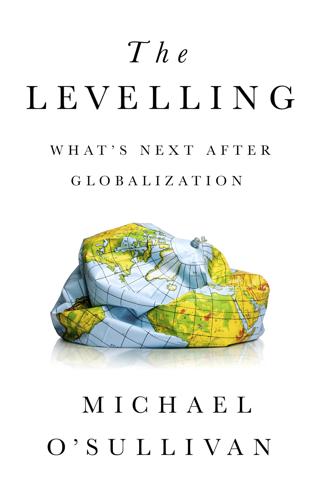
The Levelling: What’s Next After Globalization
by
Michael O’sullivan
Published 28 May 2019
The creation of a super finance ministry, or EU Treasury, by the mid 2020s is one of the stated goals of the European Commission, among a number of other institutional initiatives.5 These are to be welcomed, but they must not be carried out for the sake of giving politicians greater powers; rather, they should be implemented with a sense for how Europe’s economies work in harmony with each other. With his genius for communication, Hamilton might recommend that Europe’s leaders examine its financial system as if it were a system of pipes. A flow-based view of an economy is an intuitive one, and it has some credence. Readers might be familiar with the term “Phillips Curve,” which is based on the research that New Zealand economist Bill Phillips carried out on the link between unemployment and inflation. Well before he was celebrated for this, however, Phillips built an extraordinary machine that pumped colored water through glass vessels in order to demonstrate how money flows around an economic system.
…
See future outlook Overton, Richard, 85–87, 88, 93 Paine, Thomas, 85, 94 Pakenham, Thomas, 229–230 paradigm shifts, 71–72, 73, 74 Peace of Westphalia, 17, 240–241 Pence, Mike, 289 people changes and upheaval, 6–7, 9–10, 25–28, 37, 47 and the constitution, 280–282 contract with elites, 4 expectations, 25 as levellers, 12–13 in next levelling, 77–78, 80, 306 Perkins, Frances, 291 Perón, Juan, 156 personal data, on internet, 273 Petri, Elio, 68 Pettit, Philip, 86 Pew Research Center, 39, 43, 49 Phillips, Bill, and Phillips’s machine, 283–284 “Phillips Curve,” 283 physical infrastructure programs, 149–151 Pilgrim Party (fictional), 122–123 poles in multipolar world aims and ethos of poles, 222 China, 18–19, 222, 223–224, 279, 288–295 description and distinctiveness, 215–216, 221–223 Eastasia, 225, 226–230 Eurasia, 225, 233–237 Europe, 279, 280–288 ideologies, 243 and international institutions, 262–264 in levelling, 238, 243 Oceania, 225–226 Orwell’s classification, 225 specific countries in, 218–219, 220–222 US and US-led Americas, 222, 223, 225–226, 279, 295–302 policy populism, 156 political discontent, 12 political parties and crises, 105–107 fictional examples, 119–125 formation and success, 114–119 new parties, 110–111, 113–115, 119–120 old parties and disruption, 111–114 protest-oriented parties, 107 right-wing and radical parties, 54–55, 105–107 and technology, 115 trust in, 51, 53–54 politicians biopoliticians idea, 128, 129–131 and business cycle, 138–140 and change, 134 Chidley, Katherine (see Chidley, Katherine) economic growth promise, 155–156 entrenchment, 126 faith in, 51–52, 54–55 family ties, 130 insiders vs. outsiders, 126–128, 129–130 labeling, 128 and Levellers, 85–86, 87, 95–96 new candidates and entrants, 103–104, 110, 111, 125–127, 128–131, 306 and special causes, 129 trust in, 51, 53–54 vision, 157 politics and Agreements of the People, 13 and anomie, 147 and change, 104, 105–107, 133–134 and communications, 107 dislocation and pessimism, 52–55 disruption, 111–114 and economy, 51–52, 105–106 and government, 108–109 international (see geopolitics) Levellers as model, 96, 97, 98 new ideas, 110–111, 116 in next levelling, 78–79, 80, 116–119, 305–306 old order breakdown, 5 public goods, 157 replacement and transition, 8, 116–119 and social media, 108–109 sortition, 109–110 and trade, 34, 35–36 voter estrangement, 108–109 Polyani, Karl, 301 Pope, Carl, 272 Popper, Karl, 72, 73, 93–94 populism, 93, 101, 156 postal service, 49 Pottinger, Henry, 84–85 Prince, Thomas, 87 productivity and economy, 141, 142–144 lack and drop, 142–147 and Levellers, 146–147 protectionism, 32, 34, 64 Prussia, war, 227 public goods, 157 Puritanism and Liberty (Woodhouse), 85 Putin, Vladimir, 160, 218 Putney Debates, 3–4, 12, 82, 84–85, 91 “QE inequality,” 190 the Quad (Quadrilateral Security Dialogue alliance), 244–245 Quah, Danny, 212 quantitative easing (QE) central banks, 16–18, 174–179, 183, 190 consequences, 44, 175, 177–178 and currency, 177 description, 175–176 and investment, 178–179 and markets, 181–183 as problem, 16–18 restrictions on, 208 as solution, 149, 175 and wealth inequality, 180–181 radical and right-wing parties, 54–55, 105–107 railway stocks and bubbles, 171 Rainsborough, Thomas, 81, 84, 87, 91, 100 Reagan, Ronald, 107 Rees, John, 83 regions of the world.
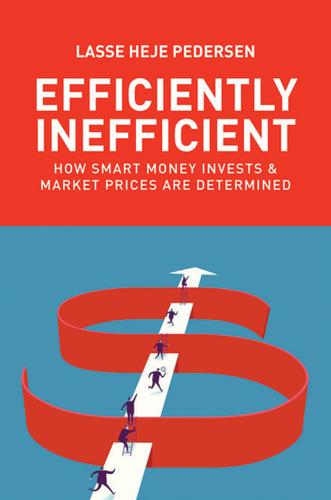
Efficiently Inefficient: How Smart Money Invests and Market Prices Are Determined
by
Lasse Heje Pedersen
Published 12 Apr 2015
Unemployment means fewer hands adding to the country’s output. Similarly, output depends on the utilization rate of capital, meaning whether machines are idle or running at full speed. Short-run economic dynamics are therefore closely connected to unemployment, and unemployment is related to inflation. The “Phillips curve” states that, in the short run, inflation increases with employment (as well as with expectations about future inflation). Since the supply of output increases with employment, output supply is also positively related to inflation in the short run, and this relation is represented as the aggregate supply (AS) curve in figure 11.2.
…
See prime brokers (PBs) pegged currencies, 186–87, 190 pension funds: asset allocation by, 168, 169–70; demand pressure on bonds due to, 249, 252, 255; discretionary equity investing by, 96; Scholes on, 263, 265 performance attribution, 37–38 performance fee, 21–22, 38 performance measures, 27–38; adjusting for illiquidity and stale prices, 36–37; annualizing, 33–34; estimating, 32–33; gross versus net of transaction costs and fees, 38; introduction to, 27–29; risk–reward ratios, 29–32; time horizons and, 33–35, 33t. See also return; Sharpe ratio (SR) performance of hedge funds, 22–24 peso problem, 186–87 Phillips curve, 193 PIPEs (private investments in public equity), 291, 313 P&L. See profits and losses (P&L) Platinum Grove Asset Management, 262, 268 policy portfolio, 167, 168. See also strategic asset allocation political events: global macro developments and, 199–200; Soros on importance of, 204 portfolio, replicating, 234–35, 237, 239–40 portfolio construction, 54–57; Ainslie on, 110; Asness on, 133, 160; Chanos on, 131; components of, 167; in event-driven investment, 292; in fundamental quantitative investing, 144–45; industry-neutral, 144; in merger arbitrage, 303–4; in quantitative investing, 133.

Capitalism in America: A History
by
Adrian Wooldridge
and
Alan Greenspan
Published 15 Oct 2018
The price of U.S. crude oil rose over ninefold between 1972 and 1981, sending shock waves through corporate America, starting with big energy consumers such as domestic transportation, oil refining, chemicals, steel, aluminum, and international shipping, but including the whole of the corporate world. Above all, the oil shock entrenched America’s biggest economic problem. Stagflation was a toxic combination of rising inflation and unemployment that Keynesian economists, citing the Phillips curve, which postulated a fixed trade-off between inflation and unemployment, said could never happen. In the fourteen-year stretch between 1969 and 1982, the annual rate of inflation only fell below 5 percent twice, and for four of those years it was in double digits, hitting 14.8 percent in March 1980.
…
(musical), 111 Olson, Mancur, 300 Omidyar, Pierre, 3, 355 O’Neill, Paul, 368 Oregon, 5, 40 Otis, Elisha Graves, 110 Otis Elevator, 110 Owens-Corning Fiberglass, 265 “ownership society,” 372–73 Pacific Mail, 138 Packard, David, 352 Page, Larry, 354–55, 356 Palmisano, Samuel, 347 Pan Am, 286–87, 335 panic of 1819, 42 panic of 1893, 42, 43, 154, 192, 237 panic of 1907, 42, 131, 425 Papageorgis, Joann, 412 Paris Commune, 162 partnerships, 134 Pasteur, Louis, 430 Patent Act of 1790, 48 Patent Office, U.S., 48, 73, 98–99, 147 patents, 3, 8–9, 45–46, 48, 73, 98–99, 391, 397 issued for inventions (1901–2000), 148 Patterson, John Henry, 422 PayPal, 423, 439 penicillin, 284 Pennsylvania Railroad, 137, 138, 206 People’s Party, 172–73 per capita income (PCI), 84, 92 Perkins, George, 106–7 Perkins, Jacob, 38 Permanent Normal Trade Relations (PNTR), 346 Perot, Ross, 230, 344 personal computers (PCs), 350–51, 353–54 Pfizer, 312, 324 philanthropy, 126, 164, 357 Philip Crosby Associates, 344–45 Philip Morris, 290–91 Phillips curve, 309 Piggly Wiggly, 215–16 Pinckney, Charles Cotesworth, 67 Pittsburgh Steam Engine Company, 52 plows, 33, 47, 72–73 plutocracy, 3, 169 polio vaccines, 284 politics (politicians), 12, 23–26 cult of government, 176–79 Pollock v. Farmer’s Loan & Trust Company, 159 pollution, 168–69, 427, 429 Pomperipossa effect, 440 Pony Express, 19–20, 49–50 Poor, Henry Varnum, 138 population growth, 11, 40–41, 95, 300 populism, 25, 69, 172–73, 245–46, 297, 344, 415 “post-industrial society,” 360–61 Post Office, U.S., 154, 199–200, 251 post–World War II economic expansion, 270–72, 273–98 potholes vs. progress, 394–98 Potter, David, 295 Pratt, Francis, 72 presidential passivity, 157–59 Prince, Charles, 382 prison labor, 87–88 Procter & Gamble, 118–19, 263, 288, 391 productivity, 12–13, 122, 195, 269, 290–93, 453–54 sources of, 14–21 productivity growth, 4, 273–75, 301, 301, 387, 387, 403 Professional Air Traffic Controllers Organization (PATCO), 327–28 professional managers, 207–9 Progressive Era, 25, 165, 176–79, 182, 188, 189, 240–41, 251 Prohibition, 192, 197, 263 property rights, 8, 159–60 protectionism, 7, 194, 230–31, 232, 343–44 Protestant Reformation, 7, 69 Protestant work ethic, 44 Public Broadcasting Act of 1967, 303 Public Works Administration (PWA), 244 Pujo, Arsène, 185 Pullman Company, 144 Pullman Strike of 1894, 154, 173 Pure Food and Drug Act of 1906, 182–83 Puritans, 7, 60 “pursuit of happiness,” 8 pursuit of self-interest, 6–7 Quaker Oats, 92, 320 Quakers, 60 quants, 381–82 racism, 89, 295 radio, 202–4, 316 Radio Corporation of America (RCA), 203–4, 316, 320 “railroaded,” 172 railroads, 53–55, 96–98, 112–15, 121, 136–38, 139, 166–67, 197–98, 265 first refrigerated cars, 119 first transcontinental, 16, 18, 90, 114 miles of railroad built, 96–97, 97 Rand, Ayn, 277–78 Rand, Remington, 350–51 Random House, 320 Ransom, Roger, 85 Raskob, John, 221, 222–23 ratio analysis, 340 Ratzel, Friedrich, 88–89 Raytheon, 283, 349 Reagan, Ronald, 26, 248, 324, 325, 326–31, 344, 391, 406 Reaganomics, 330–31 regulations, 255–58, 328–29, 411–15, 412, 416, 425 resource constraints, 10–11 resource revolution, 48–49 retirement age, 404, 441, 442–43 Revolutionary War, 5–6, 31, 34–35, 38–40, 62, 69, 266, 266 Revson, Charles, 264–65 Riesman, David, 295, 296 Riggio, Leonard, 341 “Rip Van Winkle” (Irving), 40 risk management paradigm, 383–84 Road to Serfdom, The (Hayek), 26, 277 robber barons, 124–33, 167–68, 170–71, 356 Roberts, George, 341 Rockefeller, John D., 17, 103, 124, 125–26, 128–30, 136, 142–43, 164, 167–68, 187, 190 Rockefeller University, 126 Rockoff, Hugh, 186, 187 Roebuck, Alvah, 141–42 Rogers, Will, 239, 243 Roosevelt, Franklin D., 234–35, 237, 239–62 fireside chats, 204, 240, 243, 252 New Deal, 25–26, 225–26, 242–62, 415 wartime renaissance, 266, 268–70 Roosevelt, Theodore, 110, 124, 153, 179, 181–85, 268, 427 “Rosie the Riveter,” 363 rubber, 47, 110, 198–99 Rubin, Robert, 332 Rumsfeld, Donald, 306, 368 russet potato, 118 Rust Belt, 321–23, 366 Sanders, Harland, 197, 443 San Francisco–Oakland Bay Bridge, 90 Santa Clara County v.
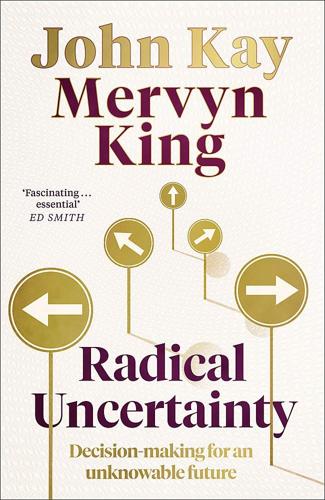
Radical Uncertainty: Decision-Making for an Unknowable Future
by
Mervyn King
and
John Kay
Published 5 Mar 2020
And the 1950s and 1960s appeared to be a golden age of stability and growth in the global economy. But the foundations were much less secure than appearances suggested. Inflation accelerated slowly throughout much of the post-war period, and by the 1970s had challenged the complacent view that Keynesian demand management could eliminate economic instability. The Phillips curve (another invention of the creator of the eponymous machine) related wage increases to unemployment, and claimed to be a stable empirical relationship like the consumption function. 3 It implied a long-run trade-off between inflation and unemployment; the price of reducing one was to increase the other.
…
INDEX 10 (film, 1979), 97 737 Max aircraft, 228 9/11 terror attacks, 7 , 74–6 , 202 , 230 Abbottabad raid (2011), 9–10 , 20 , 26 , 44 , 71 , 102 , 118–19 , 120 , 174–5 ; reference narrative of, 122–3 , 277 , 298 ; role of luck in, 262–3 ; and unhelpful probabilities, 8–19 , 326 abductive reasoning, 138 , 147 , 211 , 388 , 398 ABN AMRO, 257 Abraham (biblical character), 206 Abrahams, Harold, 273 Abramovich, Roman, 265 accountancy, 409 aeronautics, 227–8 , 352–6 , 383 Agdestein, Simen, 273 AIDS, 57 , 230 , 375–6 Airbus A380, 40 , 274–6 , 408 Akerlof, George, 250–1 , 252 , 253 , 254 , 382 Alchian, Armen, 158 alien invasion narratives, 295–6 Allais, Maurice, 134–5 , 136 , 137 , 437 , 440–3 Allen, Bill, 227–8 Allen, Paul, 28 , 29 Altair desktop, 28 Amazon, 289 , 309 Anderson, Roy, 375 ant colonies, 173 anthropology, 160 , 189–91 , 193–4 , 215–16 antibiotics, 40 , 45 , 284 , 429 Antz (film, 1998), 274 apocalyptic narratives, 331–2 , 335 , 358–62 Appiah, Anthony, 117–18 Apple, 29–30 , 31 , 169 , 309 Applegarth, Adam, 311 arbitrage, 308 Archilochus (Greek poet), 222 Aristotle, 137 , 147 , 303 Arrow, Kenneth, 254 , 343–5 , 440 artificial intelligence (AI), xvi , 39 , 135 , 150 , 173–4 , 175–6 , 185–6 , 387 ; the ‘singularity’, 176–7 Ashtabula rail bridge disaster (1876), 33 Asimov, Isaac, 303 asteroid strikes, 32 , 71–2 , 238 , 402 astrology, 394 astronomical laws, 18–19 , 35 , 70 , 373–4 , 388 , 389 , 391–2 , 394 AT&T, 28 auction theory, 255–7 Austen, Jane, 217 , 224–5 , 383 autism, 394 , 411 aviation, commercial, 23–4 , 40 , 227–8 , 274–6 , 315 , 383 , 414 axiomatic rationality: Allais disputes theory, 134–5 , 136 , 137 ; Arrow– Debreu world, 343–5 ; assumption of transitivity, 437 ; and Becker, 114 , 381–2 ; and behavioural economics, 116 , 135–6 , 141–9 , 154–5 , 167–8 , 386–7 , 401 ; capital asset pricing model (CAPM), 307–8 , 309 , 320 , 332 ; completeness axiom, 437–8 ; consistency of choice axiom, 108–9 , 110–11 ; continuity axiom, 438–40 ; definition of rationality, 133–4 , 137 , 436 ; definition of risk, 305 , 307 , 334 , 420–1 ; efficient market hypothesis, 252 , 254 , 308–9 , 318 , 320 , 332 , 336–7 ; efficient portfolio model, 307–8 , 309 , 318 , 320 , 332–4 , 366 ; and evolutionary rationality, 16 , 152–3 , 154–5 , 157 , 158 , 166–7 , 171–2 , 386–7 , 407 ; and ‘expectations’ concept, 97–8 , 102–3 , 121–2 , 341–2 ; extended to decision-making under uncertainty, xv , 40–2 , 110–14 , 133–7 , 257–9 , 420–1 ; and Friedman, 73–4 , 111–12 , 113–14 , 125 , 257–9 , 307 , 399–400 , 420 , 437 ; hegemony of over radical uncertainty, 40–2 , 110–14 ; implausibility of assumptions, xiv–xv , 16 , 41–4 , 47 , 74–84 , 85–105 , 107–9 , 111 , 116–22 , 344–9 , 435–44 ; independence axiom, 440–4 ; as limited to small worlds, 170 , 309–10 , 320–1 , 342–9 , 382 , 400 , 421 ; and Lucas, 36 , 92 , 93 , 338–9 , 341 , 345 , 346 ; and Markowitz, 307 , 308 , 309–10 , 318 , 322 , 333 ; maximising behaviour, 310 ; ‘pignistic probability’, 78–84 , 438 ; and Popperian falsificationism, 259–60 ; Prescott’s comparison with engineering, 352–6 ; ‘rational expectations theory, 342–5 , 346–50 ; and Samuelson, xv , 42 , 110–11 , 436 ; and Savage, 111–14 , 125 , 257–9 , 309 , 345 , 400 , 435 , 437 , 442–3 ; shocks and shifts discourse, 42 , 346 , 347 , 348 , 406–7 ; Simon’s work on, 134 , 136 , 149–53 ; triumph of probabilistic reasoning, 15–16 , 20 , 72–84 , 110–14 ; Value at risk models (VaR), 366–8 , 405 , 424 ; von Neumann–Morgenstern axioms, 111 , 133 , 435–44 ; see also maximising behaviour Ballmer, Steve, 30 , 227 Bank of England, xiii , 45 , 103–5 , 286 , 311 Barclays Bank, 257 Barings Bank, 411 Basel regulations, 310 , 311 Bay of Pigs fiasco (1961), 278–9 Bayes, Reverend Thomas, 60–3 , 66–7 , 70 , 71 , 358 , 431 Beane, Billy, 273 Bear Stearns, 158–9 Becker, Gary, 114 , 381–2 Beckham, David, 267–8 , 269 , 270 , 272–3 , 414 behavioural economics, 116 , 145–8 , 154 , 386–7 ; and Allais paradox, 442 ; ‘availability heuristic’, 144–5 ; biases in human behaviour, 16 , 136 , 141–8 , 154 , 162 , 165 , 167–8 , 170–1 , 175–6 , 184 , 401 ; and evolutionary science, 154–5 , 165 ; Kahneman’s dual systems, 170–1 , 172 , 271 ; Kahneman–Tversky experiments, 141–7 , 152 , 215 ; ‘noise’ (randomness), 175–6 ; nudge theory, 148–9 Bentham, Jeremy, 110 Berkshire Hathaway, 153 , 319 , 324 , 325–6 Berlin, Isaiah, 222 Bernoulli, Daniel, 114–16 , 199 Bernoulli, Nicolaus, 199 , 442 Bertrand, Joseph, 70 Bezos, Jeff, 289 big data, 208 , 327 , 388–90 billiard players, 257–8 bin Laden, Osama, 7 , 8–10 , 21 , 44 , 71 , 118–19 , 120 , 122–3 , 262–3 , 326 Bismarck, Otto von, 161 Bitcoin, 96 , 316 Black Death, 32 , 39–40 BlackBerry, 30 , 31 blackjack, 38 Blackstone, Sir William, 213 BNP Paribas, 5 , 6 BOAC, 23–4 Boas, Franz, 193 Boeing, 24 , 227–8 Boer War, 168 Bolt, Usain, 273 bonobos, 161–2 , 178 Borges, Jorge Luis, 391 Borodino, battle of (1812), 3–4 , 433 Bortkiewicz, Ladislaus, 235–6 Bower, Tom, 169–70 Bowral cricket team, New South Wales, 264 Box, George, 393 Boycott, Geoffrey, 264–5 Bradman, Don, 237 , 264 Brahe, Tycho, 388–9 Brånemark, Per-Ingvar, 387 , 388 Branson, Richard, 169–70 Brearley, Michael, 140–1 , 264–5 Breslau (now Wrocław), 56 Brexit referendum (June 2016), 241–2 ; lies told during, 404 bridge collapses, 33 , 341 Brownian motion, 37 Brunelleschi, Filippo, 143 , 147 Buffett, Warren, 83 , 152 , 179 , 319–20 , 324 , 335 , 336–7 Burns, Robert, 253 Bush, George W., 295 , 407 , 412 business cycles, 347 business history (academic discipline), 286 business schools, 318 business strategy: approach in 1970s, 183 ; approach in 1980s, 181–2 ; aspirations confused with, 181–2 , 183–4 ; business plans, 223–4 , 228 ; collections of capabilities, 274–7 ; and the computer industry, 27–31 ; corporate takeovers, 256–7 ; Lampert at Sears, 287–9 , 292 ; Henry Mintzberg on, 296 , 410 ; motivational proselytisation, 182–3 , 184 ; quantification mistaken for understanding, 180–1 , 183 ; and reference narratives, 286–90 , 296–7 ; risk maps, 297 ; Rumelt’s MBA classes, 10 , 178–80 ; Shell’s scenario planning, 223 , 295 ; Sloan at General Motors, 286–7 ; strategy weekends, 180–3 , 194 , 296 , 407 ; three common errors, 183–4 ; vision or mission statements, 181–2 , 184 Buxton, Jedediah, 225 Calas, Jean, 199 California, 48–9 Cambridge Growth Project, 340 Canadian fishing industry, 368–9 , 370 , 423 , 424 cancer, screening for, 66–7 Candler, Graham, 352 , 353–6 , 399 Cardiff City Football Club, 265 Carlsen, Magnus, 175 , 273 Carnegie, Andrew, 427 Carnegie Mellon University, 135 Carré, Dr Matt, 267–8 Carroll, Lewis, Through the Looking-Glass , 93–4 , 218 , 344 , 346 ; ‘Jabberwocky’, 91–2 , 94 , 217 Carron works (near Falkirk), 253 Carter, Jimmy, 8 , 119 , 120 , 123 , 262–3 cartography, 391 Casio, 27 , 31 Castro, Fidel, 278–9 cave paintings, 216 central banks, 5 , 7 , 95 , 96 , 103–5 , 285–6 , 348–9 , 350 , 351 , 356–7 Central Pacific Railroad, 48 Centre for the Study of Existential Risk, 39 Chabris, Christopher, 140 Challenger disaster (1986), 373 , 374 Chamberlain, Neville, 24–5 Chandler, Alfred, Strategy and Structure , 286 Chariots of Fire (film, 1981), 273 Charles II, King, 383 Chelsea Football Club, 265 chess, 173 , 174 , 175 , 266 , 273 , 346 Chicago economists, 36 , 72–4 , 86 , 92 , 111–14 , 133–7 , 158 , 257–8 , 307 , 342–3 , 381–2 Chicago Mercantile Exchange, 423 chimpanzees, 161–2 , 178 , 274 China, 4–5 , 419–20 , 430 cholera, 283 Churchill, Winston: character of, 25–6 , 168 , 169 , 170 ; fondness for gambling, 81 , 168 ; as hedgehog not fox, 222 ; on Montgomery, 293 ; restores gold standard (1925), 25–6 , 269 ; The Second World War , 187 ; Second World War leadership, 24–5 , 26 , 119 , 167 , 168–9 , 170 , 184 , 187 , 266 , 269 Citibank, 255 Civil War, American, 188 , 266 , 290 Clapham, John, 253 Clark, Sally, 197–8 , 200 , 202 , 204 , 206 Clausewitz, Carl von, On War , 433 climate systems, 101–2 Club of Rome, 361 , 362 Coase, Ronald, 286 , 342 Cochran, Johnnie, 198 , 217 Cochrane, John, 93 coffee houses, 55–6 cognitive illusions, 141–2 Cohen, Jonathan, 206–7 Colbert, Jean-Baptiste, 411 Cold War, 293–4 , 306–7 Collier, Paul, 276–7 Columbia disaster (2003), 373 Columbia University, 117 , 118 , 120 Columbus, Christopher, 4 , 21 Colyvan, Mark, 225 Comet aircraft, 23–4 , 228 communication: communicative rationality, 172 , 267–77 , 279–82 , 412 , 414–16 ; and decision-making, 17 , 231 , 272–7 , 279–82 , 398–9 , 408 , 412 , 413–17 , 432 ; eusociality, 172–3 , 274 ; and good doctors, 185 , 398–9 ; human capacity for, 159 , 161 , 162 , 172–3 , 216 , 272–7 , 408 ; and ill-defined concepts, 98–9 ; and intelligibility, 98 ; language, 98 , 99–100 , 159 , 162 , 173 , 226 ; linguistic ambiguity, 98–100 ; and reasoning, 265–8 , 269–77 ; and the smartphone, 30 ; the ‘wisdom of crowds’, 47 , 413–14 Community Reinvestment Act (USA, 1977), 207 comparative advantage model, 249–50 , 251–2 , 253 computer technologies, 27–31 , 173–4 , 175–7 , 185–6 , 227 , 411 ; big data, 208 , 327 , 388–90 ; CAPTCHA text, 387 ; dotcom boom, 228 ; and economic models, 339–40 ; machine learning, 208 Condit, Phil, 228 Condorcet, Nicolas de, 199–200 consumer price index, 330 , 331 conviction narrative theory, 227–30 Corinthians (New Testament), 402 corporate takeovers, 256–7 corporations, large, 27–31 , 122 , 123 , 286–90 , 408–10 , 412 , 415 Cosmides, Leda, 165 Cretaceous–Paleogene extinction, 32 , 39 , 71–2 Crick, Francis, 156 cricket, 140–1 , 237 , 263–5 crime novels, classic, 218 crosswords, 218 crypto-currencies, 96 , 316 Csikszentmihalyi, Mihaly, 140 , 264 Cuba, 278–80 ; Cuban Missile Crisis, 279–81 , 299 , 412 Custer, George, 293 Cutty Sark (whisky producer), 325 Daily Express , 242–3 , 244 Damasio, Antonio, 171 Dardanelles expedition (1915), 25 Darwin, Charles, 156 , 157 Davenport, Thomas, 374 Dawkins, Richard, 156 de Havilland company, 23–4 Debreu, Gerard, 254 , 343–4 decision theory, xvi ; critiques of ‘American school’, 133–7 ; definition of rationality, 133–4 ; derived from deductive reasoning, 138 ; Ellsberg’s ‘ambiguity aversion’, 135 ; expected utility , 111–14 , 115–18 , 124–5 , 127 , 128 – 30 , 135 , 400 , 435–44 ; hegemony of optimisation, 40–2 , 110–14 ; as unable to solve mysteries, 34 , 44 , 47 ; and work of Savage, 442–3 decision-making under uncertainty: and adaptation, 102 , 401 ; Allais paradox, 133–7 , 437 , 440–3 ; axiomatic approach extended to, xv , 40–2 , 110–14 , 133–7 , 257–9 , 420–1 ; ‘bounded rationality concept, 149–53 ; as collaborative process, 17 , 155 , 162 , 176 , 411–15 , 431–2 ; and communication, 17 , 231 , 272–7 , 279–82 , 398–9 , 408 , 412 , 413–17 , 432 ; communicative rationality, 172 , 267–77 , 279–82 , 412 , 414–16 ; completeness axiom, 437–8 ; continuity axiom, 438–40 ; Cuban Missile Crisis, 279–81 , 299 , 412 ; ‘decision weights’ concept, 121 ; disasters attributed to chance, 266–7 ; doctors, 184–6 , 194 , 398–9 ; and emotions, 227–9 , 411 ; ‘evidence-based policy’, 404 , 405 ; excessive attention to prior probabilities, 184–5 , 210 ; expected utility , 111–14 , 115–18 , 124–5 , 127 , 128–30 , 135 , 400 , 435–44 ; first-rate decision-makers, 285 ; framing of problems, 261 , 362 , 398–400 ; good strategies for radical uncertainty, 423–5 ; and hindsight, 263 ; independence axiom, 440–4 ; judgement as unavoidable, 176 ; Klein’s ‘primed recognition decision-making’, 399 ; Gary Klein’s work on, 151–2 , 167 ; and luck, 263–6 ; practical decision-making, 22–6 , 46–7 , 48–9 , 81–2 , 151 , 171–2 , 176–7 , 255 , 332 , 383 , 395–6 , 398–9 ; and practical knowledge, 22–6 , 195 , 255 , 352 , 382–8 , 395–6 , 405 , 414–15 , 431 ; and prior opinions, 179–80 , 184–5 , 210 ; ‘prospect theory’, 121 ; public sector processes, 183 , 355 , 415 ; puzzle– mystery distinction, 20–4 , 32–4 , 48–9 , 64–8 , 100 , 155 , 173–7 , 218 , 249 , 398 , 400–1 ; qualities needed for success, 179–80 ; reasoning as not decision-making, 268–71 ; and ‘resulting’, 265–7 ; ‘risk as feelings’ perspective, 128–9 , 310 ; robustness and resilience, 123 , 294–8 , 332 , 335 , 374 , 423–5 ; and role of economists, 397–401 ; Rumelt’s ‘diagnosis’, 184–5 , 194–5 ; ‘satisficing’ (’good enough’ outcomes), 150 , 167 , 175 , 415 , 416 ; search for a workable solution, 151–2 , 167 ; by securities traders, 268–9 ; ‘shock’ and ‘shift’ labels, 42 , 346 , 347 , 348 , 406–7 ; simple heuristics, rules of thumb, 152 ; and statistical discrimination, 207–9 , 415 ; triumph of probabilistic reasoning, 20 , 40–2 , 72–84 , 110–14 ; von Neumann– Morgenstern axioms, 111 , 133 , 435–44 ; see also business strategy deductive reasoning, 137–8 , 147 , 235 , 388 , 389 , 398 Deep Blue, 175 DeepMind, 173–4 The Deer Hunter (film, 1978), 438 democracy, representative, 292 , 319 , 414 demographic issues, 253 , 358–61 , 362–3 ; EU migration models, 369–70 , 372 Denmark, 426 , 427 , 428 , 430 dentistry, 387–8 , 394 Derek, Bo, 97 dermatologists, 88–9 Digital Equipment Corporation (DEC), 27 , 31 dinosaurs, extinction of, 32 , 39 , 71–2 , 383 , 402 division of labour, 161 , 162 , 172–3 , 216 , 249 DNA, 156 , 198 , 201 , 204 ‘domino theory’, 281 Donoghue, Denis, 226 dotcom boom, 316 , 402 Doyle, Arthur Conan, 34 , 224–5 , 253 Drapers Company, 328 Drescher, Melvin, 248–9 Drucker, Peter, Concept of the Corporation (1946), 286 , 287 Duhem–Quine hypothesis, 259–60 Duke, Annie, 263 , 268 , 273 Dulles, John Foster, 293 Dutch tulip craze (1630s), 315 Dyson, Frank, 259 earthquakes, 237–8 , 239 Eco, Umberto, The Name of the Rose , 204 Econometrica , 134 econometrics, 134 , 340–1 , 346 , 356 economic models: of 1950s and 1960s, 339–40 ; Akerlof model, 250–1 , 252 , 253 , 254 ; ‘analogue economies’ of Lucas, 345 , 346 ; artificial/complex, xiv–xv , 21 , 92–3 , 94 ; ‘asymmetric information’ model, 250–1 , 254–5 ; capital asset pricing model (CAPM), 307–8 , 309 , 320 , 332 ; comparative advantage model, 249–50 , 251–2 , 253 ; cost-benefit analysis obsession, 404 ; diversification of risk, 304–5 , 307–9 , 317–18 , 334–7 ; econometric models, 340–1 , 346 , 356 ; economic rent model, 253–4 ; efficient market hypothesis, 252 , 254 , 308–9 , 318 , 320 , 332 , 336–7 ; efficient portfolio model, 307–8 , 309 , 318 , 320 , 332–4 , 366 ; failure over 2007–08 crisis, xv , 6–7 , 260 , 311–12 , 319 , 339 , 349–50 , 357 , 367–8 , 399 , 407 , 423–4 ; falsificationist argument, 259–60 ; forecasting models, 7 , 15–16 , 68 , 96 , 102–5 , 347–50 , 403–4 ; Goldman Sachs risk models, 6–7 , 9 , 68 , 202 , 246–7 ; ‘grand auction’ of Arrow and Debreu, 343–5 ; inadequacy of forecasting models, 347–50 , 353–4 , 403–4 ; invented numbers in, 312–13 , 320 , 363–4 , 365 , 371 , 373 , 404 , 405 , 423 ; Keynesian, 339–40 ; Lucas critique, 341 , 348 , 354 ; Malthus’ population growth model, 253 , 358–61 , 362–3 ; misuse/abuse of, 312–13 , 320 , 371–4 , 405 ; need for, 404–5 ; need for pluralism of, 276–7 ; pension models, 312–13 , 328–9 , 405 , 423 , 424 ; pre-crisis risk models, 6–7 , 9 , 68 , 202 , 246–7 , 260 , 311–12 , 319 , 320–1 , 339 ; purpose of, 346 ; quest for large-world model, 392 ; ‘rational expectations theory, 342–5 , 346–50 ; real business cycle theory, 348 , 352–4 ; role of incentives, 408–9 ; ‘shift’ label, 406–7 ; ‘shock’ label, 346–7 , 348 , 406–7 ; ‘training base’ (historical data series), 406 ; Value at risk models (VaR), 366–8 , 405 , 424 ; Viniar problem (problem of model failure), 6–7 , 58 , 68 , 109 , 150 , 176 , 202 , 241 , 242 , 246–7 , 331 , 366–8 ; ‘wind tunnel’ models, 309 , 339 , 392 ; winner’s curse model, 256–7 ; World Economic Outlook, 349 ; see also axiomatic rationality; maximising behaviour; optimising behaviour; small world models Economic Policy Symposium, Jackson Hole, 317–18 economics: adverse selection process, 250–1 , 327 ; aggregate output and GDP, 95 ; ambiguity of variables/concepts, 95–6 , 99–100 ; appeal of probability theory, 42–3 ; ‘bubbles’, 315–16 ; business cycles, 45–6 , 347 ; Chicago School, 36 , 72–4 , 86 , 92 , 111–14 , 133–7 , 158 , 257–8 , 307 , 342–3 , 381–2 ; data as essential, 388–90 ; division of labour, 161 , 162 , 172–3 , 216 , 249 ; and evolutionary mechanisms, 158–9 ; ‘expectations’ concept, 97–8 , 102–3 , 121–2 , 341–2 ; forecasts and future planning as necessary, 103 ; framing of problems, 261 , 362 , 398–400 ; ‘grand auction’ of Arrow and Debreu, 343–5 ; hegemony of optimisation, 40–2 , 110 – 14 ; Hicks–Samuelson axioms, 435–6 ; market fundamentalism, 220 ; market price equilibrium, 254 , 343–4 , 381–2 ; markets as necessarily incomplete, 344 , 345 , 349 ; Marshall’s definition of, 381 , 382 ; as ‘non-stationary’, 16 , 35–6 , 45–6 , 102 , 236 , 339–41 , 349 , 350 , 394–6 ; oil shock (1973), 223 ; Phillips curve, 340 ; and ‘physics envy’, 387 , 388 ; and power laws, 238–9 ; as practical knowledge, 381 , 382–3 , 385–8 , 398 , 399 , 405 ; public role of the social scientist, 397–401 ; reciprocity in a modern economy, 191–2 , 328–9 ; and reflexivity, 35–6 , 309 , 394 ; risk and volatility, 124–5 , 310 , 333 , 335–6 , 421–3 ; Romer’s ‘mathiness’, 93–4 , 95 ; shift or structural break, 236 ; Adam Smith’s ‘invisible hand’, 163 , 254 , 343 ; social context of, 17 ; sources of data, 389 , 390 ; surge in national income since 1800, 161 ; systems as non-linear, 102 ; teaching’s emphasis on quantitative methods, 389 ; validity of research findings, 245 ‘Economists Free Ride, Does Anyone Else?’
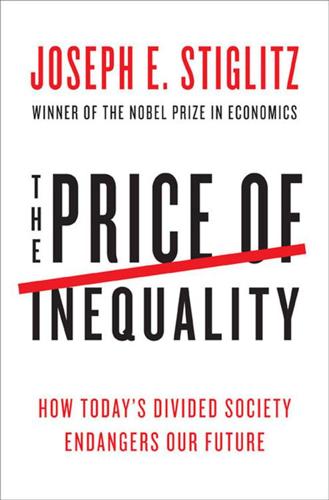
The Price of Inequality: How Today's Divided Society Endangers Our Future
by
Joseph E. Stiglitz
Published 10 Jun 2012
That requires that the deceleration of inflation from an increase in unemployment is weaker than the acceleration of inflation from a decrease in unemployment. See Stiglitz, “Reflections on the Natural Rate Hypothesis.” There is a huge literature on the hypothesis that, in the long run, the relationship between the acceleration of inflation and unemployment is vertical (“the vertical Phillips curve”). See, in particular, Edmund S. Phelps, “Phillips Curves, Expectations of Inflation and Optimal Employment over Time,” Economica, n.s., 34, no. 3 (1967): 254–81; and Milton Friedman, “The Role of Monetary Policy,” American Economic Review 58, no. 1 (1968): 1–17. 56. See, in particular, Arjun Jayadev and Mike Konczal, “The Stagnating Labor Market,” Roosevelt Institute, September 19, 2010.

Never Let a Serious Crisis Go to Waste: How Neoliberalism Survived the Financial Meltdown
by
Philip Mirowski
Published 24 Jun 2013
Most macroeconomists would rather abandon the field than admit all their technical sophistication was superfluous, and forget the lessons they learned at the feet of Robert Lucas and Thomas Sargent. The entire field was populated by people drilled in contempt for reading Keynes, and confirmed in their convictions that those 1960s-era models, like the old-fashioned IS-LM and Phillips Curve, fully deserved to be tossed on the trash heap of history. Yet, even if some magic wand waved away generations of inertia, there was no guarantee that if you reran the tape of history one more time, starting in 1969, the neoclassical orthodoxy wouldn’t just end up rejecting all those 1960s-era models all over again.
…
See Neoliberal Thought Collective (NTC) Nugent, Ted NYU (New York University) O Obama, Barack Occam’s Razor Occupiers Occupy Handbook Occupy London Occupy Movement Occupy Wall Street (OWS) Odyssey (Homer) Old Thinking Oldham, Taki, Turf Wars Open questions Open Society The Open Society and Its Enemies (Popper) Oracle at Delphi Ordoliberalism Oreskes, Naomi Original Sin O’Rourke, Kevin Orszag, Peter Orwell, George Osborne, George Outsourced Self (Hochschild) OWS (Occupy Wall Street) P Page, Scott Palin, Sarah Pareto, Vilfredo Patterson, Scott, Dark Pools Paul, Ron Paulson, Hank Payday loans Payne, Christopher PBS Peck, Jamie Pecora, Ferdinand Perry, Rick Pesaran, Hashem Pew Economic Policy Group Financial Reform Project Philip Morris Phillips Curve Philosopher’s Stone Pimco Pinochet, Augusto Pinto, Edward Pissarides, Christopher Pity the Billionaire (Frank) Plant, Raymond Plato Plehwe, Dieter Ponzi scheme Poon, Martha Popper, Karl Portes, Richard Posner, Richard Power Auctions Predator Nation (Ferguson) Prediction as red herring Prescott, Edward C.

Cogs and Monsters: What Economics Is, and What It Should Be
by
Diane Coyle
Published 11 Oct 2021
But so too did demand management policies based on the assumption that the machine metaphor of the flow of incomes around the economy—represented literally in the famous Phillips machine of Chapter Four—was the reality. It turned out that the relationships between economic variables were not mechanical and permanent, but rather were altered by the very policies that had assumed they were. Here again, economics reshaped the reality. So the seemingly reliable inverse Phillips curve relationship between unemployment and inflation—a bit less of one for a bit more of the other—broke down. Inflation increased—sharply so in the UK. At the same time, unemployment started to climb, reaching then-unprecedented post-war heights. In the UK it paved the way for the election of Mrs Thatcher in 1979, after the dreadful strikes of the Winter of Discontent.
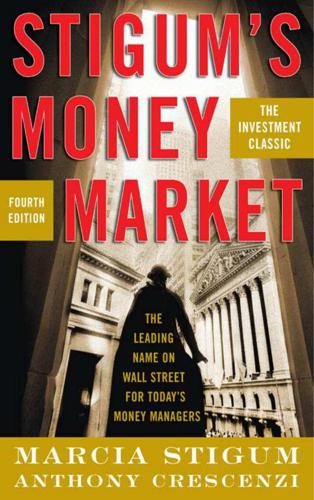
Stigum's Money Market, 4E
by
Marcia Stigum
and
Anthony Crescenzi
Published 9 Feb 2007
Specifically, it attempts to promote full employment and price stability by limiting the growth of bank intermediation when the economy expands too vigorously and by encouraging it when the economy slips into recession. To achieve these objectives, a stable predictive relationship between inflation and economic growth, often referred to as a Phillips curve, is necessary, according to many models.2 Controlling the Level of Bank Intermediation The Fed has the ability to control the level of bank intermediation—the amount of bank lending and money creating—through several tools, although its main tool is its open market operations. One of the Fed’s tools available to the Fed but which is rarely used is reserve requirements.
…
U.S. bonds European commercial paper STEP even-keeling, Fed exchange offerings, Treasury exchanges, futures exempt securities vs. regulated securities exogenous variables, banks/banking exotic interest-rate swaps expectations, bonds expiration dates, futures extended credit banks/banking discount window extension swaps, portfolios extensions, federal funds market FACO (see Farm Credit Financial Assistance Corporation) fails daisy chain dealers round robin fails game, dealers Fannie Mae (see Federal National Mortgage Association) Farm Credit Financial Assistance Corporation (FACO) Farm Credit System (FCS) Farmer Mac (see Federal Agricultural Mortgage Corporation) FASB (see Financial Accounting Standards Board) FCS (see Farm Credit System) FDIC (see Federal Deposit Insurance Corporation) features, money market Fed (see also discount window; federal funds market) adding/draining reserves attitudes, discount window bank intermediation banks/banking BAs bond market borrowed-reserves procedure Check law countercyclical monetary policy currency in circulation dealers dealers (primary dealers) defining money Depository Institutions Deregulation and Monetary Control Act DIDC discount rate discount window duties even-keeling federal agencies financial stability float fluctuations FOMC foreign central banks foreign-exchange market full accrual pricing funds rate targeting go-around Greenspan, Alan hawk/dove scale history independence inflation interest rates judgmental approach M1 Game MCA MMDAs monetarism monetarist experiment monetary policy Monetary Policy Report to Congress money supply MSPs nominal interest rates nonborrowed-reserves procedure officials tenure open market operations operation twist passes Phillips curve phraseology policy statements political pressures portfolios primary dealers raison d’être repos/reverses reserve requirements reserves-oriented operating procedure role RPDs SOMA speeches spread products structure targets tolerance ranges tools tough love transmission effects Treasury balances trusting Volcker’s Saturday Night Special watching yield curve fed funds futures Eurodollars fed funds rate control effective money supply vs. repo rate Fed statistics, repos/reverses federal agencies attraction to investors debt control failed FCS Fed FFB FSLIC GNMA S&L crisis federal agency securities distribution growth GSEs MBS volume Federal Agricultural Mortgage Corporation (Farmer Mac) Federal Deposit Insurance Corporation (FDIC) CDs discount window Federal Financing Bank (FFB) federal funds domestic treasury federal funds market (see also brokers’ market) afternoon decline in funds rate aggressive dealing “as of” transactions associated federal funds rate Bernanke, Ben borrowed reserve operating procedure brokers’ market contemporaneous reserve accounting control daylight overdrafts dealing aggressively discretionary money effective annual rate effective fed funds rate extensions fed funds rate Fedwire Funds Transfer Service former forward market heading out history liquidity effect money supply overnight money personnel policy statements rebooking reserve adjustments running a fed funds desk settlement Wednesday settling with the Fed sophistication term fed funds Wednesday close Federal Home Loan Bank System (FHLB) Federal Home Loan Mortgage Corporation (Freddie Mac) Freddie Mac pass-throughs Federal National Mortgage Association (Fannie Mae) Fannie Maes pass-throughs Federal Open Market Committee (FOMC) day-to-day operations Fed watching interest rates meetings repos/reverses structure Volcker’s Saturday Night Special Federal Reserve (see Fed) Federal Reserve Act Federal Reserve System Federal Savings and Loan Insurance Corporation (FSLIC) discount window S&L crisis federally related institutions Fedwire Funds Transfer Service vs.
…
CHIPS FFB (see Federal Financing Bank) FHCs (see financial holding companies) FHLB (see Federal Home Loan Bank System) FICC (see Fixed Income Clearing Corporation) FICO (see Financing Corporation) Financial Accounting Standards Board (FASB) asset-backed paper loan participations financial futures (see also futures) financial holding companies (FHCs) financial intermediation (see intermediation) financial options (see options) Financial Services Act (FSA) financial stability, Fed Financing Corporation (FICO) S&L crisis financing gap financing use, Treasury fine-tuning quotes, brokers’ market First Report on the Public Credit Fixed Income Clearing Corporation (FICC), Treasury securities float, Fed floating-rate CDs floating-rate MTNs floating-to-floating swaps, money market swaps flower bonds, Treasury securities FOMC (see Federal Open Market Committee) foreign-bank commercial paper foreign bank placements, Eurodollars foreign banks, discount window foreign banks in London Eurodollars regulation foreign banks in U.S., Eurodollars foreign central banks, Fed foreign currency translation risk, BAs foreign-dominated commercial paper foreign exchange, commercial paper foreign-exchange market Fed intervention foreign-exchange risk, banks/banking foreign government bonds, Treasury futures foreign official holdings, Eurodollars foreign series bonds former forward market, federal funds market forward contracts, vs. futures forward forwards forward market, repos forward price, Treasury futures forward rate agreements (FRAs) advantages Eurodollars example features interest-rate expectations interest-rate swaps jargon market money market swaps precise hedge tiering forward transactions GIC FRAs (see forward rate agreements) fraud, dealers Freddie Mac (see Federal Home Loan Mortgage Corporation) free lunch, interest-rate swaps FSA (see Financial Services Act) FSLIC (see Federal Savings and Loan Insurance Corporation) full accrual pricing, Fed functions, money market funding a bank’s assets, domestic treasury funding choices, banks/banking funds flows by sector U.S. capital market funds, money (see money funds) funds rate, fed (see fed funds rate) funds rate targeting, fed funds transfer, Fedwire Funds Transfer Service future dates, immunizing a portfolio futures (see also Treasury futures) arbitrage basics bills futures CFTC clearing function CME commissions contract size counterparty risk day traders delivery electronic trading Eurodollars exchanges expiration dates fed funds futures financial futures vs. forward contracts hedging leverage liquidity margin deposits market makers market participants performance bonds pit trading portfolio diversification portfolios price quotes regulation risk scalpers SPAN speculation tick sizes transparency utility to investors futures markets arbitrage dealers Eurodollars technical analysis futures trading volume, Treasury futures futurity, bonds games, Treasury notes gamma, options gap, financing gap management domestic treasury interest-rate futures swaps GARVEEs (see Grant Anticipation Revenue Vehicles) GCF repos (see general collateral finance repos) general collateral finance (GCF) repos General Motors Acceptance Corporation (GMAC), commercial paper general obligation (GO) bonds general obligation (GO) securities GIC (see guaranteed income contract) Ginnie Mae (see Government National Mortgage Association) Glass-Steagall Act banks/banking global banks, Eurodollars global market, Eurodollars global master repurchase agreement (GMRA), repos global swap books GlobalCash-Europe96 survey, Eurodollars globalization banks/banking communications dealers debt markets investing payments systems trading systems GMAC (see General Motors Acceptance Corporation) GMRA (see global master repurchase agreement) GNMA (see Government National Mortgage Association) go-around, Fed GO (see general obligation securities) GO (general obligation) bonds Government National Mortgage Association (GNMA) pass-through securities REMICs Government Securities Act (1986) Government Securities Division, brokers’ market government-sponsored enterprises (GSEs) growth implicit guarantee Gramm-Leach-Bliley Act banks/banking merchant banks mergers and acquisitions Grant Anticipation Revenue Vehicles (GARVEEs) Greenspan, Alan gross debt, vs. net debt GSEs (see government-sponsored enterprises) guaranteed income contract (GIC), forward transactions haircuts, repos Hamilton, Alexander hawk/dove scale, Fed heading out, federal funds market hedges with basis risk hedging calendar spreads cash-and-carry trade cross hedging curve traders dealers Eurodollars futures hedge ratio hedges with basis risk interest-rate swaps long hedge with no basis risk risk second hedge with no basis risk spreading swap books Treasury Treasury bills Treasury futures zero-coupon approach hedging positions, MTNs HIC (see hold-in-custody repos) history banks/banking BAs ECP Eurodollars Fed federal funds market loans monetarism money market banks Treasury securities hold-in-custody repos (HIC) holding companies Bank Holding Company Act banks/banking IBFs (see International Banking Facilities) IDB (see interdealer brokers) ILCs (see industrial loan corporations) IMM (see International Monetary Market) immunizing a portfolio, future dates implicit guarantee, GSEs indexes, dealers indices Lehman aggregate index Lehman Brothers Global Family of Indices industrial loan corporations (ILCs), banks/banking industrial paper, commercial paper inflation data, trading notes inflation, Fed inflation-indexed securities, Treasury securities information, market sentiment (see market sentiment) information systems, market makers informational calls, discount window inside market, dealers institutional funds, money funds institutions, portfolios insurance, options integration banks/banking Eurodollars interbank placements, Eurodollars interdealer brokers (IDB), Treasury securities Interest Equalization Tax, Eurodollars interest-rate expectations, FRAs interest-rate futures, gap management interest-rate swaps 5-year, fixed-rate asset bank/nonbank dealers banks/banking bells and whistles bogy books brokers convergence trading counterparty risk coupon swaps currency swaps dealer books dealers defining dollar interest-rate-swap market end users Eurodollars exotic FRAs free lunch hedging ISDA jargon market makers master documentation netting offsetting a deposit parallel loans plain vanilla portfolios positive-sum game profit, swap books quanto risk Street-speak trading spreads interest rates auction procedures bonds dealers, predictions Fed FOMC Japan municipal securities (munis) nominal portfolios predictions, dealers real repo rate Treasury securities yield curve ZIRP intermediation banks/banking control Fed matched/mismatched book reasons total financial assets International Banking Act International Banking Facilities (IBFs), Eurodollars International Monetary Market (IMM), IMM swap International Swap Dealers Association (ISDA), interest-rate swaps internationalization, market for Treasuries Internet, electronic trading investing, globalization investors BAs CDs commercial paper corporations, munis ECP Eurobond market Eurodollar CDs loan participations money funds municipal securities (munis) ISDA (see International Swap Dealers Association) Japan deflation ZIRP jargon FRAs interest-rate swaps judgmental approach, Fed junk bonds buyers LBO loans latent investor demand, MTNs LBO loans bear-hug LBOs fears junk bonds legislation (see also regulation) Bank Holding Company Act Bank of England Act Banking Acts Check law Depository Institutions Deregulation and Monetary Control Act Employee Retirement Income Security Act (ERISA) Federal Reserve Act FSA Glass-Steagall Act Government Securities Act (1986) Gramm-Leach-Bliley Act International Banking Act Monetary Control Act (MCA) Riegle-Neal Banking and Branch Efficiency Act Sarbanes-Oxley Act Tax Reform Act Lehman aggregate index Lehman Brothers Global Family of Indices lender of last resort, Eurodollars lenders, Eurodollars lending business banks/banking Eurodollars letter repos portfolios leverage banks/banking futures repos liabilities/assets, corporate finance liability swaps LIBID (see London Interbank Bid Rate) LIBOR (London Interbank Offered Rate) Eurodollars interest-rate swaps lifting a leg, swap books LIMEAN, Eurodollars limits, Eurodollars LIONS (investment opportunity notes) liquidity commercial paper Eurodollars futures loan participations reverse market Treasury futures liquidity effect, federal funds market liquidity enhancements, commercial paper liquidity portfolios liquidity risk, BAs loan participations FASB investors LBO loans liquidity mechanics motivations sales volume short-term, high quality loans loans (see also distribution) asset-backed paper back-to-back banks/banking bullet commercial paper, backstop lines discount window distribution domestic treasury Eurodollars floating vs. fixed rate history ILCs junk bonds LBO loans loan participations parallel loans securitization short-term, high quality syndicated loans Treasury LOC (letter of credit) paper locked market, Eurodollars London Interbank Bid Rate (LIBID), Eurodollars London preeminence, Eurodollars long hedge with no basis risk long-term rates, yield curve M&A (see mergers and acquisitions) M1 Game, Fed MCA (see Monetary Control Act) Macaulay’s duration major players, Eurodollars margin deposits, futures market intelligence, Treasury futures market liquidity, commercial paper market makers analytics systems Bloomberg Professional system clearing banks communications dealers dealers as futures information systems interest-rate swaps MTNs trading systems market participants, futures market sentiment duration money funds Treasury futures marketable Treasury securities marking to market, portfolios master documentation, interest-rate swaps master notes, commercial paper master repo agreements, defining master repurchase agreement (MRA), defining matched/mismatched book covering shorts Eurodollars facilitation device Fed statistics financial intermediaries financing the dealer’s position functions generating borrowed funds growth mismatching the book, banks profit repos reverses trading collateral matched-sale purchases (MSPs) Fed repos maturities BAs CDs MTNs maturity choice dealers domestic treasury portfolios maturity distribution, BAs maturity of securities purchased, portfolios MBS (see mortgage-backed securities) medium-term money banks/banking Eurodollars medium-term notes (MTNs) 30/360 vs. actual/360 hurdle bank deposit notes bank notes banks/banking beginnings bells and whistles commercial paper vs. corporate bonds dealers Euro MTNs floating-rate MTNs growth, market hedging positions latent borrower demand latent investor demand market makers maturities Merrill money market swaps new-issue market new issues privately placed paper product rating secondary market shelf registration yields merchant banks Eurodollars Gramm-Leach-Bliley Act syndicated loans mergers and acquisitions (M&A) corporate finance Gramm-Leach-Bliley Act Merrill CMA money funds MTNs middleware trading platforms, electronic trading mismatch strategies banks/banking Eurodollars mismatching the book (see also matched/mismatched book) banks/banking MMDAs (see money market deposit accounts) monetarism downside Fed history pitfalls monetarist experiment, Fed Monetary Control Act (MCA) Fed monetary policy Fed implementing transmission effects Monetary Policy Report to Congress, Fed money center banks money creation money, defining money funds accounting procedures assets bank trust departments banks/banking central-asset accounts CMA consumers’uses demand notes flavors growth hot money institutional funds investing in investors management fee managing market sentiment Merrill money supply municipal securities (munis) penny-rounded fund portfolios raison d’être rising rates safety of principal STIFs strategies STRIPS tax-exempt taxable-fund portfolios VRDO withdrawing funds yields money market characteristics features functions overview scope money market banks (see also banks) history money market deposit accounts (MMDAs), Fed money market funds (see money funds) money market swaps arbitrage basis swaps classic deposit notes floating-to-floating swaps FRAs IMM swap MTNs speculative vehicle swapping spreads money supply control defining Fed fed funds rate federal funds market money funds mortgage-backed, pass-through securities mortgage-backed securities (MBS) MRA (see master repurchase agreement) MSPs (see matched-sale purchases) MTNs (see medium-term notes) multicurrency commercial paper municipal bond insurance, municipal securities (munis) municipal commercial paper municipal notes [see municipal securities (munis)] municipal securities (munis) BANs book entry brokers characteristics competitively bid deals corporations investors credit enhancements credit risk credit spreads dealers disclosure equivalent taxable yield GARVEEs GOs interest rates investors issuance market technicals money funds municipal bond insurance negotiated deals new-issue market price volatility RANs ratings real-time reporting revenue securities risk RTRS secondary market TANs tax reform Tax Reform Act taxable yield taxation TRANs types VRDO WI trading yearly issuance yield yield, taxable naked trading, dealers negative-sum game, portfolios negative value basis, Treasury futures negotiable order of withdrawal (NOW) accounts, Fed net debt, vs. gross debt net financial investment, by sector net interest margin, banks/banking net repo financing netting, interest-rate swaps new-issue market CDs MTNs municipal securities (munis) new issues, MTNs NIFs (see note issuance facilities) NOB (notes over bonds) trade, Treasury futures nominal interest rates, Fed nonborrowed-reserves procedure, Fed nonmarketable Treasury securities nonmember banks, discount window note issuance facilities (NIFs), ECP notes [see also medium-term notes; municipal securities (munis)] bank notes deposit notes trading notes Treasury notes Treasury securities NOW accounts (see negotiable order of withdrawal accounts) off–balance sheet items banks/banking Eurodollars off-the-run issues, Treasury notes oil dollars OPEC, Eurodollars open interest, Treasury futures open market operations (see also Federal Open Market Committee) Fed open repos open reverses, reverse market opening, brokers’ market operation twist, Fed opportunity cost portfolios risk options Black-Scholes model call options combining delta gamma insurance portfolios price of underlying asset prices put-call parity put options replication rho risk-free-rate speculation strike price theta time to maturity trading uses value valuing vega volatility zero-sum game options trading volume, Treasury futures out trades brokers’ market risk over-the-counter derivatives markets, global turnover over-the-counter foreign exchange derivatives markets, swaps market overnight money, federal funds market overnight rates, Eurodollars overnight repo rate overview, money market own-name dealer paper, commercial paper pace/professionalism brokers Eurodollars packs, Eurodollars par bonds parallel loans, interest-rate swaps pass-through securities Fannie Maes Freddie Mac GNMA mortgage-backed private passes, Fed payments systems (see also communications) globalization penny-rounded fund, money funds pension funds debt absorption ERISA Treasury performance bonds, futures performance tracking, portfolios petrodollars, Eurodollars Phillips curve, Fed pit trading, futures plain vanilla swaps defining policy anticipation hypothesis, yield curve policy, monetary (see monetary policy) policy statements Fed federal funds market political pressures, Fed portfolio diversification, futures portfolio managers, dealers portfolios accounting hang-up arbitrage asymmetric positions, investor/issuer banks/banking big shooters break-even reverse rate compounding computer programs contrarian view credit risk dedicated domestic treasury extension swaps Fed futures institutions interest-rate swaps interest rates letter repos liquidity managing marking to market maturity choice maturity of securities purchased money funds negative-sum game opportunity cost options parameters performance tracking relative value repos restrictive guidelines reverses to maturity riding the yield curve risk short-term shorting securities small software stability of return strategies Street’s view term repos time horizon tracking performance trends unified World Bank yield curve yield spreads position limits, dealers position profits, dealers positioning, dealers positive-sum game, interest-rate swaps positive value basis, Treasury futures predictive power, yield curve preexport, BAs premium bonds prepayment BAs commercial paper present value, bonds price auctions, Treasury price fluctuations, bonds price quotes bonds futures price risk bonds dealers price sensitivity, duration price value of an 01, duration price volatility bonds municipal securities (munis) prices, options primary dealers Fed Treasury notes Treasury securities prime demise, corporate finance principal amount, Treasury futures principal investments, dealers principals, dealers private pass-throughs profit banks/banking matched/mismatched book position profits swap books Treasury notes profit sources, dealers proprietary products, dealers protocols, bill market put-call parity, options put options quanto interest-rate swaps quotes and maturities, Eurodollars quotes to retail, bill market quoting the market, brokers’ market raison d’être, Fed RANs (see Revenue Anticipation Notes) rate lid on bonds, Treasury rate risk, corporate finance rating tiering, commercial paper ratings commercial paper municipal securities (munis) REA series bonds (see Rural Electrification Administration series bonds) real estate mortgage investment conduits (REMICs), GNMA real interest rates real market bill market brokers’ market real-time reporting, municipal securities (munis) Real-Time Transaction Reporting System (RTRS), municipal securities (munis) real yields factors affecting trading notes rebooking, federal funds market recession probabilities, yield curve REFCorp (see Resolution Funding Corporation) refunding provisions, bonds regularization of debt, Treasury regulated securities, vs. exempt securities regulation (see also deregulation; legislation) Bank of England banks/banking Eurodollars foreign banks in London futures Regulation Q, Eurodollars regulatory purposes, Treasury regulatory reforms, repos relative value dealers portfolios REMICs (see real estate mortgage investment conduits) replication, options repos (see also reverses) brokering collateralized loan continuing contract credit risk dealer leverage dealer safekeeping dealers defining definitions domestic treasury Fed open market operations Fed statistics Fed use forward market full accrual pricing GCF repos GMRA Government Securities Act (1986) haircuts HIC letter repos margin market market decisions market growth master repo agreements matched/mismatched book MRA MSPs net repo financing open market operations open repos overnight repo rate portfolios regulatory reforms repo market repo rate repo rate, overnight reverse in reverse market right of substitution SEC term repos tri-party repos yield curve repurchase agreements (see repos) reputation risk, BAs reserve adjustments, federal funds market reserve requirements contemporaneous reserve accounting Fed reserves available to support private deposits (RPDs), Fed reserves-oriented operating procedure, Fed Resolution Funding Corporation (REFCorp) S&L crisis restrictive guidelines, portfolios Revenue Anticipation Notes (RANs) revenue bonds revenue securities, municipal securities (munis) reverse in dealers repos reverses (see also repos) borrowers brokering brokers dealers defining discount window Fed statistics Fed use Government Securities Act (1986) liquidity matched/mismatched book open reverses reverse market reverse rate risk SEC special collateral repo market specific issues market term reverses reverses to maturity portfolios reversing in securities, vs. borrowing securities revolving underwriting facilities (RUFs), ECP rho, options riding the yield curve, portfolios Riegle-Neal Banking and Branch Efficiency Act right of substitution, repos risk accounting hang-up arbitrage banks/banking BAs bonds brokers brokers’ market commercial paper communications counterparty risk country risk credit risk, BAs credit risk, municipal securities (munis) credit risk, portfolios credit risk, repos dealers Eurodollars foreign-exchange risk futures hedging interest-rate swaps municipal securities (munis) opportunity cost out trades portfolios price risk rate risk, corporate finance reverse market sovereign risk SPAN tails risk analysis, bonds risk-free rate, options risk premium, yield curve role, Fed roll-down, bonds round robin, fails RP agreements (see repos) RPDs (see reserves available to support private deposits) RTRS (see Real-Time Transaction Reporting System) RUFs (see revolving underwriting facilities) Rural Electrification Administration (REA) series bonds Russia, Eurodollars S&L crisis (see savings and loan crisis) sale-repurchase agreement, defining sales force, dealers Sallie Mae (see Student Loan Marketing Association) Sarbanes-Oxley Act, banks/banking Saturday Night Special savings and loan (S&L) crisis, federal agencies savings bonds debt absorption savings deposits, domestic treasury scalpers, futures scope, money market screens, brokers’ seasonal credit, discount window seasoning, Treasury notes SEC (see Securities and Exchange Commission) second hedge with no basis risk secondary market commercial paper dealers MTNs municipal securities (munis) Treasury securities securities governments vs. corporates maturity choice portfolios security choice taxable bond portfolios Securities and Exchange Commission (SEC) commercial paper repos/reverses Treasury securities Securities Industry Association (SIA), banks/banking Securities Investment Board (SIB) securitization banks/banking deregulation loans security choice, domestic treasury sentiment, market (see market sentiment) Separate Trading of Registered Interest and Principal Securities (STRIPS) arbitrage market STRIPS outstanding trading Treasury securities servicing customers, dealers settlement date, discount window settlement, Treasury securities settlement Wednesday, federal funds market short coupons, Treasury notes Short-Term European Paper (STEP), European commercial paper short-term, high-quality loans short-term investment funds (STIFs), money funds short-term investment pools (STIPs), money funds short-term portfolios short-term rates, Eurodollars shorting, dealers shorting securities, portfolios SIA (see Securities Industry Association) SIB (see Securities Investment Board) SLUGS (see State and Local Government Series) small portfolios Society for Worldwide Interbank Financial Telecommunications (SWIFT), Eurodollars soft arbitrage software, portfolios SOMA (see system open market account) sovereign borrowers, commercial paper sovereign risk SPAN (see standard portfolio analysis of risk) special collateral repo market, reverses specific issues market, reverses speculation dealers futures options Treasury speculative-grade bonds speculative vehicle, money market swaps spread products, Fed spreading, hedging spreads, bonds stability of return, portfolios standard portfolio analysis of risk (SPAN), futures State and Local Government Series (SLUGS) debt absorption Treasury securities STEP (see Short-Term European Paper) STIFs (see short-term investment funds) STIPs (see short-term investment pools) strategies money funds portfolios Street-speak, interest-rate swaps Street’s view, portfolios strike price, options STRIPS (see Separate Trading of Registered Interest and Principal Securities) strips, Treasury Student Loan Marketing Association (Sallie Mae) subscription issues, Treasury supply, money (see money supply) swap books assignment brokering global hedging lifting a leg profit swaps (see also interest-rate swaps; money market swaps) arbitrage cross-currency swaps dollars into yen Eurodollars gap management mechanics swapping yen into dollars swaps curve Eurodollars swaps market CDSs over-the-counter foreign exchange derivatives markets sizing up swaptions SWIFT (see Society for Worldwide Interbank Financial Telecommunications) syndicated loans ECP Eurodollars fees mechanics merchant banks system open market account (SOMA), Fed T-accounts, Eurodollars T-bills TAAPS (see Treasury Automated Auction Processing System) TABs (see tax anticipation bills) tail management, dealers tails dealers risk TANs (see Tax Anticipation Notes) targets, Fed Tax and Revenue Anticipation Notes (TRANs) tax anticipation bills (TABs), Treasury Tax Anticipation Notes (TANs) tax-exempt commercial paper tax-exempt money funds Tax Reform Act, municipal securities (munis) tax reform, municipal securities (munis) taxable bond portfolios, domestic treasury taxable-fund portfolios, money funds taxation, municipal securities (munis) team, trading technical analysis dealers futures markets technical arbitrage TED spread (see Treasury versus Eurodollar spread) Tennessee Valley Authority (TVA) term fed funds, federal funds market term repos arbitrage portfolios term reverses, reverse market term structure of interest rates, duration terminology, Eurodollars theta, options thrift CDs thrifts, discount window tiering across borders BAs CDs Eurodollars FRAs TIGRS (Treasury income growth receipts) time-deposit market, Eurodollars time deposits time drafts time horizon, portfolios time to maturity, options TIPS (see Treasury Inflation-Protected Securities) tolerance ranges, Fed top U.S. banks tracking performance, portfolios traders, dealers trading (see also electronic trading) banks/banking chain dealers team trading hours, Eurodollars trading notes announcements complexity data inflation data real yields trading options trading spreads, interest-rate swaps trading systems communications globalization market makers trading the sheet, brokers’ market TRANs (see Tax and Revenue Anticipation Notes) transaction risk, BAs transitory arbitrage transmission effects Fed monetary policy transparency futures Treasury Treasury bill auctions bill strips cash management bills debt absorption debt management, historical debt management, today debt regularization economic uses exchange offerings financing use hedging loans pension funds price auctions rate lid on bonds regularization of debt regulatory purposes speculation strips subscription issues TABs transparency yield auctions Treasury Automated Auction Processing System (TAAPS), Treasury securities Treasury balances, Fed Treasury bills hedging Treasury futures accrued interest basis basis trading bond basis calendar spreads carry carry-adjusted basis cheapest to deliver contract convergence conversion factor COT report deliverable grades delivery factor delivery options delivery period delivery provisions factor bias foreign government bonds forward price futures trading volume hedging invoice price invoicing principal liquidity market intelligence market sentiment NOB trade open interest options trading volume principal amount switch option timely deliveries TUT spread value basis yield-enhancement trade Treasury income growth receipts (TIGRS) Treasury Inflation-Protected Securities (TIPS) Treasury notes brokers current issues dealers games notes vs. notes off-the-run issues primary dealers profit seasoning short coupons trading notes trading with retail WI trading Treasury securities active market attraction to investors auction procedures benchmark status bidding systems bill auctions bills bond market bonds book-entry securities brokers debt absorption Dutch auctions ECN electronic trading expansion FICC flower bonds history IDB inflation-indexed securities interest rates marketable nonmarketable notes ownership primary dealers SEC secondary market settlement SLUGS STRIPS summary TAAPS TIPS trading volume types vs.

The Road to Ruin: The Global Elites' Secret Plan for the Next Financial Crisis
by
James Rickards
Published 15 Nov 2016
Without a monetary anchor to gauge policy, the Fed must think harder about whether it is the cause of a bubble rather than a mere bystander. Decisions to raise or lower rates are not guided by gold inflows, but rather by whims, and spurious correlations between inflation and employment known as NAIRU (the non-accelerating inflation rate of unemployment) and the Phillips curve. Experience shows that Greenspan’s handling of the dot-com bubble was not so deft after all. His cleanup included keeping interest rates too low for too long, which led directly to the housing bubble and the 2008 financial collapse. Bernanke’s zero interest rate policy (continued by Yellen) from 2008 to 2015 repeated Greenspan’s mistake with catastrophic potential.

The Deficit Myth: Modern Monetary Theory and the Birth of the People's Economy
by
Stephanie Kelton
Published 8 Jun 2020
The patterns in the data revealed an inverse relationship between the two variables, meaning a rise in one was associated with a fall in the other. Over time, economists began to substitute price inflation for wage inflation and to depict the trade-off between inflation and unemployment visually in the form of a Phillips curve. 7. To keep inflation stable, Milton Friedman wanted the central bank to follow a strict rule. His rule dictated that the money supply (M) should be permitted to grow only as fast as the real economy (Y); that way, prices (P) would remain stable given (V), the assumption of constant income velocity of money. 8.

The Divide: A Brief Guide to Global Inequality and Its Solutions
by
Jason Hickel
Published 3 May 2017
The goal was to begin to dismantle developmentalism and get indebted countries to focus on exports again. In 1980 the World Bank’s first Structural Adjustment Loan was approved for Turkey – Loan 1818, for $200 million. The idea was picked up and supported strongly by Ronald Reagan. 15 ‘This was a big blow …’ As the Phillips Curve states, higher inflation correlates (in the short term) with higher employment. 16 ‘These “innovative debt products” …’ See World Bank Treasury, List of Selected Recent Bonds, http://treasury.worldbank.org/cmd/htm/World_Bank_Bond_Issuances.html. 17 ‘And yet such invasive conditions …’ I am indebted to Ha-Joon Chang for this illuminating comparison. 18 ‘During the 1960s and 1970s, global South …’ These figures exclude China.
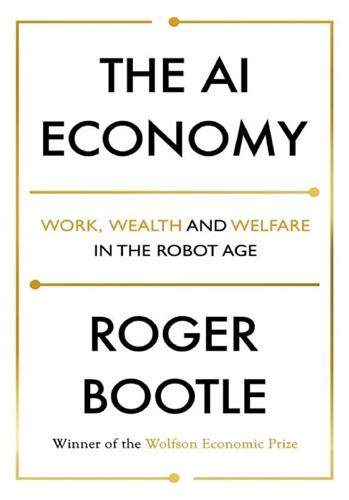
The AI Economy: Work, Wealth and Welfare in the Robot Age
by
Roger Bootle
Published 4 Sep 2019
The internet has given birth to enormously profitable and influential corporations with startlingly small workforces. (I take up these issues in Chapter 6.) But a more favorable implication is the continuation of stable inflation at higher rates of economic activity and lower rates of unemployment. (If you have a taste for jargon, in Economese this is referred to as a flattening of the Phillips Curve, which is the curve depicting the relationship between inflation and unemployment.) The pace of economic growth I argued in Chapter 1 that the notion that there has recently been a profound and long-lasting slowdown in productivity growth was unconvincing. Quite apart from whatever opportunities are thrown up by robotics and AI, I fully expect the rate of increase of productivity growth to pick up from the low levels that have recently been registered in the developed world.
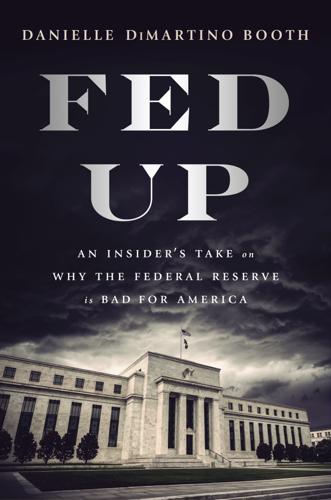
Fed Up: An Insider's Take on Why the Federal Reserve Is Bad for America
by
Danielle Dimartino Booth
Published 14 Feb 2017
I was convinced a monetary asteroid was heading in our direction, aimed directly at the American Dream. You could almost see them shaking their heads and thinking, Only two master’s degrees, poor girl. Probably nothing to be done . . . On paper, my coworkers at the Dallas Fed were more qualified than I was to analyze and predict the economy. Masters of the Phillips Curve, Okun’s Law, and the Taylor Rule, schooled in the stringent field of macroeconomics, they studied data to discern patterns for the benefit of the Federal Reserve decision-making process. They wore their PhDs like T-shirts. There was a distinct hierarchy: MIT, Harvard, Yale, Princeton, and the University of Chicago sat at the top, in that order.
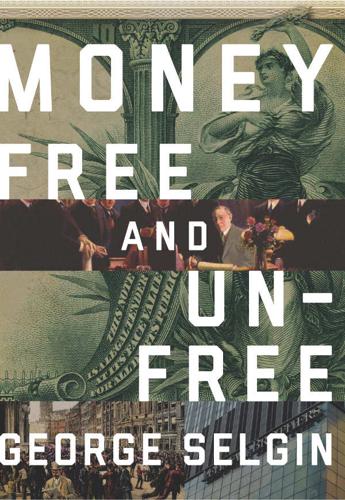
Money Free and Unfree
by
George A. Selgin
Published 14 Jun 2017
Many, including Alan Blinder (1998), Romer (1999), Thomas Sargent (1999), and Bernanke (2004), have regarded this “Great Moderation” of inflation and real output as evidence of a substantial improvement in the Fed’s conduct of monetary policy—a turn to what Blinder (1998: 49) terms “enlightened discretion.”18 Bernanke (2004), conceding that the high inflation in the 1970s and early 1980s was largely due to excessive monetary expansion aimed at trying to maintain a below-natural rate of unemployment, argues similarly that Fed authorities learned over the course of that episode that they could not exploit a stable Phillips curve; Romer (1999: 43) claims that, after the early 1980s, the Fed “had a steadier hand on the macroeconomic tiller.”19 The “enlightened discretion” view has, however, been challenged by statistical studies pointing to moderating forces other than improved monetary policy. A study by James Stock and Mark Watson (2002: 200; see also 2005) attributes between 75 percent and 90 percent of the Great Moderation in U.S. output volatility to “good luck in the form of smaller economic disturbances” rather than improved monetary policy.
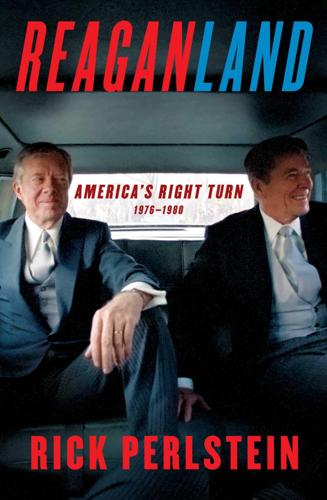
Reaganland: America's Right Turn 1976-1980
by
Rick Perlstein
Published 17 Aug 2020
Into the vacuum poured conservative economists, armed with panaceas. Many mainstream economists had been convinced Keynesianism was exhausted ever since Milton Friedman, in his 1967 American Economic Association presidential address, took on the “Phillips Curve,” the thesis positing an inverse relationship between inflation and unemployment. Faith in the Phillips Curve had meant that if unemployment threatened to rise to unacceptable levels, the Federal Reserve could simply act to speed up the economy by releasing more money into the system; and if inflation threatened to balloon, it could do the reverse, until the ideal mixture was obtained.
…
Howard, 484 Philadelphia (PA), 564–565, 790 Philadelphia Association of Christian Schools, 349 Philadelphia Enquirer, 340, 619 Philadelphia Plan, 164, 674 Philip Morris, 336 Philippines, 683 Phillips, G. Conoly, 253, 262 Phillips, Howard, 34, 35, 36, 38, 45, 71, 83, 96, 232, 234, 235, 350, 364, 387, 388, 471, 484, 489–490, 491, 495, 595, 801, 870 Phillips, Kevin, 27, 32, 33, 94 Phillips Curve, 279 Phillips Petroleum, 335 Phyllis Schlafly Report, 77 Pickle, Jake, 450 “Pink Sheet” (flyer), 78–79 Pioneer Fund, 386 Pipes, Richard, 44 Pittsburgh Press, 581 Plessy v. Ferguson, 561 Podhoretz, Norman, 171, 330, 505, 835 Politics—A Christian Viewpoint (film), 870 Poole, Robert, 754 Pope, Alexander, 312 population growth, of US, 421 Powell, Jody, 18, 63, 65, 91–92, 105, 293, 444, 537, 543, 563, 572, 573, 574, 588, 593–594, 634, 905 Powell, Lewis, 674 The Power of the Positive Woman (Schlafly), 180–181 Powers, Ron, 356, 879 PPWTT.

Model Thinker: What You Need to Know to Make Data Work for You
by
Scott E. Page
Published 27 Nov 2018
Craig MacKinlay. 2007. A Non-Random Walk Down Wall Street. Princeton, NJ: Princeton University Press. Lo, Andrew W. 2012. “Reading About the Financial Crisis: A Twenty-One-Book Review.” Journal of Economic Literature 50, no. 1: 151–178. Lucas, Robert. 1976. “Econometric Policy Evaluation: A Critique.” In The Phillips Curve and Labor Markets, ed. K. Brunner and A. Meltzer, 19–46. Carnegie-Rochester Conference Series on Public Policy 1. New York: Elsevier. Lucking-Reiley, David. 1999. “Using Field Experiments to Test Equivalence Between Auction Formats: Magic on the Internet.” American Economic Review 89, no. 5: 1063–1080.

How to Be a Liberal: The Story of Liberalism and the Fight for Its Life
by
Ian Dunt
Published 15 Oct 2020
You can find further discussion of some of the issues in this section in A Companion to the History of Economic Thought, edited by Warren J Samuels, Jeff E Biddle, and John B Davis. Chapters 26 and 27 are particularly good, but the book is also recommended for its discussion of Adam Smith and John Maynard Keynes. For a different, and more critical look at Friedman’s legacy, including his reputation on inflation, read Macroeconomics and the Phillips Curve Myth, by James Forder. The best work on the 2008 financial crash and the eurozone crisis, by some distance, is Crashed: How a Decade of Financial Crises Changed the World, by Adam Tooze. People tend to stay away from official reports, but the Final Report of the National Commission on the Causes of the Financial and Economic Crisis in the United States, by the Financial Crisis Inquiry Commission, is a truly majestic work – as readable as any popular economics book and freely available online at https://www.govinfo.gov/content/pkg/GPO-FCIC/pdf/GPO-FCIC.pdf.

The Euro and the Battle of Ideas
by
Markus K. Brunnermeier
,
Harold James
and
Jean-Pierre Landau
Published 3 Aug 2016
If, instead, prices are sluggish to respond (they are “sticky”), then quantities—like GDP and employment—also respond. In that case, an increase in prices is accompanied by a decrease in unemployment. This negative relationship between inflation and unemployment is known among economists as the Phillips curve. The more flexible the prices, the more a given boost to demand is reflected in higher prices rather than higher employment. Thus, in a world with quite flexible prices, government spending multipliers are likely to be quite small, and vice versa. The Classical Rebuttal The original Keynesian analysis was, however, soon challenged on various grounds.
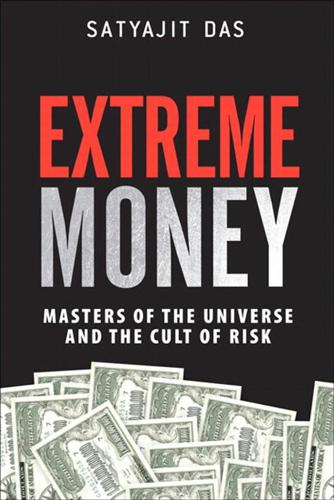
Extreme Money: Masters of the Universe and the Cult of Risk
by
Satyajit Das
Published 14 Oct 2011
The intellectual struggle between Keynes and Friedman shaped the age of extreme money. Economic Politics After the Great Depression, Keynesian demand management required economists to adjust taxation and government spending to engineer desired growth levels. There was an accepted trade-off between inflation and unemployment, known as the Phillips curve, named after a New Zealand economist. The Chicago School favored free markets and limited regulation. Wealth redistribution would take capital from productive sectors, transferring it to less productive activities. There was deep ambivalence about governments. Minimizing taxes would starve the beast, decreasing its ability to fund unproductive programs.
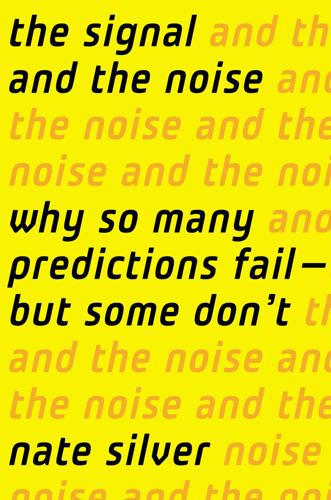
The Signal and the Noise: Why So Many Predictions Fail-But Some Don't
by
Nate Silver
Published 31 Aug 2012
Perry, “Consumer Confidence Is a Lagging Indicator: Expect Post-Recession Gloom Through 2010,” Seeking Alpha, October 29, 2009. http://seekingalpha.com/article/169740-consumer-confidence-is-a-lagging-indicator-expect-post-recession-gloom-through-2010. 37. Robert Lucas, “Econometric Policy Evaluation: A Critique,” and Karl Brunner and A. Meltzer, “The Phillips Curve and Labor Markets,” Carnegie-Rochester Conference Series on Public Policy, American Elsevier, 1976, pp. 19–46. http://pareto.uab.es/mcreel/reading_course_2006_2007/lucas1976.pdf. 38. C.A.E. Goodhart, “Problems of Monetary Management: The U.K. Experience,” Papers in Monetary Economics, Reserve Bank of Australia, 1975. 39.

The Rise and Fall of American Growth: The U.S. Standard of Living Since the Civil War (The Princeton Economic History of the Western World)
by
Robert J. Gordon
Published 12 Jan 2016
Cambridge, UK/New York: Cambridge University Press, pp. 172–217. Gordon, Robert J. (2012a). Macroeconomics, 12th ed. Boston, MA: Pearson/Addison-Wesley. Gordon, Robert J. (2012b). “Is U.S. Economic Growth Over? Faltering Innovation and the Six Headwinds.” NBER Working Paper 18315, August. Gordon, Robert J. (2013). “The Phillips Curve Is Alive and Well: Inflation and the NAIRU during the Slow Recovery,” NBER Working Paper 19360, September. Gordon, Robert J. (2014b). “A New Method of Estimating Potential Real GDP Growth: Implications for the Labor Market and the Debt/GDP Ratio,” NBER Working Paper 20423, August. Gordon, Robert J., and Dew-Becker, Ian. (2008).